Archive for the ‘Threats from Poaching and Poisoning’ Category
Sunday, July 21st, 2013
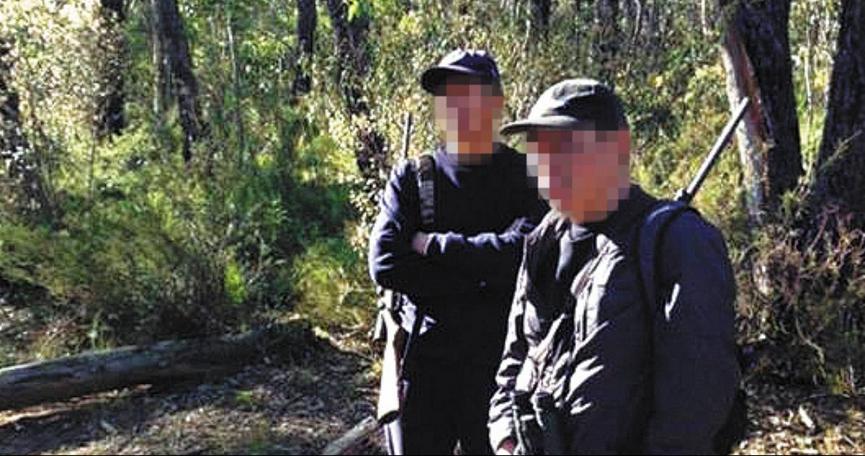 Illegal poachers caught in the Blue Mountains World Heritage Area on 15th June 2013
[Photo by bushwalker Darren Drew in Tigersnake Canyon, Wollemi National Park, at a time when 500 runners were participating in a marathon in the area] Illegal poachers caught in the Blue Mountains World Heritage Area on 15th June 2013
[Photo by bushwalker Darren Drew in Tigersnake Canyon, Wollemi National Park, at a time when 500 runners were participating in a marathon in the area]
.
<< Two men were reported to be illegally hunting in NSW’s biggest natural tourist attraction, the Greater Blue Mountains World Heritage Area.
Blackheath bushwalker Darren Trew said he came across the hunters on a canyoning trip with friends on Saturday June 15. Over that weekend 500 runners from across the state had converged in that same region to participate in the second Glow Worm Tunnel Marathon, near Newnes. Mr Trew, who saw the men with their weapons, reported the matter to Lithgow Police, to the Game Council and to the National Parks and Wildlife Service.
Mr Trew:
“It’s madness. It was quite a shock to discover after 20 or more years of bushwalking. It’s quite disturbing, they said they were hunting deer and I told them they were not allowed to be here with rifles, it’s illegal, I called the police and they walked away.”
.
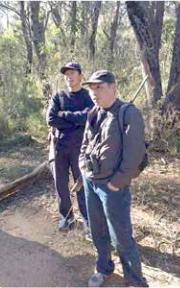 Photo by High & Wild Photo by High & Wild
.
Mr Trew’s group took a photo of the men and said later that day about 20 people turned up to enjoy Tigersnake Canyon.
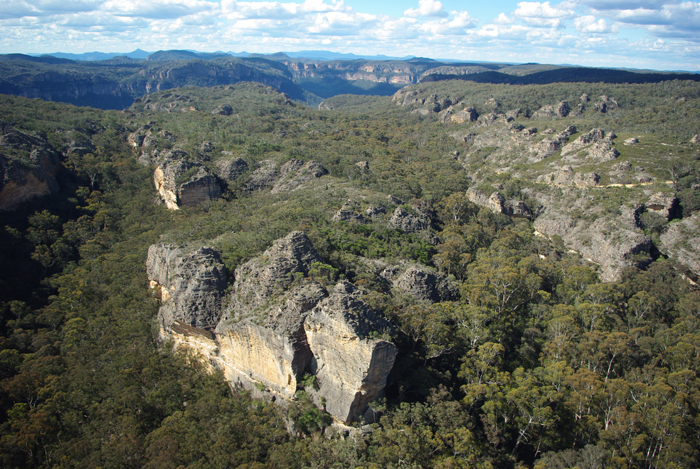 Glow Worm Tunnel Area, Wollemi National Park
Greater Blue Mountains World Heritage Area
[Source: NSW Government, ^http://www.environment.nsw.gov.au/nationalparks/parkWalking.aspx?id=N0051] Glow Worm Tunnel Area, Wollemi National Park
Greater Blue Mountains World Heritage Area
[Source: NSW Government, ^http://www.environment.nsw.gov.au/nationalparks/parkWalking.aspx?id=N0051]
.
Glow Worm Tunnel Marathon race director Sean Greenhill of the Wentworth Falls based Mountain Sports said he was very concerned by the reports.
“It’s extremely disturbing to think that two men with rifles were hunting in a national park only a couple of kilometres from where 500 runners were conducting a legitimate activity in the same park — odds are small but the potential implications are horrifying. Mountain Sports doesn’t support hunting in any national park — why create such a dangerous precedent?”
.
“Unfortunately, some hunters have heard “you can now hunt in national parks” and assume it’s a free-for-all. With the Game Council promoting NSW as ‘the place to hunt’, this is only going to get worse.”
~ National Parks Association of NSW spokesman, Justin McKee
.
National Parks Association of NSW spokesman, Justin McKee:
“The incident highlights that Premier Barry O’Farrell’s promise that safety will be paramount does not definitely rule out the risk of illegal hunting in highly visited areas, including those where hunting is not allowed like the Greater Blue Mountains World Heritage Area.
Hunting in national parks is bad policy, it’s bad for tourism, public safety and the environment. It ruins the international reputation of our national parks brand that has taken 50 years to build up. Unfortunately, some hunters have heard ‘you can now hunt in national parks’ and assume it’s a free-for-all.”
.
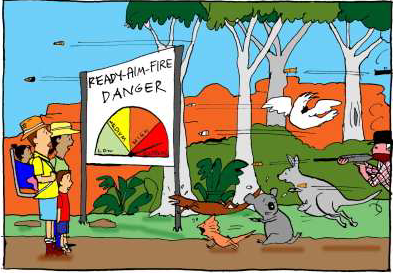
A spokesman for Environment Minister Robyn Parker said the minister didn’t normally comment on operational issues but “obviously hunting in national parks is illegal and an investigation is ongoing”… [Ed: There is no public report that they caught, so it was a free-for-all that day]
[Source: ‘Armed hunters spotted in Blue Mountains world heritage area’, 20130626, by B. C Lewis, Blue Mountains Gazette (newspaper), page 7, ^http://www.bluemountainsgazette.com.au/story/1598489/armed-hunters-spotted-in-blue-mountains-world-heritage-area/; the lead photo of the two hunters was taken near Tigersnake Canyon and posted on Facebook 20130622]
.
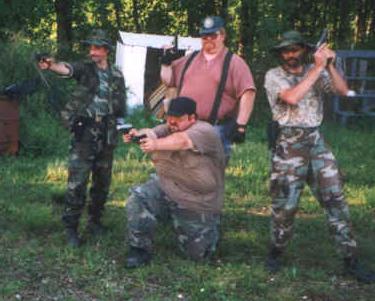 Weekend Warriors
all camoued up and ready to hunt! Weekend Warriors
all camoued up and ready to hunt!
.
Game Council NSW ‘Code of Practice’ (so-called)
.
<< Ethical, safe and responsible hunting
.
- Awareness of relevant legislation
It is the responsibility of the holder of a NSW Game Hunting Licence to be aware of and comply with all relevant legisation relating to hunting, animal welfare and the use of firearms.
- Safe handling of firearms
Where firearms are used, the rules for safe handling set out in the NSW Firearms Safety Awareness handbook, published by or under the authority of the Commissioner of Police, must be complied with at all times.
- Permission required to enter land
A NSW Game Hunting Licence does not automatically authorise the holder of a licence to hunt on any land. The holder of a Game Hunting Licence must not hunt on any land without the express authority of the occupier of the land.
- Target identification and safety
A game animal must not be fired at unless it can be clearly seen and identified, and the shot taken poses no discernible risk of injury to any person or damage to any property.
- Obligation to avoid suffering
An animal being hunted must not be inflicted with unnecessary pain. To achieve the aim of delivering a humane death to a hunted animal:
- it must be targeted so that a humane kill is likely;
- it must be shot within the reasonably accepted killing range of the firearm and ammunition or bow being used; and
- the firearm, ammunition, or bow and arrow, must be such as can be reasonable expected to humanely kill and animal of the target species.
- Lactating female with dependent young
If a lactating female is killed, every reasonable effort must be made to locate and kill any dependent young.
- Wounded animals
If an animal is wounded, the hunter must take all reasonable steps to locate it so that it can be killed quickly and humanely.
- Use of dogs
Dogs and other animals may be used to assist hunters, but only if:
- their use is not in contravention to the Prevention of Cruelty to Animals Act 1979; and
- their use is with the permission of the occupier of the land concerned. >>
.
[Source: Game Council of NewSouth Wales, ^http://www.gamecouncil.nsw.gov.au/portal.asp?p=CodeofPractice]
.
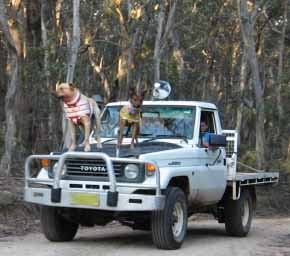 Game Council Code of Practice:
“Use of (pig) dogs: Dogs and other animals may be used to assist hunters, but only if: Game Council Code of Practice:
“Use of (pig) dogs: Dogs and other animals may be used to assist hunters, but only if:
-
their use is not in contravention to the Prevention of Cruelty to Animals Act 1979; and
-
their use is with the permission of the occupier of the land concerned.”
.
May 2012: NSW Government allows hunting in national parks
.
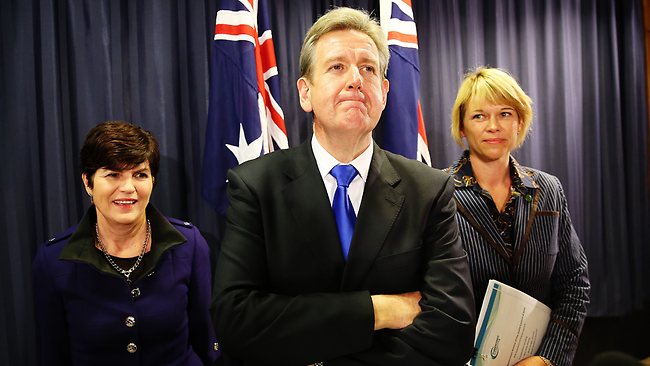 National Park’s chief custodian Environment Minister Robyn Parker,
with NSW Premier Barry O’Farrell and Primary Industries Minister Katrina Hodgkinson
announcing that shooting will be legal in national parks.
[Source: Photo by Craig Greenhill, The Daily Telegraph] National Park’s chief custodian Environment Minister Robyn Parker,
with NSW Premier Barry O’Farrell and Primary Industries Minister Katrina Hodgkinson
announcing that shooting will be legal in national parks.
[Source: Photo by Craig Greenhill, The Daily Telegraph]
.
<< Hunting will be seen in 79 of the state’s national parks as part of a deal struck by the government (with the Christian Democrats and the Shooters and Fishers Party) last night in exchange for the sale of the state electricity generators.

New South Wales Premier, Barry O’Farrell: “We promised to revitalise the state’s economy, we promised to put additional funding into infrastructure… and the decision was based on the public interest and political realites.”
Despite O’Farrell’s pre-election promise that he would not open up national parks to shooters as hunting reserves, the Premier said that he has not broken his promise.
“There is a big difference between hunting reserves and restricted shooters under the direction of the Minster of the Environment assisting National Parks and Wildlife staff with the culling of feral animals.”
O’Farrell’s famous last words:
“Shooting will be safely and professionally run by the Game Council.”
.
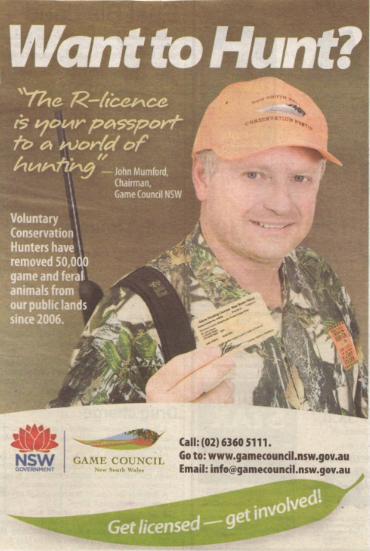
In exchange for the hunting deal Premier O’Farrell will now be able to sell off the state’s generators as recommended by the State’s Commission of Enquiry…>>
[Source: ‘Premier O’Farrell to allow hunting in NSW national parks’, 20120531, by Amy Taylor-Kabbaz, Australian Broadcasting Corporation, ^http://www.abc.net.au/local/stories/2012/05/31/3515093.htm]
.
ABC radio interview by radio presenter Adam Spencer with Premier Barry O’Farrell, 20120531:

Listen to ABC radio interview
.
[Ed: So a month later on 27th June 2012, the NSW Coalition Government, the Shooters and Fishers Party and the Christian Democratic Party voted in changes to legislation that allows amateur, recreational hunting to occur in NSW National Parks.]
.
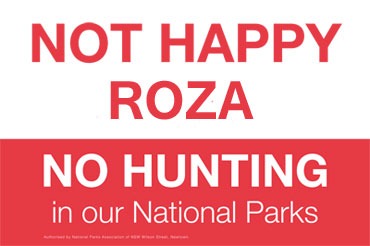 Blue Mountains protest campaign against the NSW Government’s local representative, Roza Sage MP,
and her undemocratic support for hunting in national parks across New South Wales. Blue Mountains protest campaign against the NSW Government’s local representative, Roza Sage MP,
and her undemocratic support for hunting in national parks across New South Wales.
.
Two weeks later, on Sunday 15th July 2012, about 400 people rallied in Katoomba in the Blue Mountains to protest against Barry O’Farrell’s decision and to tell local Blue Mountains MP Roza Sage that they oppose the Government’s decision to allow hunting in our National Parks.
.
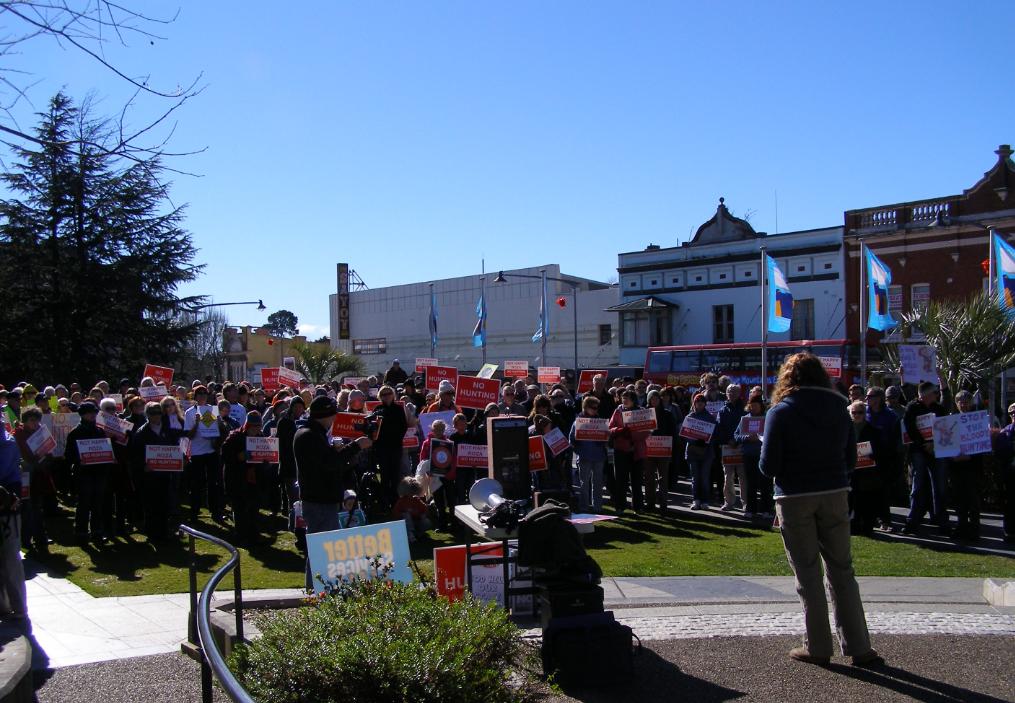 No Hunting in National Parks Rally at Katoomba
[Photo by Editor 20120715, photo © under ^Creative Commons] No Hunting in National Parks Rally at Katoomba
[Photo by Editor 20120715, photo © under ^Creative Commons]
.
Kangaroo shot with arrow in Kosciuszko National Park
.
 Conservation Hunting Conservation Hunting
.
This kangaroo was discovered, still alive, two days ago near Log Bridge Creek picnic and camping ground on the Blowering Foreshore inside the Kosciuszko National Park, with the arrow right through its upper body.
<< An illegal hunter shot a kangaroo with an arrow and left it wounded near a camping area in the Kosciuszko National Park.
The roo was discovered yesterday near the Log Bridge Creek picnic and camping area on the Blowering Foreshore and was put down by parks officers.
NSW National Parks and Wildlife Service regional manager Dave Darlington:
“This roo spent an unknown time with an arrow pierced fully through its body and the cruelty and atrocity of this act is horrific. This is a senseless and disgusting act and we hope to prosecute the person responsible to the furthest limits of our legislation.”
Anyone with information is urged to phone NPWS on (02) 6947 7000 or Crime Stoppers on 1800 333 000.
.
Harming protected wildlife carries penalties of $11,000 an incident and up to six months jail while having a bow and arrow in a National Park also carries a fine of up to $3,300.
.
The National Parks and Wildlife Service had to euthanise a kangaroo.
[Source: ‘Kangaroo found shot with arrow’, 20130703, ABC News, ^http://www.abc.net.au/news/2013-07-03/kangaroo-found-shot-with-arrow/4796178]
.
National Parks and Wildlife Service does drug deal with hunters
.
<< A National Parks and Wildlife Service ranger was stood down for allegedly letting hunters into the Paroo-Darling National Park in the state’s far west in exchange for drugs.
The government confirmed there had been 12 investigations of illegal hunting in national parks in the past year.
The state government is soon to decide whether to press ahead with its plans to allow shooting in national parks. Allowing hunting in national parks was agreed to in a deal between the government and the Shooters Party so the Shooters would pass the $5 billion sale of the ports through the upper house. Premier Barry O’Farrell is expected to take a risk assessment on the hunting plan to cabinet in the next fortnight at the same time as a review by former senior public servant Steve Dunn on the structure of the shooting regulator, the Game Council.
The Dunn report was ordered after the acting chief executive of the Game Council was allegedly caught illegally shooting on the eve of the intended opening of national parks to shooters. Mr Dunn’s report will recommend that all shooting advocates and members of the Shooters Party no longer serve on the board of the Game Council, because of a clear conflict between the roles of advocate and regulator. [Ed: Download the Dunn Report at the end of this article]
Illegal hunters trespassing on private land in metro Sydney
.
<< Hunters using guns and crossbows have been illegally entering private properties in metropolitan Sydney, forcing ecologists to abandon night-time observation of frogs and owls for fear of being shot.
Incidents have occurred in the past fortnight in north-west Sydney, just a few kilometres from housing, according to UBM Ecological Consultants’ Judith Rawling. The situation has become dangerous for her staff, she said, and she attributed the surge in illegal hunting to publicity over the looming introduction of hunting in national parks.
Local environment planning drafts for the Hills Shire have been released, prompting residents of bush blocks to apply for subdivisions.
”Before you put in a [development application] you have to put in a flora and fauna survey … That’s why we are coming across these shooters. This is really dangerous,” she said.
Game Council NSW was unavailable for comment.
Greens MP and firearms spokesman David Shoebridge:
“If local councils, the police and Game Council can’t control illegal hunting in the Hills Shire, there is no way on earth they will be able to regulate amateur hunting in far-flung national parks.”
.
[Source: ‘Hunters prowl across private land near city’, 20130630, by Kirsty Needham, Sydney Morning Herald (newspaper), ^http://www.smh.com.au/environment/animals/hunters-prowl-across-private-land-near-city-20130629-2p3v4.html]
.
Hunters shoot at a farmer near Game Council headquarters
.
May 2013:
.
<< Orange police are looking for two men who shot at a Springside farmer yesterday morning when he caught them illegally hunting on his property. [Ed: Springside is a community just south of Orange in central western New South Wales, where the Game Council of NSW has its headquarters].
The 43-year-old landowner was bailed up at gunpoint and ordered to drop his mobile phone which he was using to take a photograph of the offenders’ number plate. One of the gunmen smashed the phone and fired a warning shot at the man’s feet.
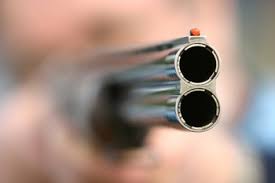
The farmer had challenged the men after he found them on his property hunting kangaroos. [Ed: Conservation Hunting?]
Canobolas Local Area Command Inspector Dave Harvey said the two men were less than four metres away from the farmer when they shot at him.
A command post was set up at Springside shortly before 10am where five police, detectives and the forensics special group combed through bushland in the Canobolas State Forest for two hours looking for the men. One of the men was wearing a grey top and black tracksuit pants. He is described as Caucasian, about 180cm tall, thin build with short dark hair and is between 17 and 24 years old. They were driving a white Subaru Outback.
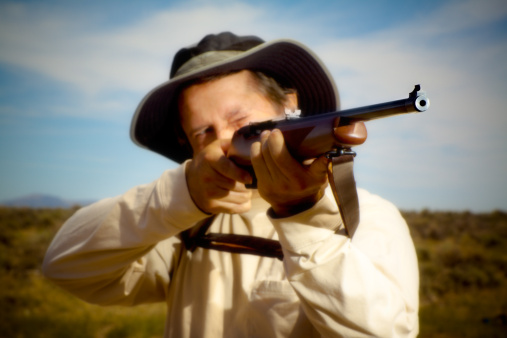
June 2013:
.
<< Orange police have charged an 18-year-old man over last month’s shooting at Springside. The man is believed to be one of two people who shot at a farmer while illegally shooting on his property on May 21 at around 9.30am.
The alleged shooter was arrested in Orange’s central business district at around 11.50pm yesterday. Yesterday afternoon police obtained a search warrant for his Moad Street apartment where they found a number of items which police believe may be associated with the gun used in the shooting. Canobolas Local Area Command Acting Inspector Brenden Turner said police had not located the firearm. >>
.
[Source: ‘Hunters shoot at property owner’, 20130522, by Nicole Kuter, Central Western Daily (Orange-based newspaper),^http://www.centralwesterndaily.com.au/story/1517209/hunters-shoot-at-property-owner/; and ‘Hunter Police get their man: charges over hunting shooting’, 20130627, by journalist Tracey Prisk, Central Western Daily, ^http://www.centralwesterndaily.com.au/story/1599702/police-get-their-man-charges-over-hunting-shooting/?cs=103]
.
NSW Game Council bosses above the law?
.
<< The state government’s plan to allow hunting in national parks is in turmoil after the acting head of the Game Council was stood down on suspicion of illegal hunting.
The council is the body that will issue shooting licences under the scheme. Its acting chief executive, Greg McFarland was suspended on Tuesday night – along with a colleague – by the Primary Industries Minister, Katrina Hodgkinson, after Fairfax Media learnt of a police investigation into an incident near Mount Hope in central west NSW.
 Game Council’s acting chief executive, Greg McFarland
is currently the subject of continuing investigations
[Source: ‘Game Council to be abolished’, 20130704, by Sean Nicholls, Sydney Morning Herald State Political Editor Game Council’s acting chief executive, Greg McFarland
is currently the subject of continuing investigations
[Source: ‘Game Council to be abolished’, 20130704, by Sean Nicholls, Sydney Morning Herald State Political Editor
http://www.smh.com.au/nsw/game-council-to-be-abolished-20130704-2pdte.html]
.
<< Rural crime investigators confirmed they are looking into claims of illegal hunting and trespass and the inhumane killing of a feral goat. They plan to interview Mr McFarland…
At the centre of the investigation is a Game Council vehicle that was seen being driven through a national park without permission before allegedly breaking a fence and entering the privately-owned Karwarn cattle station in pursuit of a male goat with ”trophy horns”.
.
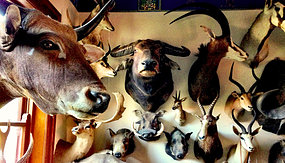 The Hunting Party
(Photo by Louie Eroglu) The Hunting Party
(Photo by Louie Eroglu)
.
According to photographs taken by the owner of the 25,000-acre property, Diane Noble, the goat was shot in the gut – an act that contravenes the council’s own guidelines on humane, ”single shot” kills. Hunters sometimes avoid shooting a goat in the head to ensure the skull and horns can be hung as a trophy.
The incident happened on December 28 at the Noble’s Karwarn station, 110 kilometres south of Cobar. According to Ms Noble, the pair were confronted by a group of hunters who had paid to shoot at Karwarn. To access Karwarn, the pair had to drive through the Yathong Nature Reserve, run by the National Parks and Wildlife Service. A parks source confirmed they did not have appropriate permission to do so.
.
“If local councils, the police and Game Council can’t control illegal hunting in the Hills Shire, there is no way on earth they will be able to regulate amateur hunting in far-flung national parks.”
~ Greens MP and firearms spokesman David Shoebridge
.
..The suspensions call into question the O’Farrell government’s insistence that shooting will be safely and professionally run by the Game Council, which will issue licences and monitor compliance when shooting begins on March 1. Critics said the government must now reconsider its deal with the Shooters and Fishers Party to put the council in charge or abandon hunting in national parks altogether.
Steve Turner, the assistant general secretary of the Public Service Association, which represents park rangers, said: ”How can anyone have faith that hunting in national parks will be run safely? Imagine what’s going to happen when the rogues get going.”
The scandal comes a month after a risk assessment written by Premier Barry O’Farrell’s own department emerged, warning of a ”major risk” that bushwalkers and parks staff will be killed or seriously injured.
Ms Noble said she did not want to prejudice the investigation but was angered by the apparent conduct. ”The Game Council is supposed to promote ethical hunting. They shot the goat through the guts and that’s not ethical,” she said. ”The animal should be shot once in the head or the heart and lungs for a quick kill.” >>
.
[Source: ‘Game boss suspended over illegal hunt claim’, 20130123, by Heath Aston (political reporter), Sydney Morning Herald, ^http://www.smh.com.au/nsw/game-boss-suspended-over-illegal-hunt-claim-20130122-2d5nn.html]
.
July 2013: Time to Wind Up the Game Council racket
.
Dunn’s Review into the Governance of the Game Council was commissioned by the Government after an internal investigation into allegations that a senior member of the Council had been involved in the inhumane killings of the goat in Western NSW.
.
<<On Thursday 4 July 2013 the NSW Government announced it will implement the key changes to Game Council NSW recommended by the independent Governance Review of the Game Council of NSW by Steve Dunn, popularly referred to as The Dunn Report.
The changes are designed to improve the functions previously carried out by Game Council NSW and also acknowledge hunting as a legitimate recreational activity.
The report found that Game Council NSW had an ‘inherent conflict associated with its functions to both represent the interests of hunters, and to regulate their activities’.
Therefore the NSW Government said it will immediately take the following actions:
- Transfer the licensing, regulatory, enforcement, education and policy functions into the NSW Department of Primary Industries (DPI); and
- Establish an advisory Game Board that will undertake stakeholder engagement and representation, advocate hunting, advise on research priorities and commission research, and provide independent advice to Government.
The Director General of NSW Trade & Investment, Mr Mark Paterson AO, will become the Division Head of the Game Council Division in the interim to oversee the integration of functions into DPI.
The NSW Government also announced it will immediately suspend hunting in all 400 State forests, pending the transfer of functions and the outcome of a risk assessment. This means that individuals with written permission to hunt on declared public land areas such as State forests and Crown Lands must no longer do so and must abide by the suspension until further advised.
Game Council and the Forestry Corporation of NSW will be contacting licence holders who have booked Written Permissions as soon as possible. Advice is also being sought from the NSW Government on the status of licensing arrangements.
Game Bird Management regulatory functions will continue to be undertaken by the Office of Environment and Heritage in 2013 and will transfer to DPI in 2014.
.
Game Council NSW Media Statement
.
<<On Thursday 4th July 2013, the Minister for Primary Industries announced the dissolution of Game Council NSW as a result of recommendations made following the NSW Government’s governance review.
The NSW Government has suspended hunting in all NSW State forests, pending a new risk assessment. All issued Written Permissions are now invalid. Game Council and the Forestry Corporation of NSW will attempt to call all licence holders with bookings to confirm cancellation of their permits in the coming week.
Game Council is committed to working with the NSW Government as the report recommendations are implemented and will also be working closely with NSW game hunting licence holders to minimise the impact of interim arrangements. >>
[Source: Game Council NSW website, ^http://www.gamecouncil.nsw.gov.au/]
.
..Minister for Primary Industries (DPI), Katrina Hodgkinson MP said nominees for the board would be ministerially appointed based on merit and all existing 21 staff under the current Games Council would be transfered to the new structure under the DPI.
She said key in her decision to support Steve Dunn’s report recommendations was its finding that “more than a decade after it was established the Game Council has no overarching governance framework; lacks a strategic planning framework; lacks some of the skills, tools and resources to ensure effective compliance with its regulatory framework; has no internal regulatory compliance program, has no approved enterprise-wide risk management framework and has an inadequate policy framework”.
“I can’t just stand by and allow that to continue – I take full responsibility for the changes,” Ms Hodgkinson said.
She said one of her primary concerns was for staff employed in the area of compliance and their safety, but she also saw the need to restore confidence in the public in this area. >>
.
COMMENT by ‘Dickytiger’ 20130705:
.
“Good move. The Game Council was just a Shooters Party lurk, looking after their mates.
Hunting feral animals is vital, but it doesn’t require a crony bureaucracy to do it.”
.
[Source: ‘Game over as hunting suspended’, 20130704, by Andrew Norris, The Land (rural newspaper), ^http://www.theland.com.au/news/agriculture/general/news/game-over-as-hunting-suspended/2663149.aspx?storypage=0]
.
Game Council NSW to be abolished
.
<< Amateur hunting in NSW forests will be suspended until at least October following the damning findings of a review into the Game Council of NSW.
As a result of the review, by retired public servant Steve Dunn, the Game Council of NSW will be abolished and responsibility for licensing of amateur hunters transferred to the Department of Primary Industries, the state government announced on Thursday.
The concerns raised in the review have led the government to announce the suspension of all amateur hunting in state forests until governance issues identified within the council are resolved.
In a simultaneous announcement, Environment Minister Robyn Parker revealed the introduction of amateur hunting to national parks will proceed in October, but on a trial basis in 12 parks. Pending the results, hunting may be rolled out in up to 75 parks and reserves as previously announced by the government under a deal with the Shooters and Fishers Party.
Ms Parker said the rules for shooting in national parks would be significantly different to those in place for state forests. Shooters would be closely supervised by National Parks and Wildlife staff in all areas where shooting takes place, which will be closed to visitors for the duration. Shooting will not take place during school holidays.
Additionally, no one under 18 would be allowed to participate, and use of bows or black powder muskets would be prohibited.
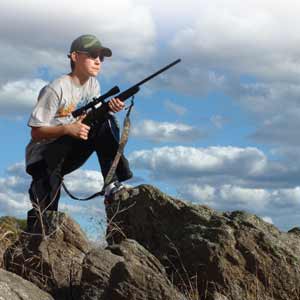
The Dunn report, released on Thursday, slams governance the Game Council, which it says is ‘‘deeply embedded in politics’’.
In a scathing assessment, Mr Dunn says public safety ‘‘does not receive a high level of attention’’ in planning documents prepared by the organisation, which is responsible for overseeing licensing of amateur shooters in NSW.
He says the council has been unable to resolve the ‘‘inherent conflict of interest’’ between representing the interests of hunters and regulating their activities in NSW.
The report says the council has ‘‘achieved significant results’’ since its establishment in 2002. But they have been achieved ‘‘at the taking of governance risks not normally associated with government bodies.’’
It concludes: ‘‘Allowing the Game Council to continue on its current path is not an option.’’
The review was ordered by Mr O’Farrell in March after an investigation found alleged illegal hunting by two Game Council senior employees on a property in outback NSW.
.. The IAB report also identified ‘‘possible breaches of Game Council policies and procedures, information which raises questions about governance procedures within the Game Council’’.
Sensitivity over the allegations were heightened by the decision by Mr O’Farrell to open NSW national parks to amateur hunting.
The decision was part of a deal between the government and the Shooters and Fishers Party, which holds the balance of power in the upper house, over passage of electricity privatisation legislation.
Mr Dunn’s report notes that the Game Council was established in 2002 because of the ‘‘influence and power’’ of the Shooter and Fishers Party. He says this power has resulted in the creation of an organisation lacking in accountability.
Shooters and Fishers Party MP Robert Brown is a former Game Council chairman.
More than a decade after the Game Council was established, a strategic plan has yet to be finalised and made public, Mr Dunn notes. His report recommends the 18-member Game Council be replaced by a NSW Game Board of not more than eight members.
It would be subject to control of the department and be responsible for representing the interests of hunters, promoting feral animal control and providing policy advice to government.
However, licensing, education and law enforcement functions – currently the chief role of the Game Council – would be handed to a government department, along with policy and legislation functions. Reaction is being sought from Game Council chief executive Brian Boyle and the Shooters and Fishers Party. >>
[Source: ‘Game Council to be abolished’, 20130704, by Sean Nicholls, Sydney Morning Herald State Political Editor, ^http://www.smh.com.au/nsw/game-council-to-be-abolished-20130704-2pdte.html]
.
Hunting on NSW public land will be banned for at least the next two months and the Game Council will be disbanded. Yet the NSW Government is going ahead with its plan to allow volunteer hunters in national parks as part of a pest control program.
It’s a bold decision, which the Shooters and Hunters Party says even it had no idea was coming. This decision stems from the results of the Government commissioned Dunn Review into the governance of the Game Council. >>
.
Dunn’s Scathing Review
.
Dunn’s Review into the Governance of the Game Council was commissioned by the Government after an internal investigation into allegations that a senior member of the Council had been involved in the inhumane killings of a goat in Western NSW.
The final report acknowledged the Council had achieved many things in its years of operation but for the most part the report was undeniably shocking leaving the Government no choice but to take action.
Its author Steve Dunn questions how things got so bad. He found the Council has no overarching governance framework, lacks the skills and resources to ensure effective compliance and found breaches of record keeping and privacy legislation. The Game Council is a statutory body established under the Game and Feral Animal Control Act – and it should be subject to the control and direction of the Minister for Primaries Industries.
But Premier of NSW, Barry O’Farrell, says the Council strayed.
“Essentially it made the point that the Game Council was both the promoter and the operator in relation to hunting activities across NSW as well as the regulator,” he said. “That posed an unacceptable risk to the Government.”
The review found the Game Council has its fingers deep in the political pie, with the slices getting bigger thanks to the influence and power of the Shooters and Fishers Party in the NSW Legislative Council.
Steve Dunn wrote, “the Game Council has no parent and no siblings, no one wants to adopt it and no one really wants a close relationship with it, because of the politics.”
Shooters Party MP, Robert Brown, says he hasn’t yet had time to fully consider the O’Farrell Government’s announcement. But he says he’s personally disappointed the Game Council has been abolished and will be seeking a meeting with the Premier before he forms the Party’s response.
The Game Council will be replaced by an advisory board of no more than eight members, which will each be selected on merit, rather than being appointed by various organisations. The board will be in charge of advocacy. The regulatory aspect of the Council will now go to Department of Primary Industries.
Minister Katrina Hodgkinson says no Games Council jobs will be lost in the transition and, until that situation is fixed, shooting in state forests has been put on hold.
“It’s a hard thing to have to go through and accept a report which is so critical of an organisation. But we’ve got an opportunity now to make things right and make things good. We’ll be transferring the operations of the Game Council over into the Department of Primary Industries, which does have excellent governance.”
The temporary shooting stoppage will affect 400 state forests and 2 crown lands. However the Government is going ahead with its pest control program National Parks.
A trial in 12 parks will commence in October. The Environment Minister Robyn Parker says it will be regulated and managed by the National Parks and Wildlife Service, and there will be strict controls and supervision.
The Minister acknowledged the 20,000 hunters in NSW that assist the Government with pest animal control in NSW.
“These hunters have played an important role in pest eradication.”
The Game Council and the Shooters and Fishers Party have been contacted for comment.
A one time candidate of the Shooters and Fishers Party says he’s always had concerns about the way the Game Council has been run. Jim Pirie is from Mudgee in New South Wales and has over 60 years of hunting experience under his belt, he was also a one-time candidate of the Shooters and Fishers Party. These days he’s the owner of a gun shop in town and he’s also the Treasurer of the Cudgegong Valley Hunters Club.
He spoke with the ABC’s Angela Owens frankly about his concerns over opening National Parks up to hunters and the growing power base of the Game Council.
.
“Unfortunately the architects of all this are very egotistical, arrogant men and they won’t take advice from anybody,” he said. “It’s either their way or the highway.”
.
“(Someone) stood up at a hunting organisation meeting one day and said there was no nepotism, no cronyism in the Game Council, well that was a joke.
“They appointed the people that they wanted and this at the end of the day was to the determent of the organisation.” >>
.
[Source: ‘NSW Government abolishes Game Council’, 20130705, by Skye Manson, Lisa Herbert and Angela Owens, ABC Rural, ^http://www.abc.net.au/news/2013-07-05/nrn-game-council-gone/4800282]
.

.
July 2013: Cowboy shooters are finished in NSW
.
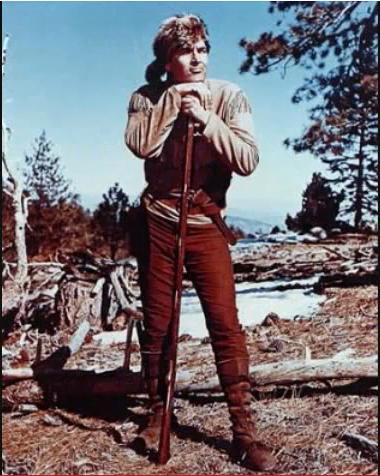 Daniel Boone was a big man Daniel Boone was a big man
.
“DANIEL BOONE”
lyrics by Vera Matson, music by Lionel Newman
.
<< Daniel Boone was a man,
Yes, a big man!
With an eye like an eagle
And as tall as a mountain was he!
Daniel Boone was a man,
Yes, a big man!
He was brave, he was fearless
And as tough as a mighty oak tree!
From the coonskin cap on the top of ol’ Dan
To the heel of his rawhide shoe;
The rippin’est, roarin’est, fightin’est man
The frontier ever knew!
Daniel Boone was a man,
Yes, a big man!
And he fought for America
To make all Americans free!
What a Boone! What a doer!
What a dream come-er-true-er was he!
Daniel Boone was a man!
Yes, a big man!
With a whoop and a holler
he c’d mow down a forest of trees!
Daniel Boone was a man!
Yes, a big man!
If he frowned at a river
In July all the water would freeze!
But a peaceable, pioneer fella was Dan
When he smiled all the ice would thaw!
The singin’est, laughin’est, happiest man
The frontier ever saw!
Daniel Boone was a man!
Yes, a big man!
With a dream of a country that’d
Always forever be free!
What a Boone! What a do-er!
What a dream-come-er-true-er was he! >>
.
[Source: ‘DANIEL BOONE’, lyrics by Vera Matson, music by Lionel Newman, Twentieth Century Music Corporation, 1964, New York, NY, USA, ^http://www.danielboonetv.com/themesong.html]
.
The Game Council’s Cowboy Days Are Over
.
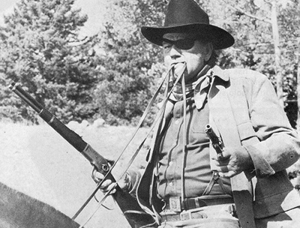
<< The cowboy days are over for the recreational shooting of feral animals in NSW. A damning exposé of what the hunting regulator, the Game Council of NSW, has been up to over the past decade- written by a senior public servant who grew up in rural England, familiar with gun safety – makes astonishing reading.
Steve Dunn describes a politically untouchable posse of gun wielding vigilantes, who enthusiastically set themselves the goal of stopping illegal hunting – despite this actually being the job of police. Dunn says the Game Council was acting beyond its statutory role, and with an inherent conflict of interest. Ultimately they posed an unacceptable risk to the government. The Game Council has now been disbanded by the O’Farrell government.
Boring paper pushing, policy making, analytical or investigations skills weren’t seen as important to this bunch of Wild West public servants. The top job prerequisite to become a game council officer was to be a hunter, and to promote hunting.
Left to their own devices by successive ministers, the game council roamed forest frontiers from its head office in Orange, apparently unconcerned about issues of public safety, promoting their own novel concept of ”conservation hunting”, and cloaked from government oversight.
The Game Council’s website last week boasted of a surge of dead animals last financial year: a ”staggering” 1.23 million animals killed on private land by its hunters, and 21,000 shot on public land. And that these figures meant a 70 per cent increase in its key performance indicator.
But Dunn says the council was confused about its role under the Act. It wasn’t supposed to be tallying carcasses, but instead developing plans for hunter safety, public land access, licensing, education, compliance of licensed hunters and research.
The council considered themselves to be outsiders to other government agencies, who reported the renegades to be combative, assertive, and too aligned with the interests of the hunters they were supposed to be regulating.
The review described a pariah that no other government department could love. If agencies are generally organised into clusters, with small agencies needing both a parent and siblings to survive, the game council was an orphan.
”The Game Gouncil has no parent and no siblings, no one wants to adopt it, and no one really wants a close relationship with it – because of politics,” Dunn wrote.
Established in 2002 under the Labor government, the council had its roots ”deeply embedded in politics”, and arose because of the importance of the Shooters & Fishers Party to the government of the day in the upper house when governments needed to get legislation passed.
.
The council complained it had an image problem in the wider community. But Dunn’s report considers it was a problem of the council’s own making.
.
Carrying private firearms in agency vehicles and hunting on the job are not a good look for public servants. Was it appropriate for the hunting regulator to be handing out promotional stress balls that say ”Stressed? Go conservation hunting”?
In the fallout from the Dunn Review, the Game Council’s regulatory, enforcement, licensing and policy roles have now been transferred to the department of primary industries. A separate advisory Game Board will be formed to represent hunters and advocate hunting.
As the government prepares to allow licensed volunteer shooters to be involved in supervised National Parks and Wildlife Service culls of feral animals in 12 national parks in October, the cowboys that once reigned are out. Strict guidelines for the culls, which will only be held when parks are closed to the public, stipulate: no night shooting, no dogs, no bows and arrows – and no shooting from horses. >>
.
[Source: ‘Cowboy shooters are finished in NSW’, 20130707, by Kirtsy Needham, Illawarra Mercury newspaper, ^ http://www.illawarramercury.com.au/story/1621471/cowboy-shooters-are-finished-in-nsw/]
.
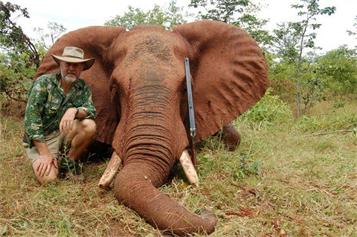 Shooters Party, Robert Borsak with his Big Game kill
~ an African Bull elephant shot on safari in Zimbabwe in June 2008.
[Source: ABC Four Corners, ^http://www.abc.net.au/news/2013-06-11/nsw-mp-robert-borsak-with-an-elephant-shot-on/4745476] Shooters Party, Robert Borsak with his Big Game kill
~ an African Bull elephant shot on safari in Zimbabwe in June 2008.
[Source: ABC Four Corners, ^http://www.abc.net.au/news/2013-06-11/nsw-mp-robert-borsak-with-an-elephant-shot-on/4745476]
.
<< New South Wales Shooters MP Robert Borsak says there has been a culture war over gun control in Australia since the Port Arthur massacre, but he believes people are starting to “get over it.” Mr Borsak believes semi automatic weapons, which were banned in the wake of the 1996 massacre, should be put back in the hands of hunters and recreational shooters. >>
[Source: ‘NSW Shooters MP Robert Borsak says people are ‘getting over’ the Port Arthur massacre’, ^http://www.byronevents.net/nohunting/index.html]
.
.
Further Reading:
.
[1] The Dunn Report (The Governance Review of the Game Council of NSW by Steve Dunn of Independent Consulting, 14th June 2013)
.
ABC Four Corners, ^http://www.abc.net.au/news/2013-06-11/interview-with-robert-borsak-nsw-shooters-and/4745720
.
^http://www.abc.net.au/news/2013-06-11/nsw-mp-robert-borsak-with-an-elephant-shot-on/4745476
.
^http://www.abc.net.au/news/2013-06-11/shooters-mp-says-people-27getting-over27-port-arthur/4745472
.
^ABC, 20130715, ^http://www.abc.net.au/pm/content/2013/s3803487.htm
.
ABC, 20130720, ^http://www.abc.net.au/site-archive/rural/sa/content/2013/02/s3693724.htm
.
‘The Hunting Party’, 20130610, ABC,^http://www.abc.net.au/4corners/stories/2013/06/10/3776198.htm
.
A controversial plan to allow hunting in 79 national parks including the Paroo-Darling National Park in far west NSW near White Cliffs has been delayed indefinitely, 20130220, ABC, ^http://www.abc.net.au/local/audio/2013/02/20/3694440.htm
.
Tags: Game Council NSW, Greater Blue Mountains World Heritage Area, hunting in national parks, Kangaroo shot, Kosciuszko National Park, national parks, NSW Government, poachers, Shooters and Fishers Party, Shooters Party MP Robert Borsak, shooting in national parks, The Dunn Report, weekend warriors, wildlife poaching
Posted in Australian Alps (AU), Blue Mountains (AU), Kangaroos and Macropods, Threats from Poaching and Poisoning | No Comments »
Add this post to Del.icio.us - Digg
Wednesday, July 10th, 2013
 They’re only Kangaroos
..Canberra just needs to expand, so it is easier to just get rid of the native kangaroos.
Katy Gallagher, ACT Chief Minister for Canberra and not much else. They’re only Kangaroos
..Canberra just needs to expand, so it is easier to just get rid of the native kangaroos.
Katy Gallagher, ACT Chief Minister for Canberra and not much else.
.
Katy’s blood lusting for another 2,000 Canberra Kangaroos
.
Katy Gallagher‘s ACT Government want to kill off thousands of pesky kangaroos so that Canberra can develop and expand its housing further into kangaroo feeding grounds.
<< The ACT Civil and Administrative Tribunal today has approved Gallagher’s government licences for kangaroos to be culled at seven sites around Canberra.
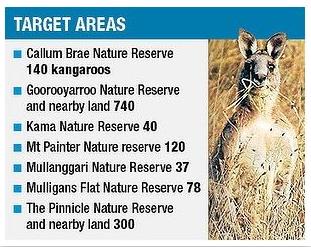
Appeal President Bill Stefaniak and Senior Members Allan Anforth and Adrian Davey varied some of the licences so that only 1244 kangaroos could be shot, not the 1455 originally approved the Conservator of Flora and Fauna. >>
.
[Ed: So Stefaniak has justified that 211 fewer kangaroos seems probably about right. Kill the rest?]
.
<< The seven reserves will be closed at Midday on Thursday to allow culling to take place before the end of July. Animal liberationists have vowed to try and disrupt the shooting of kangaroos in ACT nature reserves after a tribunal approved a scaled-back culling operation..
Carolyn Drew:
“Activists will protest at all seven sites but concentrate much of their efforts on the Goorooyarroo Nature Reserve where a licence has been granted for 740 kangaroos to be culled. We will focus on very intensely on that particular reserve. But the other reserves will also have teams of activists who sit around the various gates so we wait, watch and then we take action as needed.
Many more kangaroos than the 1,244 could die because the figure did not take into account small dependant animals that would be orphaned. “It’ll be within the range of closer to 2,000 that they’ll end up killing if they manage to kill that many.” 2,000 that they’ll end up killing if they manage to kill that many.”
.
The Australian Society for Kangaroos launched action in the tribunal in June to stop the cull.
The Tribunal accepted evidence from government ecologist Don Fletcher that an appropriate number of kangaroos per hectare was between 0.6 and 1.5, which The Government aimed to have one kangaroo per hectare. But the tribunal decided that the cull should aim to leave about 1.5 kangaroos per hectare.
The Australian Society for Kangaroos expert witness, Raymond Mjadwesch, had told the tribunal that it was ecologically appropriate for several more kangaroos per hectare to live on the reserves.
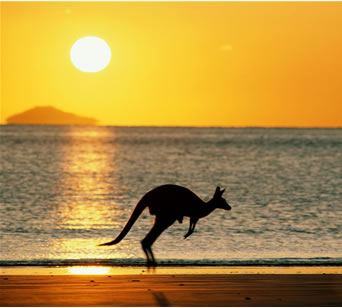
Mr Mjadwesch also challenged Dr Fletcher’s estimates of the number of kangaroos living in the reserves. But the tribunal preferred Dr Fletcher’s evidence over the evidence given by Mr Mjadwesch.
Outside the tribunal, ACT Parks and Conservation Service director Daniel Iglesias said as much of the cull would be completed as possible before a July 31 deadline.
“We originally had an eight week period and now we’ve only got a period of four weeks or so. So we will do our best to do what we can with the time that we have available to us,’’ Mr Iglesias said. Kangaroo culling only takes place in the ACT during the colder months to reduce the chances of younger animals being killed.
Fiona Corke, a former Neighbours star who is president of the Australian Society for Kangaroos, said she was disappointed the cull would go ahead. “We are disappointed that the cull will be proceeding but we are also encouraged by the fact that the tribunal has recognised that number of kangaroos should be and will be reduced,’’ she said.
Ms Corke declined to comment on whether her group would join protest efforts to disrupt the cull. >>
.
[Source: ‘Activists vow to disrupt shooting as roo cull approved by tribunal’, 20130710, by Peter Jean, Chief Assembly Reporter, The Canberra Times, ^http://www.canberratimes.com.au/act-news/activists-vow-to-disrupt-shooting-as-roo-cull-approved-by-tribunal-20130710-2ppeg.html]
.
.
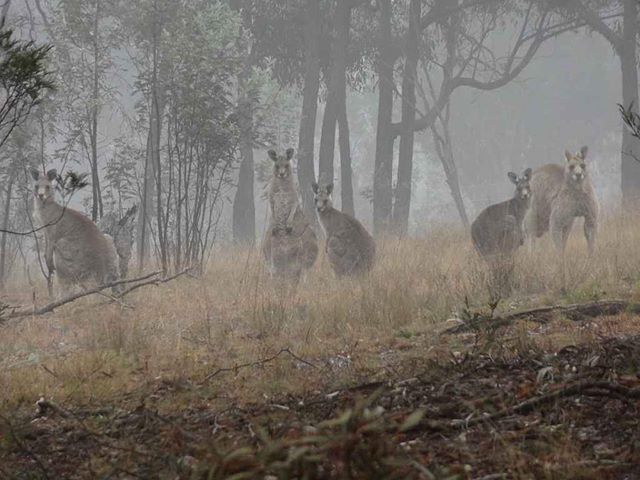 Eastern Grey Kangaroos were around Canberra before Canberra was thought of,
before developers profited from housing sprawl into kangaroo feeding grounds,
before the ACT government fenced them in so they overbred.
Now Katy Gallagher brands kangaroos not Native, but a pest,
just like British colonials treated Aborigines up until the ^1928 Coniston Massacre.
Eastern Grey Kangaroos were around Canberra before Canberra was thought of,
before developers profited from housing sprawl into kangaroo feeding grounds,
before the ACT government fenced them in so they overbred.
Now Katy Gallagher brands kangaroos not Native, but a pest,
just like British colonials treated Aborigines up until the ^1928 Coniston Massacre.
.
<< Known as the “Bush Capital”, Canberra has many nature reserves, but the present Legislative Assembly approved the slaughter – during June 2012 – of 2,000 kangaroos on these reserves.
Although the government-ordered slaughter has now ended for this year, the government fell short of its quota, with ‘only’ 1,154 killed, and has threatened to raise the quota for next season to make up for the shortfall.
However, the joeys aren’t counted in this number – as if they don’t ‘count’ or matter – so we’ll never know how many babies were murdered – by decapitation, bashed in heads – and other brutality – as the officially approved method. >>
.
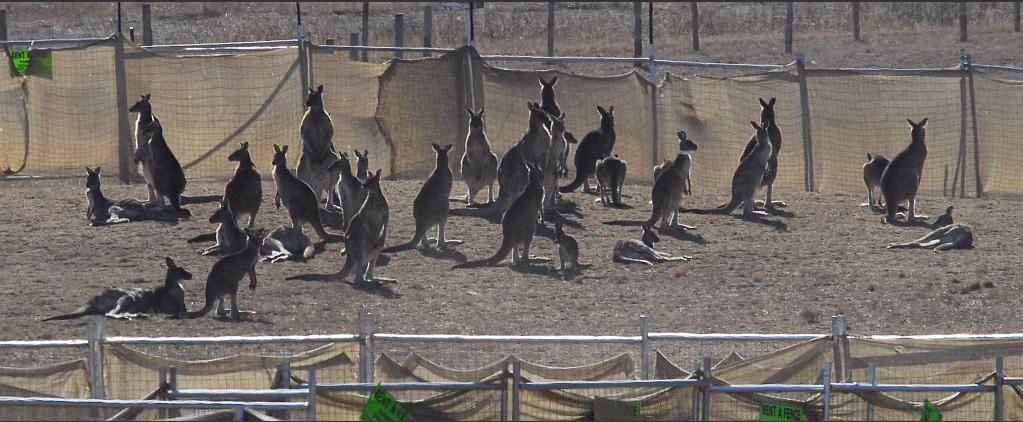
Monday May 19, 2008, government contractors started herding and slaughtering kangaroos on a former naval base in Canberra.
By May 29, 514 kangaroos were dead (including all in this photo).
[Source: Day Drew, Warning: this site contains images of animal suffering that may disturb some viewers.
^http://www.kangaroolives.com/]
.
I have several soul-destroying photos of the killing fields’ burial pits filled up with adult kangaroos and tiny joeys. The photos – including the one (below) – and the following description of events from those in the field were what drove me to start this petition.
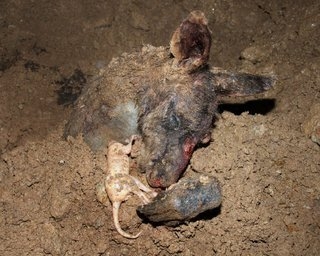
<< “Unearthing the slaughter in Canberra, June 3rd: In the early hours of Sunday morning, activists uncovered a large mass burial pit at the Kama Nature reserve containing an estimated 300 or more slain kangaroo bodies.
Evidence was discovered amidst a slurry of mud and blood, illustrating unethical and illegal practices including throat shots, partially severed joeys and mature kangaroos with smashed heads. Amidst the twisted pile of discarded iconic Australians, a mature buck stands amongst his once proud mob – gunned down by faceless ignorance in Australia’s Capital.” >>
.
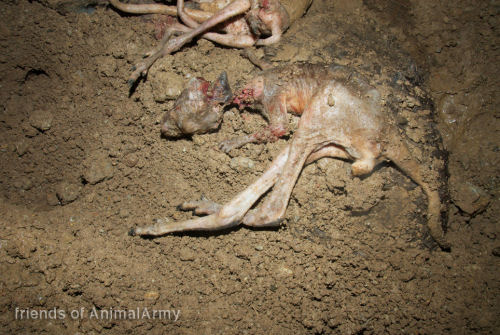
.[Source: ‘Stop the Slaughter of Kangaroos in Canberra’, 2013, a petition by Honour Leigh, ^http://www.change.org/en-AU/petitions/stop-the-slaughter-of-kangaroos-in-canberra]
.
Canberra’s 100 years of ecological slaughter to justify a ‘Bush Capital‘
.

.
2013: Katy Gallagher wants to slaughter 1,455 kangaroos this year in Canberra nature reserves
.
2012: Katy’s Cull included 407 joeys slaughtered
.
2009 – 2012, 3,000 kangaroos of Canberra were slaughered in various so-called ‘Nature Parks’.
.
[Source: ‘ACT kangaroos live another day’, ^http://www.al-act.org/]
.
Katy, wasn’t your 2011 massacre bad enough?
.
<<More than three thousand kangaroos will be shot over the next month as part of the ACT Territory’s annual cull, which starts tomorrow. ACT Parks and Conservation, which oversees the contractors conducting the cull, is this year targeting 3427 kangaroos on six sites in the Canberra Nature Park. The sites that will be closed to the public while the cull is underway are Mulligans Flat Nature Reserve, Goorooyaroo Nature Reserve, Mount Painter Nature Reserve, Callam Brae Nature Reserve, Jerrabomberra West Nature Reserve, Kama Nature Reserve and unleased territory land adjacent to Kama Nature Reserve.
ACT Parks and Conservation Service manager Daniel Iglesias said this morning that kangaroo numbers continued to rise despite the Government’s Kangaroo Management Plan culling program. “The cull of up to 3427 kangaroos is needed to maintain kangaroo populations at appropriate levels to protect the integrity of ecosystems, several of which contain endangered flora and fauna,” he said. “The numbers to be culled have been based on kangaroo counts in each location. “Ensuring the grasslands and woodlands are not overgrazed will protect threatened species and ecosystems, provide habitat for creatures such as ground-feeding birds, prevent excessive soil loss and maintain sustainable numbers of kangaroos.”
Mr Iglesias said the kangaroos would be humanely culled by experienced marksmen. “The cull will be conducted according to a strict Code of Practice that has the endorsement of all relevant authorities including the RSPCA. “Rangers and security staff have been engaged to patrol areas to ensure the safety of the public with warning signs also being installed at all entry points to the reserves,” he said. The ACT Government Vet would conduct spot checks during the program to ensure compliance with the relevant code of practice.>>
.
[Source: Canberra Times, ^http://www.kangaroo-protection-coalition.com/CanberraKangarooKill.html]
.
What about 2012, running out of kangaroo meat pet food?
.
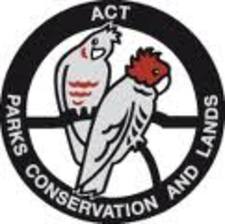 Wildlife Slaughter Sponsor Wildlife Slaughter Sponsor
.
<< More than 2,000 eastern grey kangaroos will be culled across nine reserves across the ACT over the next three weeks.
Nine nature reserves will be closed from Tuesday until June 12 to allow expert shooters to complete the cull. The reserves include Callum Brae, Crace, Goorooyaroo, Jerrabomberra, Kama, Mt Painter, Mulligans Flat, The Pinnacle and Wanniassa Hills.
Daniel Iglesias from Parks and Conservation says the high number of roos is damaging the environment.
“We’re fortunate in the ACT that we have really good quality natural environment so close to where we live,” he said. “So it’s a park service intention to manage kangaroo numbers so that they do not degrade their environment.”
The cull is part of the ACT Government’s Kangaroo Management Plan and will be conducted according to a strict code of practice endorsed by the RSPCA.
“We have gone out to almost all the areas in which we are going to cull and we have taken an estimate of the total numbers,” Mr Iglesias. “So in those nine areas that we are focusing on we’re looking at removing animals which may represent 10 – 15 per cent of the total population.” >>
.
 Wildlife Slaughter Sponsor Wildlife Slaughter Sponsor
.
[Source: ‘Canberra roo cull begins, parks closed’, 20120521, ^http://www.abc.net.au/news/2012-05-21/canberra-roo-cull-begins/4023910]
.
Ed: Sufficient power, means and justification can achieve anything one desires.
Anything!
.
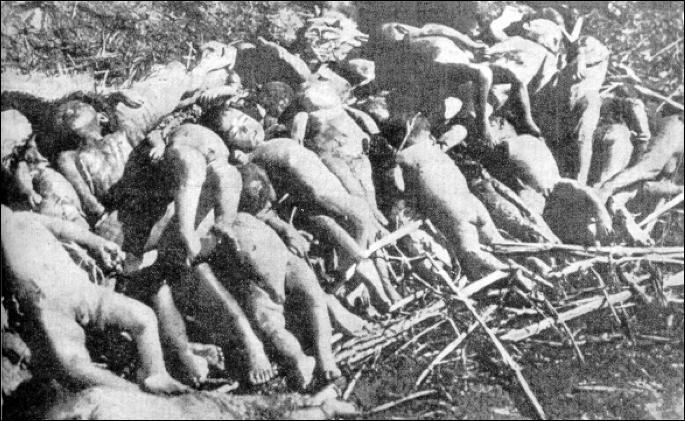 The Nankin Massacre of 300,000 unarmed Chinese men women and children by the Japanese military on December 13, 1937.
Because they were in the way of Japanese plans for economic expansion into Manchuria
It is a territorial thing.
What’s the moral difference Katy Gallagher? The Nankin Massacre of 300,000 unarmed Chinese men women and children by the Japanese military on December 13, 1937.
Because they were in the way of Japanese plans for economic expansion into Manchuria
It is a territorial thing.
What’s the moral difference Katy Gallagher?
.
Saturday, June 22nd, 2013
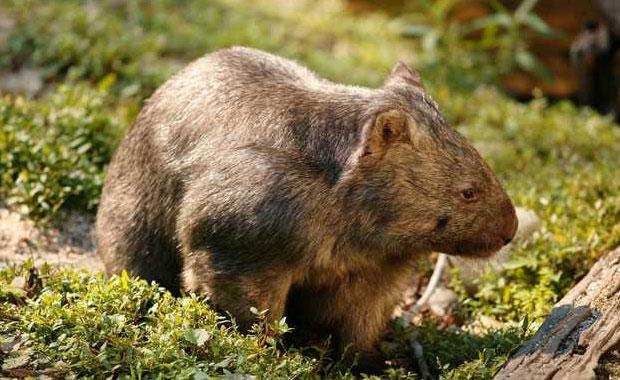 Common Wombat
(Vombatus ursinus)
A legally protected native animal throughout Australia
[Source: Healesville Sanctuary, Victoria, Zoos Victoria,
^http://www.zoo.org.au/healesville/animals/wombat] Common Wombat
(Vombatus ursinus)
A legally protected native animal throughout Australia
[Source: Healesville Sanctuary, Victoria, Zoos Victoria,
^http://www.zoo.org.au/healesville/animals/wombat]
.
June 2013:
.
Tragically, a native Wombat has been deliberately poisoned this month in Mount Wilson in the Blue Mountains, and so the New South Wales National Parks and Wildlife Service (NPWS) is appealing for information from the local community.
Ranger Neil Stone of the NPWS Blue Mountains Region:
“A Wombat was recently found at Mount Wilson village (population 220), suffering from what a local veterinarian thinks was poisoning and sadly the animal had to be euthanized.
“Wombats become unpopular with landholders when they damage fences and infrastructure or trample on gardens. But there are methods, including installing Wombat Gates, that enable Wombats to pass through properties without damaging them.”
.
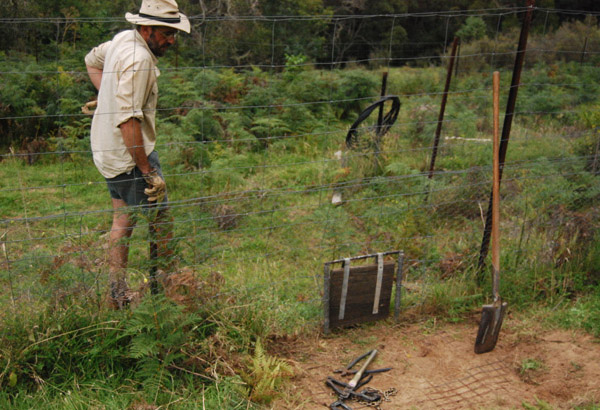 An example of a purpose-built Wombat Gate
If one can afford property at exclusive Mount Wilson with average prices currently $750,000 [^Source]
then one can afford to contribute a few purpose-built Wombat Gates across their property,
constructed by wildlife experts who know what they are doing!
[Photo Source: Rocklily Wildlife Refuge, Taralga, NSW,
^ http://rocklilywombats.com/blog/rocklily-history/] An example of a purpose-built Wombat Gate
If one can afford property at exclusive Mount Wilson with average prices currently $750,000 [^Source]
then one can afford to contribute a few purpose-built Wombat Gates across their property,
constructed by wildlife experts who know what they are doing!
[Photo Source: Rocklily Wildlife Refuge, Taralga, NSW,
^ http://rocklilywombats.com/blog/rocklily-history/]
.
NPWS Ranger Neil Stone:
“Wombats are extremely strong and determined, constructing their burrows (often under homes) to escape from the heat and to hide from predators (typically domestic and feral dogs nowadays). The burrows can be up to 30 metres long which can cause conflict between Wombats and humans.”
“Wombats and all other native animals are protected under the National Parks and Wildlife Act 1974 and Regulations and it is illegal to harm them without a licence. There are fines and possible imprisonment for people found to have intentionally harmed native wildlife.”
.
[Source: ‘Not so divine: Wombat dies in suspected poisoning’, 20130612, Blue Mountains Gazette newspaper (print only), p.15]
.
Wildlife Poisoning is Animal Harm
.
Wombats being mammals are sentient animals, meaning that they feel emotion and pain. An animal is ‘sentient‘ if it is capable of being aware of its surroundings, its relationships with other animals and humans, and of sensations in its own body, including pain, hunger, heat or cold.
Individuals who harm animals including the harming of wildlife such as by poisoning, tend to harbour a personality disorder. Statistically, animal abusers are five times more likely to go on to commit violent crimes against people.
Deviant behaviors like animal abuse generally originate from a traumatic childhood. The American Psychiatric Association considers animal cruelty as one of the diagnostic criteria of conduct disorder.
The fourth edition of the Diagnostic and Statistical Manual of Mental Disorders (DSM) defines conduct disorder as “a repetitive and persistent pattern of behavior in which the basic rights of others or major age appropriate societal norms or rules are violated.” Conduct disorder is found in those who abuse animals and abuse people.
Clinical evidence indicates that animal cruelty is one of the symptoms usually seen at the earliest stages of conduct disorder, often by the age of eight. This information has only recently been included in the DSM so some psychologists, psychiatrists, and social workers are just now becoming aware of it. Many psychological, sociological and criminology studies in recent decades have clearly shown that violent offenders have adolescent histories of serious and repeated animal cruelty.
Director of People for the Ethical Treatment of Animals (PETA) Asia, Jason Baker, has said, “We believe that cruelty to animals is not inherent, but learned. That being said, teaching kindness and respect for animals – in our schools and homes – will foster empathy, the ability to understand what someone else feels.” He added, “Incorporating the simple concepts of kindness and respect into our daily lives and teaching our children to respect and protect even the smallest and most despised among us will help kids value one another.”
The link between animal abuse and interpersonal violence is becoming so well established that many U.S. communities now cross-train social-service and animal-control agencies in how to recognize signs of animal abuse as possible indicators of other abusive behaviors. >>
.
[Source: ‘Animal Cruelty Syndrome’, by Canadians for Animal Welfare Reform, ^http://cfawr.org/animal-abuse.php]
.
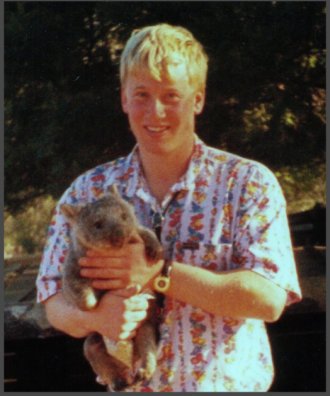 Martin Bryant as a teenager nursing a juvenile Wombat
Bryant reportedly tortured animals as a child.
In 1996, at age 29 Bryant murdered 35 people and injured 21 others
at Port Arthur Tasmania Martin Bryant as a teenager nursing a juvenile Wombat
Bryant reportedly tortured animals as a child.
In 1996, at age 29 Bryant murdered 35 people and injured 21 others
at Port Arthur Tasmania
.
Penalties in NSW for Harming protected Fauna
.
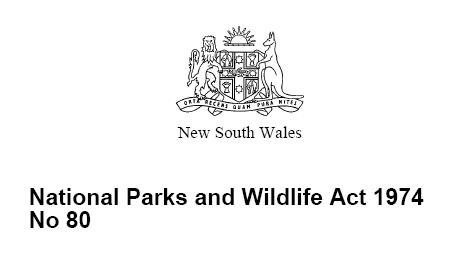
.
Sect 98 ‘Harming protected fauna, other than threatened species, endangered populations or endangered ecological communities’
.
(Ed: i.e. Wombats)
.
(1) In this section, protected fauna does not include threatened interstate fauna, threatened species, endangered populations, endangered ecological communities, or locally unprotected fauna under section 96.
(2) A person shall not:
(a) harm any protected fauna, or (a1) harm for sporting or recreational purposes game birds that are locally unprotected fauna, or
(b) use any substance, animal, firearm, explosive, net, trap, hunting device or instrument or means whatever for the purpose of harming any protected fauna.
.
Maximum penalty:
.
(a) 100 penalty units and, in a case where protected fauna is harmed an additional 10 penalty units in respect of each animal that is harmed, or
(b) imprisonment for 6 months, or both. >>
.
Note: As at 2013, 1 penalty unit in NSW equates to $110. So 100 +10 penalty units incurs a fine of $12,100 per protected Wombat harmed [Calculation: (100 + 10) x $110]
.
[Sources: National Parks and Wildlife Act 1974, No 80, Section 98, (historical version but this section still current), pp 149-150, ^http://www.environment.nsw.gov.au/legislation/NationalParksAndWildlifeAct1974.htm ; ^http://en.wikipedia.org/wiki/Penalty_units]
.
.
.
So who killed the Mt Wilson Wombat?
.
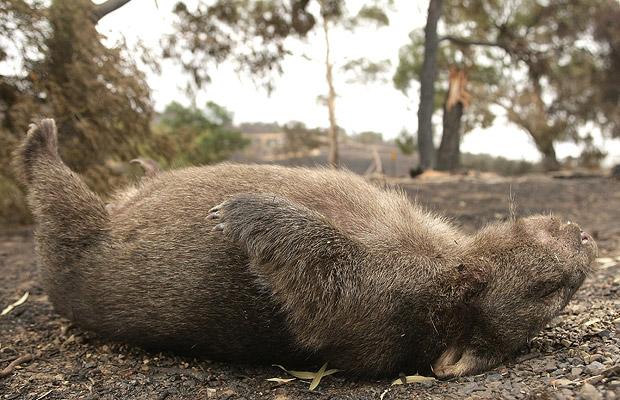 A common Wombat sight
…”Just Roadkill”
A common Wombat sight
…”Just Roadkill”
.
It is likely that Mount Wilson’s Wombat was poisoned by an ignorant and frustrated local landholder. He is one of just a few hundred residents living at remote Mount Wilson village, and probably he is some arrogant newcomer with no respect for the natural environment or its resident wildlife who were there first. It is extremely rare for a female to commit wildlife poisoning.
The perpetrator is likely to be someone holding an Anglicised mindset toward rural property, desiring the exotic deciduous garden and with a phobia towards the natural Australian bush. Whereas the more established residents tend to be respectful towards the special environment in which they live and have become more accommodating towards the place’s resident wildlife.
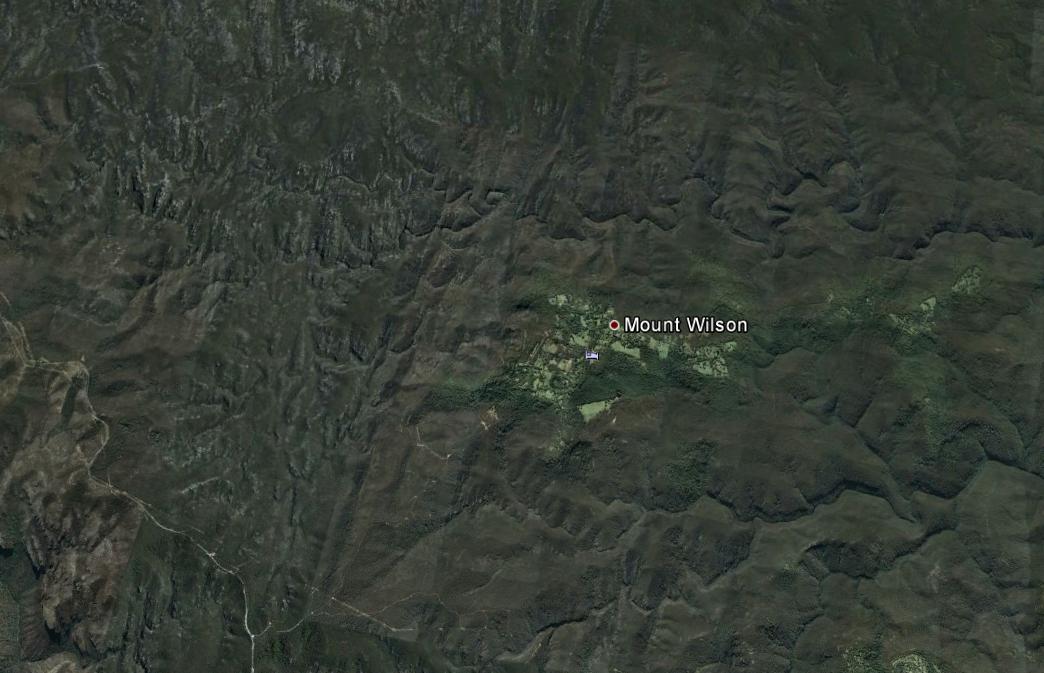 Mount Wilson lies in a remote forested wilderness region of the Blue Mountains
And the native Wombats have lived there thousands of years before
Colonial Deforestation
Housing Development
Anglicised Garden Romanticism
[Source: Google Earth]
(click image to enlarge) Mount Wilson lies in a remote forested wilderness region of the Blue Mountains
And the native Wombats have lived there thousands of years before
Colonial Deforestation
Housing Development
Anglicised Garden Romanticism
[Source: Google Earth]
(click image to enlarge)
.
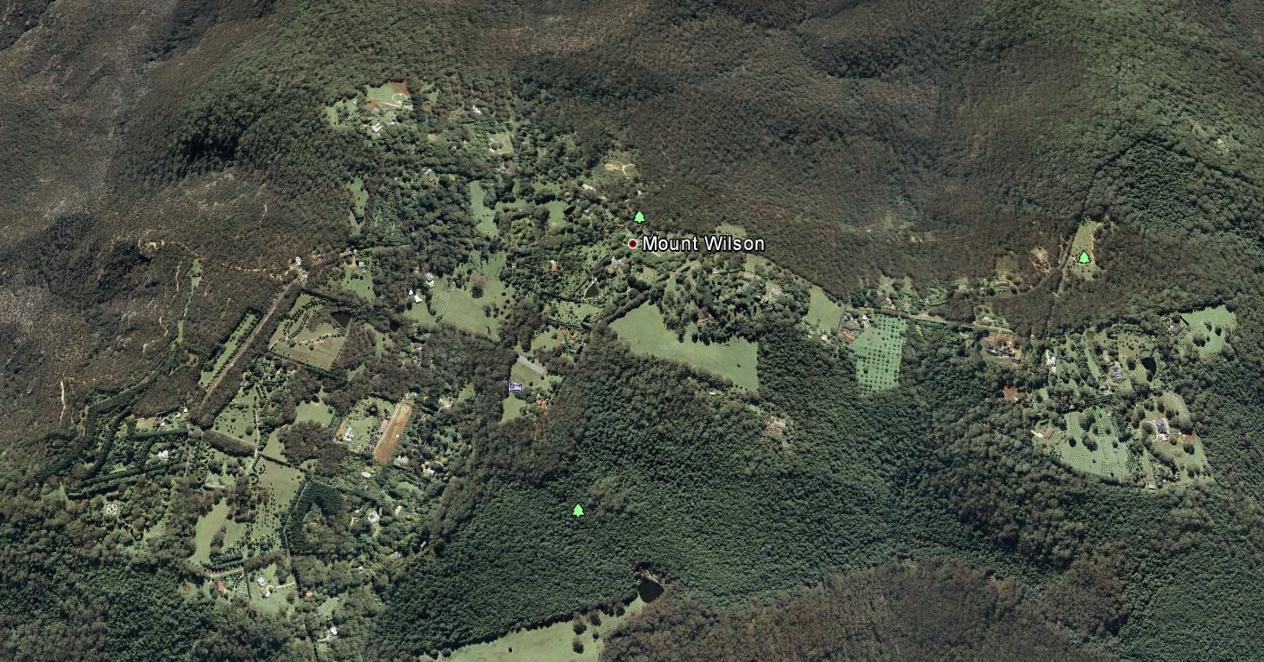 Mount Wilson
Best described as a remote hilltop residential hamlet
Situated on an ancient volcanic hill
Since the 1870s, logged, burned and settled by English colonists
amongst the ‘Wombat Holes’
[Source: Google Earth]
(click image to enlarge)
Mount Wilson
Best described as a remote hilltop residential hamlet
Situated on an ancient volcanic hill
Since the 1870s, logged, burned and settled by English colonists
amongst the ‘Wombat Holes’
[Source: Google Earth]
(click image to enlarge)
.
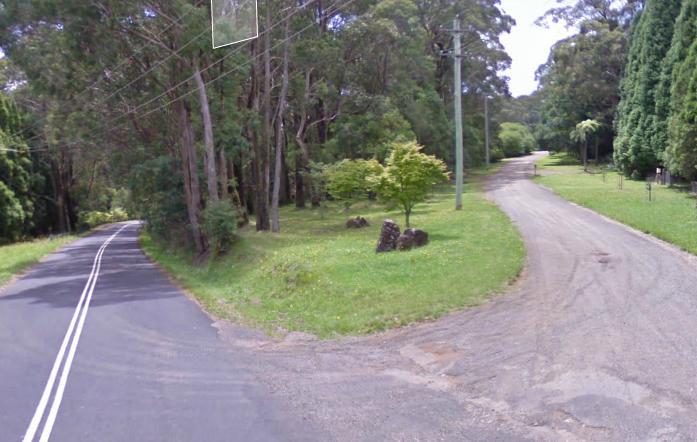 Hillcrest Lane (right), Mount Wilson Hillcrest Lane (right), Mount Wilson
[Source: Google Maps, 2013]
.
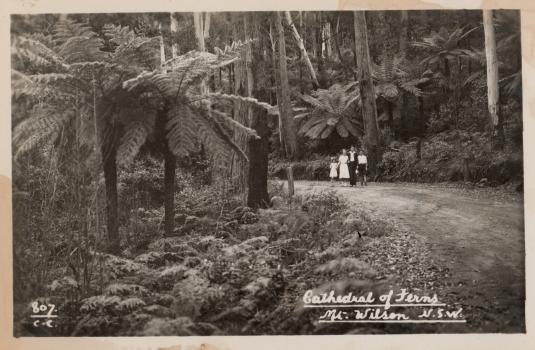 Mount Wilson before the Anglicising
[Source: Mt Wilson/Mt Irvine Historical Society, ^http://www.mtwilson.com.au/]
Mount Wilson before the Anglicising
[Source: Mt Wilson/Mt Irvine Historical Society, ^http://www.mtwilson.com.au/]
.
Consistent with the profile of the typical member of the Game Council NSW, the perpetrator is likely to be a middle-aged or older male Babyboomer approaching 65, having an anthropocentric worldview of Nature, and an evangelistic belief that economic growth and personal wealth accumulation is a right – Wombats being collateral damage in rural housing development.
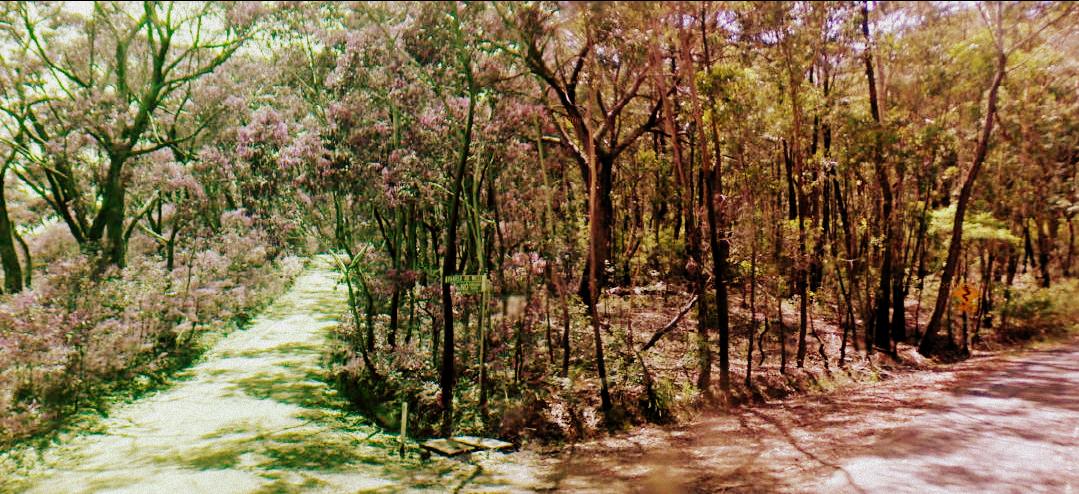 Mount Wilson bushland
Mount Wilson bushland
.
The perpetrator has not yet been confirmed, and anyone with information about this harmful offence is asked to contact the closest NPWS base at the Blue Mountains Heritage Centre in nearby Blackheath.
.
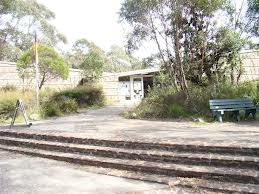 NPWS Blue Mountains Heritage Centre
Located towards the eastern end of Govetts Leap Road
outside the nearby township of Blackheath NPWS Blue Mountains Heritage Centre
Located towards the eastern end of Govetts Leap Road
outside the nearby township of Blackheath
.
.
.
The ‘Common‘ Wombat?
.
The Common Wombat (Vombatus ursinus) is also known as the Coarse-Haired Wombat or Bare-Nosed Wombat. In the case of the Bare-Nosed Wombat, this reference to its nose, distinguishes it from its other two subspecies, the Southern Hairy-Nosed Wombat (Lasiorhinus latifrons) and the endangered Northern Hairy-Nosed Wombat (Lasiorhinus krefftii).
The ‘Common Wombat‘ is a nocturnal marsupial native to south eastern Australia and is found in small sections of southeast tip of Queensland, eastern New South Wales, eastern and southern Victoria, and south-east South Australia. They are common throughout Tasmania and also on Flinders Island in Bass Strait.
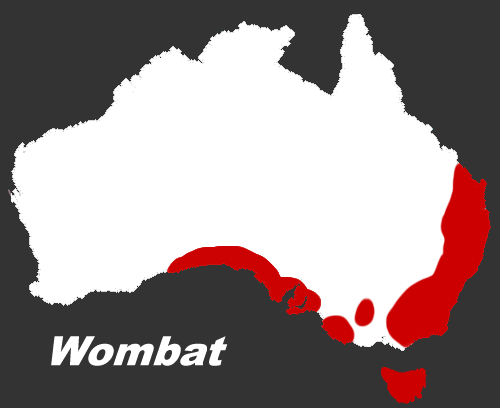
The head of the Common Wombat is more rounded than that of the hairy-nosed subspecies. Their short ears are triangular and slightly rounded. Their nose is large, shiny black and furless. Their fur is coarser, thicker and longer than that of the Hairy-nosed Wombats, better suited to a colder, wetter habitat. Fur colour varies from sandy to brownish black or even grey, sometimes flecked.
.
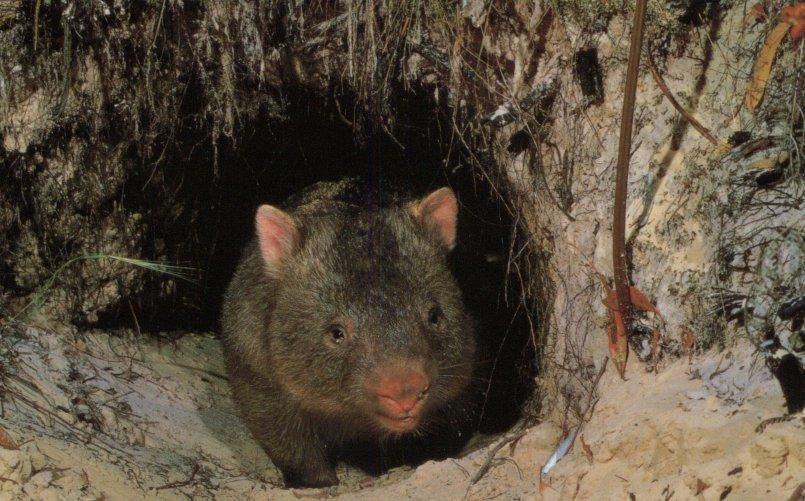 Bare-Nosed Wombat
a more respectful naming than ‘Common’ Bare-Nosed Wombat
a more respectful naming than ‘Common’
.
Wombats have short legs, and the second and third toes of the hind feet are fused, with a double claw used in grooming. Wombats are solid and stocky, with short legs and tail. Their front legs and shoulders are powerful. Their front feet are large, with bear-like long claws. They use their front legs for digging burrows. The dirt is pushed to one side and the Wombat backs out, moving loose dirt with front or back paws. It grows to an average of 98 cm long and up to a healthy weight of 26 kg.
Wombats are stilll classed as ‘least concern’ by the International Union for Conservation of Nature and Natural Resources (on the IUCN ‘red list’). [Ed: So were the Koala and Tasmanian Devil until recently].
At Healesville Sanctuary in Victoria, more than 2,000 sick and injured native animals treated each year including Wombats at its Australian Wildlife Health Centre.
[Source: Healesville Sanctuary, Zoos Victoria, Victorian State Government, ^http://www.zoo.org.au/healesville/animals/wombat]
.
 Situated on Badgers Creek
A place of inspiration to this Editor,
when visited as a child. Situated on Badgers Creek
A place of inspiration to this Editor,
when visited as a child.
.
Although Wombats have been named by European Australians as the ‘Common Wombat‘, their numbers and their existence value does not translate to anyone treating them as commonplace.
Common Wombats were once widespread from south-eastern Queensland, through NSW along the Great Dividing Range and most of Victoria. Now they have a fragmented distribution in NSW, being most abundant in the south-eastern parts of the state. Remaining populations are under continued pressure from land clearing, road mortality, disease and illegal shooting. These pressures may be acute for some local populations.
While the word ‘Wombat’ is derived from the Aboriginal name for the animal, ‘common’ was added at a time when these animals were plentiful and the Australian bush landscape relatively less destroyed by colonial settlement. Wombats were likened to European Badgers by the early colonists.
We prefer the more respectful name, ‘Bare-Nosed Wombat‘.
.
In 2010, university student Nikki Selles, from the School of Natural Sciences at the University of Western Sydney, undertook a field fauna study on Wombats in the Mt Wilson and Mt Irvine area. Due to the behaviour of slow moving, ground-dwelling Wombats being sensibly shy and noctural, Selles used camera-trap data to identify their habitat and distribution in the urban-bush interface.
Results ought to be obtainable from the university.
[Source: Mount Wilson and Community Newsletter, May 2010, ^http://www.mtwilson.com.au/images/stories/MWPA_Newsletters/May_2010.pdf]
.
While the Bare-Nosed Wombat is not yet threatened with extinction, the Northern Hairy-Nosed Wombat is endangered. This is mainly due to overgrazing by sheep and cattle destorying their fragile semi-arid habitat across more central Australia, as well as the culture of broadscale hazard reduction and uncontrolled bushfires.
Mount Wilson also provides vital native habitat for fauna species that are recognised as endangered. These include the Sooty Owl (Tyto tenebricosa), the Eastern Bent Wing Bat (Miniopterus schreibersii oceanensis), the Large eared pied bat (Chalinolobus dwyeri), Little John’s Tree Frog (Litoria littlejohni), and the Eastern False Pipistrelle (Falsistrellus tasmaniensis).
.
Living with Resident Wombats
.
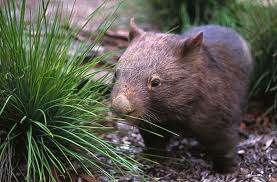 Wombats are locally territorial, like Humans
Try to relocate them, and they will stubbornly resist – even after repeated flood, drought, bushfire and earthquake
Ask any Human who has endured such tempest. Wombats are locally territorial, like Humans
Try to relocate them, and they will stubbornly resist – even after repeated flood, drought, bushfire and earthquake
Ask any Human who has endured such tempest.
.
<<Wombats are an iconic part of the protected fauna of NSW. They are extremely strong and determined animals.
They can build their burrows under Human-introduced houses, driveways and cattle stock routes. This may cause Humans inconvenience and conflict between Wombats and non-Indigenous Humans.
.
But Newcomer Humans need to respect that Wombats were there first.
Who likes Invasion or Displacement?
.
Human-Wombat conflicts can be respectfully resolved and accommodated by wisdom – by learning about the behaviour of Wombats and understanding their habitat needs.
The Bare-Nosed Wombat is the species most frequently found in NSW. They prefer temperate forested areas of the coast, ranges and western slopes. Slopes above creeks and gullies are favoured sites for burrows and they like to feed in grassy clearings, including farm paddocks.
.
Wombat Habitat Needs
.
Wombats construct burrows to escape the heat and hide from predators. They prefer areas where it is easy for them to dig. The burrows can be up to 30 metres long and several metres deep and are usually situated above creeks and gullies and may have multiple entrances. Active burrows are often characterised by fresh cube-shaped droppings and scratch marks as well as freshly dug soil at the burrow entrance. Wombats will often build more than one burrow within their home range of 5 to 25 hectares.
Wombats are mostly solitary animals, but overlapping home ranges can occasionally result in a number of Wombats using the same burrow. Wombats are possessive about their particular feeding grounds and they will mark out these areas by leaving scent trails and droppings. These markings are prominently placed on rocks and logs around the boundaries. If an intruding Wombat encroaches on another’s territory it will be discouraged through a series of snorts and screeches and at times physical aggression.
Breeding occurs year-round with each female typically producing one young. In some areas, however, Wombats are seasonal breeders and may have dependent young in burrows from April to June. Young Wombats take up to 21 months to reach full independence and two years to become sexually mature.
.
Wombat Behaviour
.
Wombats become unpopular with landholders when they damage fences and infrastructure or trample upon gardens. Undetected burrows can be a hazard to livestock as they may trip or fall into burrows and injure themselves.
Many of the problems caused by Wombats can be resolved with some patience and innovation. Landholders willing to share their property with Wombats may find that there are simple solutions to most problems. For example, a post or small strand fence can be used to mark burrows in paddocks or driveways to keep stock away from burrow entrances.
Wombats use the same trails to get to and from their preferred feeding areas. Instead of going around an obstacle, such as a fence, a determined Wombat will try to go through, or under it instead. Installing purpose-built ‘Wombat Gates’ at known Wombat breech points along a fence will allow them to pass through a fence without damaging it. The fence needs to continue to exclude other animals such as wallabies, rabbits and foxes.
Removing the lowest fencing wire (15 cm above ground level) will also allow Wombats to move through an area without damaging the fence. This is a much cheaper option than excluding them completely.
Check first with a Certified National Parks Wildlife Ranger.
.
Excluding wombats from Rural Property
.
It is possible to exclude Wombats from continuing to use a burrow that is under a building but this requires intervention by a Certified National Parks Wildlife Ranger.
.
Increasing Native Vegetation
.
Wombats prefer to burrow in areas of vegetation and rocky debris. Land clearing has forced Wombats to build burrows along creeks and drainage lines where vegetation still exists. Wombats are also often incorrectly blamed for causing erosion, which is more likely due to poor land management practices.
Planting trees and revegetating areas away from creeks can play a vital role in reducing Wombat burrowing activity along creek beds. Retaining existing trees, logs and rocks, and establishing new areas of native vegetation encourages Wombats to construct burrows in less fragile areas and reduces the risk of erosion.
Check first with a Certified National Parks Wildlife Ranger.
.
Trapping or Relocating Wombats Prohibited
.
The trapping and relocation of Wombats is prohibited and attracts heavy fines.
Wombats are territorial animals and if relocated, they are likely to be harassed or even killed by resident Wombats. Wombats are classified as protected fauna under the NSW National Parks and Wildlife Act 1974.
.
Can I bulldoze or infill a Wombat burrow?
.
No! Only inactive Wombat burrows may be destroyed, but each one needs to be first validated by a Certified National Parks Wildlife Ranger.
Bulldozing an active burrow can lead to wombats being buried alive and suffering a slow and painful death. Even if you have located an apparently vacant burrow, you must not fill it in without confirming that it is inactive. Burrow activity can be confirmed by placing sticks across each entrance and checking (every day for at least a week) if these are disturbed.
Remember that if you think you have an inactive burrow, check first with a Certified National Parks Wildlife Ranger.
contact your local National Parks office for expert verification before any action.
.
[Source: NSW Government, ^ http://www.environment.nsw.gov.au/animals/LivingWithWombats.htm#gate]
.
.
.
Further Reading
.
[1] Wombat Gate Design
^http://www.dpiw.tas.gov.au/inter.nsf/Attachments/LBUN-84H7FT/$FILE/Wombat%20gate%20design.pdf
.
[2] Guide to Living with Wombats
[Source: ^ http://www.naturalresources.sa.gov.au/samurraydarlingbasin/plants-animals/native-plants-and-animals/native-animals]
.
[3] National Parks and Wildlife Act (NSW) 1974
^http://www.austlii.edu.au/au/legis/nsw/consol_act/npawa1974247/
.
[4] Wombat Protection Society of Australia
^http://www.wombatprotection.org.au/
.
Why Do Wombats Need Protection?
Lack of Legislative Protection/Enforcement!
<< In Australia native animals are “the property of the Crown”. This means that no-one owns wombats, they can’t be kept as pets and to do anything with them you have to be licensed by government departments.
Government Departments do little to protect or help wombats. Most research and all welfare (rescuing injured wombats, raising the joeys of mothers killed in collisions with vehicles, removing wombats from unsuitable places) is undertaken by voluntary organizations. While penalties exist if someone is found to hurt or kill a wombat, the same government departments charged with wombat care issue permits to farmers to cull wombats. Sadly, there is often no check whether this is necessary, whether it is done humanely or any insistence that alternative options be employed before issuing such permits.
On the other hand although penalties exist for the illegal killing of wombats, such killing occurs every night where on a farms they are shot, buried alive and gassed and on the highways of Australia vehicles indiscriminately drive directly at wombats without penalty. Live joeys left in their dead mother’s pouches die slowly and a lack of public education means few Australians understand how to rescue a joey still living after its mother falls victim to road kill. >>
.
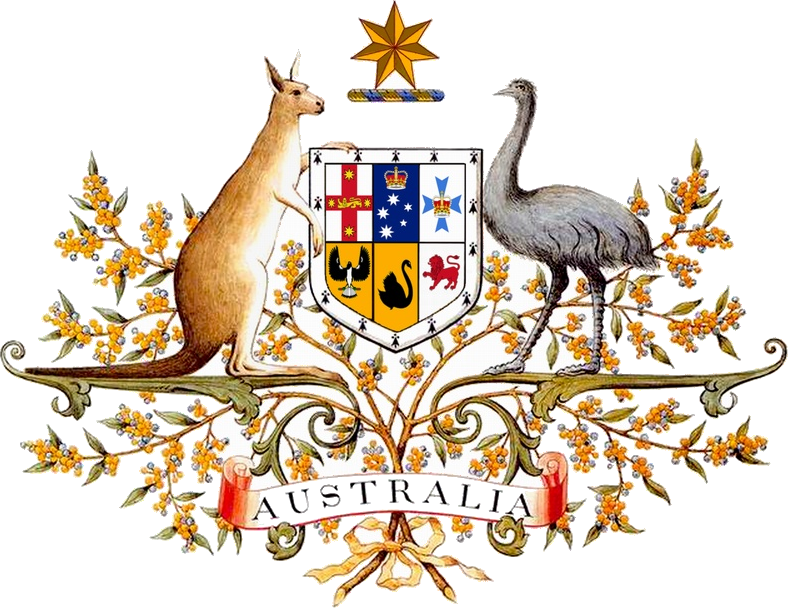 The Crown
Disinterested in protecting Australian wildlife
The kangaroo and emu images are but token symbolism The Crown
Disinterested in protecting Australian wildlife
The kangaroo and emu images are but token symbolism
.
[5] The Wombat Foundation
^http://www.wombatfoundation.com.au/
.
<<The Wombat Foundation is a charitable organisation set up to support activities that aim to bring the Northern Hairy-nosed Wombat back from the brink of extinction.
The Northern Hairy-nosed Wombat is one of the world’s most endangered species – it is more endangered that the Panda.
In the 1980s, there were as few as 35 wombats remaining on the planet – all at Epping Forest National Park in central Queensland. A second population was established at Richard Underwood Nature Refuge in southern Queensland in 2009. At last count, in 2010, there were a total of 176 wombats across the two sites. Since then, the population has continued to grow: in 2012, the combined population at the two sites was estimated at 200 wombats. >>
.
[6] Wombat Awareness Organisation
^http://wombatawareness.com/
.
<<We are a charity established to help save the Southern Hairy-nosed Wombat (Lasiorhinus latifrons) from extinction.
The wombat is an Aussie icon but few people are aware of the peril these gorgeous little animals face: drought, floods, climate change, disease, vehicular incidents and culling – both legal and illegal. It’s not rocket science to see these animals are in trouble but thanks to the work of WAO volunteers, there is hope!
Currently, the wombats are being affected by an unidentified disease outbreak. The visual symptoms are hair loss and emaciation, internally the wombats are anemic and in some cases there is liver damage and heart disease. The direct cause is unknown however it is suspected that due to an increase in weeds there is a decrease in food availability therefore the wombats are forced to eat what they can most of which unfortunately is toxic. >>
.
[7] WIRES
NSW Wildlife Information, Rescue and Education Service Inc.
^http://www.wires.org.au/
.
[8] Rocklily Wildlife Refuge
Taralga, NSW, ^ http://rocklilywombats.com/blog/rocklily-history/
.
<<This website is about Rocklily Wildlife Refuge, and a few other wildlife carers we know in Australia too. Providing a safe place for our native flora and fauna and the various wildlife projects we are undertaking can be an expensive business, so we sell reasonably priced, quality Australian-made gifts and artisan products to raise money for our wildlife projects.
..This website has come about with our move to Rocklily Wildlife Refuge: a safe place for wild native animals just inside the SW border of the Greater Blue Mountains National Park, and within the locked gate of the Sydney Water Catchment. >>
.
[8] Healesville Sanctuary
^http://www.zoo.org.au/healesville
.
<<Healesville Sanctuary, or the Sir Colin MacKenzie Fauna Park, is a zoo specializing in native Australian animals. It is located at Healesville in rural Victoria, Australia (east of Melbourne), and has a rare history of successfully breeding Australia’s native animals.
.
[9] People for the Ethical Treatment of Animals (PETA)
^http://www.petafoundation.org/
.
[10] Voiceless, The Animal Protection Institute
Paddington, New South Wales
^https://www.voiceless.org.au/the-issues/animal-sentience
.
[11] The Cambridge Declaration on Consciousness
.
‘The Cambridge Declaration on Consciousness’, 20120707, by Philip Low, Paper presented at the Francis Crick Memorial Conference on Consciousness in Human and Non-Human Animals, Churchill College, University of Cambridge, England, ^http://fcmconference.org/img/CambridgeDeclarationOnConsciousness.pdf
<< In 2012, an international group of eminent neuroscientists signed The Cambridge Declaration on Consciousness, which confirmed that many animals, including all mammals and birds, possess the “neurological substrates that generate consciousness.” >>
.
.
[12] The Baby Boomers Who Destroyed the World
.
‘The Baby Boomers Who Destroyed the World’, 20110218, by Karlsie, in Subversify, ^http://subversify.com/2011/02/18/the-baby-boomers-who-destroyed-the-world/]
.
[13] Mount Wilson Property Prices
^http://reareports.realestate.com.au/house_prices_growth_rates/nsw/mount_wilson/2786
.
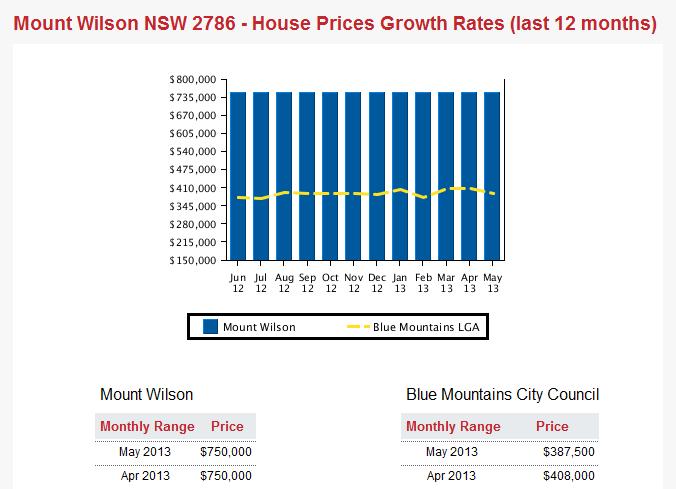
..
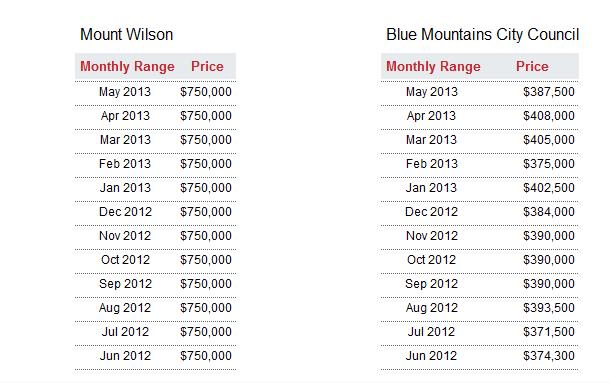 . .
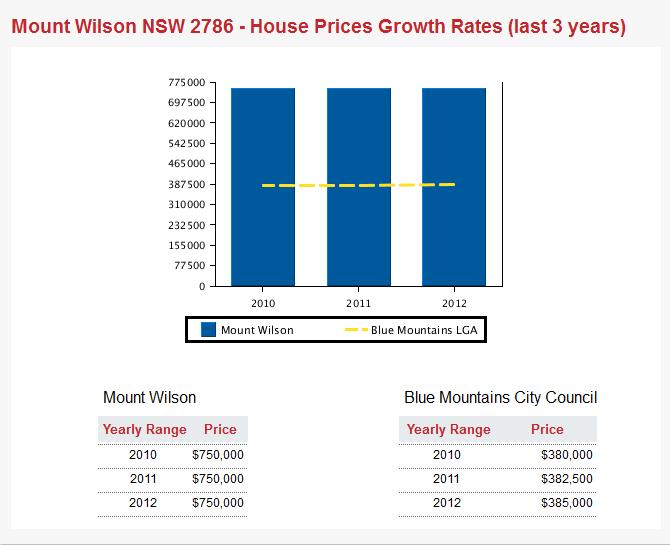 . .
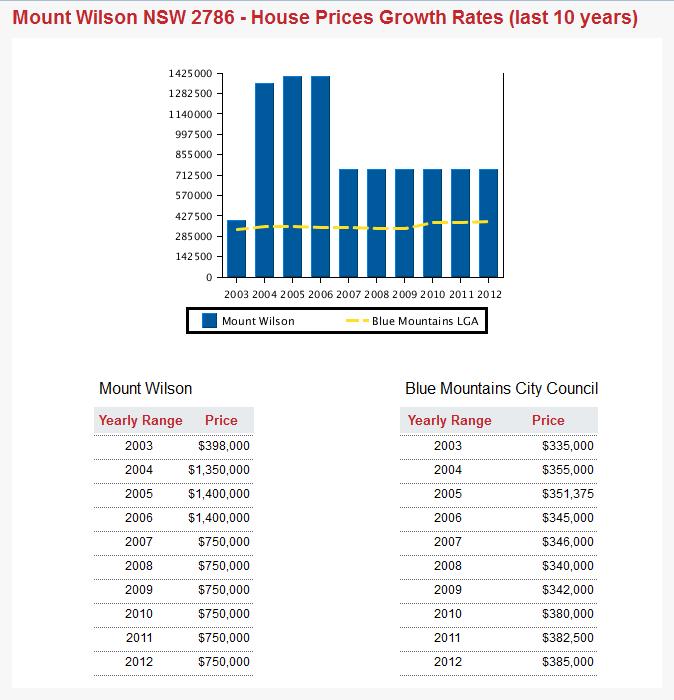 . .
.
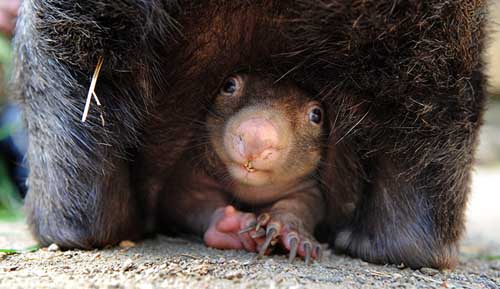
2013 Price?
.
Tags: Anglicising, animal cruelty, Animal Cruelty Syndrome, Animal Harm, Bare-Nosed Wombat, Blue Mountains, Coarse-Haired Wombat, Common Wombat, Living with Wombats, Martin Bryant, Mount Wilson, Mount Wilson Property, Mount Wilson Property Prices, Mount Wilson Real Estate, Mt Wilson, national parks and wildlife act, NSW National Parks and Wildlife Service, sentient, Wombat Gate, Wombat Habitat, wombat poisoned, Wombat Protection
Posted in Blue Mountains (AU), Threats from Development, Threats from Poaching and Poisoning, Wombats | 1 Comment »
Add this post to Del.icio.us - Digg
Friday, May 31st, 2013
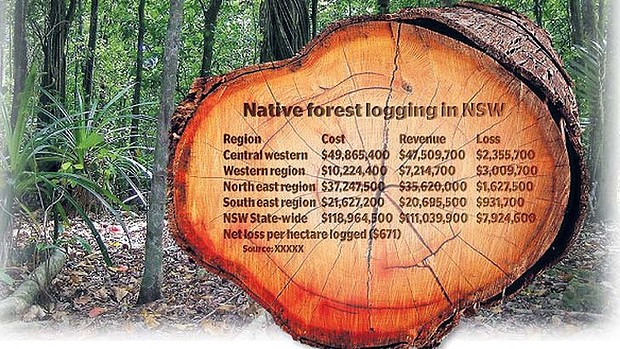 Forests NSW has been rebranded the Forestry Corporation of NSW for what wasteful reason?
It continues to make massive losses and should be wound up, not rebranded.
It destroys native habitat and makes an $8 million annual loss in the process.
This makes forestry not a commerical business, but a Costly Cult of Logging Losers. Forests NSW has been rebranded the Forestry Corporation of NSW for what wasteful reason?
It continues to make massive losses and should be wound up, not rebranded.
It destroys native habitat and makes an $8 million annual loss in the process.
This makes forestry not a commerical business, but a Costly Cult of Logging Losers.
.
<<Taxpayers in NSW are losing money to subsidise the logging of native forests, at an average cost of $671 a hectare ($8 million p.a.), undermining a parliamentary report calling for a massive increase in such logging.
According to new figures, each of the four native forest operations run by the Forestry Corporation of NSW made a loss, combining for a total loss of $7.9 million.
Fees paid to contractors to harvest and haul timber, staff and administration costs for forestry management reached $119 million last year, but revenue from pulpwood and sawlogs was just $111 million.

come…

Rebranding with a chainsaw image and new website.
Like the RTA-come-RMS…same organisation, same management, same Baby Boomer culture, different in name only.
That was a big fat waste of money Premier Barry O’Farrell.
.
A state parliamentary inquiry, dominated by the Shooters Party and the Nationals, has recommended an increase in logging of native forests to keep loggers in jobs. But Greens MP David Shoebridge said the data revealing the losses, which was released in response to questions on notice by the Greens, showed any expansion of logging would ”cost taxpayers dearly” and doesn’t make economic sense.
”Wood chipping native forests causes enormous environmental destruction – it’s not like health or education where people expect the government to subsidise a social good,” said Mr Shoebridge. ”Rather than expanding native forest logging, as the Shooters Party and the Nationals are calling for, the government should be actively transitioning away from native forests to plantations.”
Forests NSW, which pays a dividend to the state government, was corporatised in January with the aim of stemming the losses from the native forestry operations, which are being cross-subsidised by profitable plantation logging.
Plantation profits reached $32 million in the 2011/12 financial year, but the dividend paid to the government was cut in half by the loss in the native forests division.
A Forestry Corporation spokeswoman said: ”It is true that in recent years the native forest operations of the former Forests NSW have been loss-making in pure commercial terms.”
She said all aspects of the business are now being reviewed by new management, and new revenue streams and products have been identified, including rocks, gravel, commercial recreation, permits for telecommunications towers and tourism, to generate money.
.
Forestry is a Costly Cult of Logging Losers
.
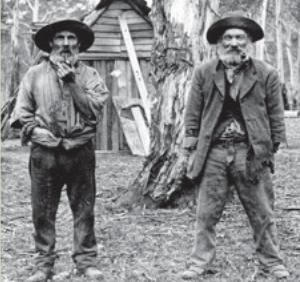 Timber Getters
“A proud a rich history”.. in logging native forests and destroying native habitat for personal profit
What’s Changed?
These days they do science degrees and come out calling themselves ‘foresters’. Timber Getters
“A proud a rich history”.. in logging native forests and destroying native habitat for personal profit
What’s Changed?
These days they do science degrees and come out calling themselves ‘foresters’.
.
But there are no plans to stop logging in native forests because the state government is locked into contracts with long-term wood supply commitments.
”The timber industry is often the main employer and source of economic activity in rural and regional areas,” the spokeswoman said.
Mr Shoebridge said the industry was pushing for the government to increase the volume of wood harvested from 160,000 cubic metres to 269,000 cubic metres a year.
”To feed that massive 80 per cent increase will require logging more than 40,000 hectares of NSW forest every year from protected reserve areas and overexploited state forests.”
Logging in Forestry Corporation’s central region native forests near Wauchope lost $2.36 million in 2012. The western region near Dubbo lost $3 million, the north-east region forest near Coffs Harbour lost $1.63 million, while the south-east region near Batemans Bay lost $931,700.
A Forestry Corporation spokeswoman said if logging in native forests was stopped, taxpayers would have to foot the bill for the management of land.>>
.
[Source: ‘Hatchet job on native forest logging’, 20130519, by journalist Kirsty Needham, Sydney Morning Herald, ^http://www.smh.com.au/nsw/hatchet-job-on-native-forest-logging-20130518-2jtcf.html]
.
[Ed: So be it. The $8 million in annual losses would quickly pay for the legal payout of the wood supply contracts. It’s about political will, and Barry is a teddy bear.]
.

So the timber industry in New South Wales is now pushing to be allowed to log up to a million hectares of national parks so it can harvest the volumes promised in unsustainable timber supply contracts. This outrageous move has occurred at the same time that the NSW Government is conducting a secret review of forestry regulations and timber supply options.
Throughout this review, the timber industry has been campaigning hard to bring in damaging reversals of the hard won forestry regulations that protect our threatened animal and plant species and their habitats.
Premier Barry O’Farrell must resist pressure from the Shooters and Fishers Party, and from within his own government, to make more forests available for logging and other damaging changes to the forestry regulations that protect our unique wildlife and the areas they call home.
It is unthinkable that the O’Farrell Government would allow the destruction of areas like Nightcap National Park so the Forestry Corporation can turn a profit.
.
[Source: Kate Smolski, Campaigns Director, Nature Conservation Council of New South Wales, ^http://www.nccnsw.org.au]
.
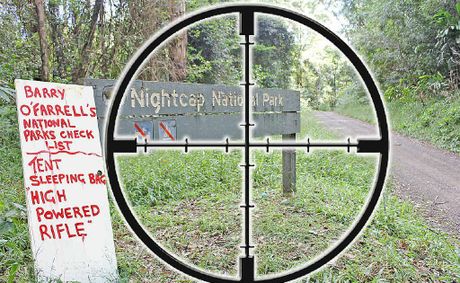 Nightcap National Park in the sights of cowboy hunters Nightcap National Park in the sights of cowboy hunters
.
And the shooting threat hasn’t gone away…
<<Several North Coast national parks have been included on a “hit list” of parks to be considered for recreational shooting.
Last week Premier Barry O’Farrell announced changes to the Game and Feral Animal Control Act (2002) that would allow 79 of the state’s 799 national parks, nature reserves and conservation areas to be used by licensed shooters. The list includes the Nightcap, Richmond Range and Yabbra National Parks.
The announcement has been widely criticised by environment groups and the Opposition as a “backroom deal” to secure the support of the Shooters and Fishers Party in return for support to privatise the state’s electricity assets.
Premier O’Farrell said prior to the last election: “There will not be a decision to turn our national parks into hunting reserves.”

Vice president of the ^North Coast Environment Council Mr Jim Morrison said he was “absolutely outraged” by the election backflip.
“We’re disappointed because we were given assurances before the election this would not happen,” he said. “I’ve got little faith in the O’Farrell government now to manage the environment… I think the difficult issue will be compliance because when there are people running around with guns, it will be impossible for National Parks staff to know who is legal and who isn’t… I’m frightened people who visit some of the more remote parks where there aren’t any services will be turned off visiting for activities such as bushwalking.”
Mr Morrison said he also feared a resurgence of “cowboy shooting activity” in remote areas. “It’s a bad message to be supporting a blood sport and I don’t believe it will be an effective way to do feral animal control. It should be managed by park staff.”

The NSW Public Service Association (PSA), which represents park rangers, has directed its members not to assist with any activity involved with establishing recreational hunting in national parks in NSW.
PSA General Secretary Mr John Cahill:
.
“Our members have expressed serious concerns about the danger to themselves and the community when shooting is allowed in bushland popular with walkers and picnickers. Our members have been working very hard to control and manage feral animals in parks.
Recreational shooting will compromise the professional and scientifically proven feral animal control programs run by National Parks staff, placing native plants and animals at risk.
“Industrial action like this is not a decision we take lightly but we simply cannot let the State Government’s compromise of our national parks to go ahead.”
.
Spokesperson for the North East Forest Alliance (^NEFA) Dailan Pugh issued a statement calling for the Federal Government to intervene.
“The fact that Premier O’Farrell can say in one breath that they will exclude World Heritage, and in the other identify six World Heritage listed parks for shooting, shows how ill-conceived his backflip is… The Federal Government needs to intervene to over-ride the State Government’s announced intention to allow shooting in world-heritage properties,” Mr Pugh said.
CEO of Northern Rivers Tourism Russell Mills issued a cautious warning. “My initial view is that national parks like the Nightcap that are part of the World Heritage and their primary
drawcard is the pristine nature of the wilderness areas… If National Parks (management) are considering the pros and cons of shooting, I hope they take into consideration the motivation for visiting parks, and I believe they would.”
Rob Andrews from the Northern Zone Hunting Club said he had been “deluged” by up to six calls a day since the Premier’s announcement from people wanting to know how to go about getting licences.>>
.
[Source: ‘Parks in shooters’ sights’, 20130607, by journalist Andy Parks, Echo News, ^http://www.echonews.com.au/news/parks-in-shooters-sights-govt-to-allow-hunting-in-/1407811/]
.
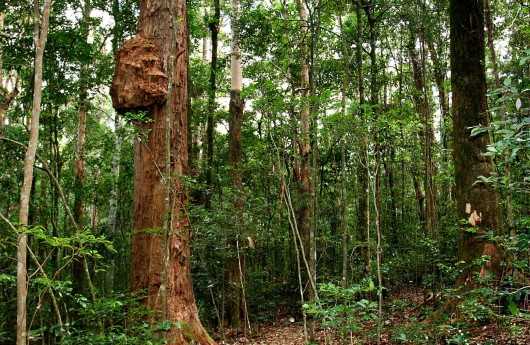 Richmond Range National Park
Targeted for logging and shooting by its custodian, the New South Wales Government
[Source: ^http://www.nationalparks.nsw.gov.au/richmond-range-national-park]
Richmond Range National Park
Targeted for logging and shooting by its custodian, the New South Wales Government
[Source: ^http://www.nationalparks.nsw.gov.au/richmond-range-national-park]
.
Further Reading:
.
[1] >Forestry Bill 2012 Explanatory Note.pdf (380 kb)
.
[2] ^Forests NSW Annual Report 2011-12.pdf (10.4 MB)
.
[3] >Forests NSW Facts and Figures 2011-12.pdf (2.8 MB)
.
[4] ^Forests NSW Annual Report 2010-11.pdf (7.6 MB)
.
[5] >Forests NSW Facts and Figures 2010-11.pdf (3.5 MB)
.
[6] >Forests NSW Annual Report 2009-10.pdf (6.2 MB)
.
[7] >Forestry in NSW 1996.pdf (1.5MB)
.
Saturday, May 4th, 2013
[The following article was written by Tigerquoll and first published on ^CanDoBetter.net under the title ‘Brushtail Possums are a destructive pest in NZ – but is persevering with a backyard fur trade New Zealand’s ethical solution? Comments have been included.]
.
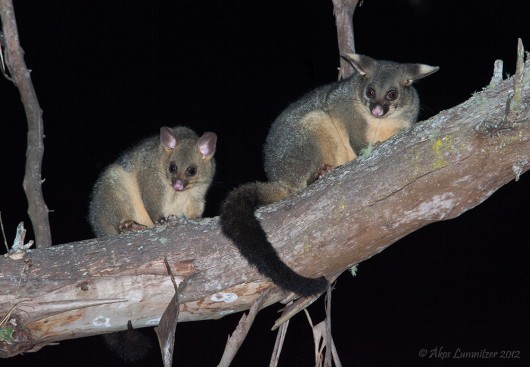 Australia’s native Brushtailed Possum (Trichosurus vulpecula)
Click image to enlarge
Australia’s native Brushtailed Possum (Trichosurus vulpecula)
Click image to enlarge
[Image courtesy of Ákos Lumnitzer, ^http://amatteroflight.com/]
.
Australian Possums were introduced by New Zealanders to New Zealand in 1837
.
Brushtail Possums are native to Australia but a destructive introduced pest in New Zealand.
Yet is ‘Possum Merino‘ New Zealand’s ethical solution to its pest control or really just perpetuating a backward 1837 Fur Trade?
After all, it was New Zealander colonists in 1837 who sailed to Tasmania and to the east coast of Australia to poach Australian Brushtailed Possums and export and introduce them into defenceless New Zealand so as to establish a selfish fur trade. Who else is to blame?
So thanks to colonists, Brushtail Possums have unquestioningly since become a destructive colonising pest to New Zealand, just like so many others –
- Stoats
- Domestic cats
- Chamois
- Deer
- Ferrets
- Goats
- European hedgehogs
- Horses
- House mice
- Rabbits
- Rats
- Himalayan tahrs
- Wallabies (also poached from Australia by colonial New Zealanders)
- Weasels
- and arguably all non-Maori humans.
.
Introduced New Zealanders and their descendants professing natural New Zealand justice need to frankly pull their imposive self-righteous heads in.
.
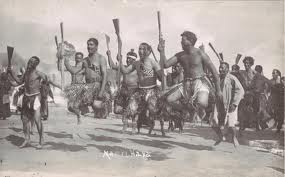 A Maori traditional Haka A Maori traditional Haka
.
Probably the most relevant and credible authority on this centuries old problem of human introduced possums into New Zealand should be New Zealand’s own Department of Conservation (DOC). Yet DOC has no watchdog to vet its possum control policy, to evaluate the ethics of its indiscriminate aerial 1080 poison programmes, its budget decision making, its pest control methods.
New Zealand Department of Conservation is its own master, answerable to no-one. It dictates possum control and culling only on the basis of it deeming it administratively cost effective and efficient. Perhaps this is a leftover culture of Rogernomics applied to lean management of New Zealand’s ecology. On the New Zealand Department of Conservation website, the possum problem in New Zealand is clearly explained. An issue this author accepts as a serious ecological problem facing New Zealand.
Under the heading 3.3 Possum Damage to Native (NZ) Forests, the possum problem in NZ is explained as follows:
“Over the past 50 years, possums have emerged as one of the major threats to the health and wellbeing of forests throughout New Zealand. Many of these impacts are subtle and indirectly affect native birds and insects. Possums cause damage to native forests from the ground level to the canopy where, by concentrating on individual plants of their preferred species, they can kill trees by defoliation over several years. Possums preferentially feed on some of the tall canopy species – such as tawa, northern rata, kohekohe, southern rata, kamahi, pohutukawa and 20 Hall’s totara – while ignoring others. They also prefer some of the smaller trees, such as tree fuchsia and wineberry, along with mistletoe, forest herbs, some ferns, and a number of endangered shrubs.
It is difficult to imagine that possums, which are about the size of a large cat, can kill individual trees that have dominated forest landscapes for centuries before possums were released here. But when the number of possums is combined with the total amount each one eats, their impact on their preferred species is easier to appreciate. The amount of food consumed by an adult possum each night is about 160 gm of digestible dry matter. There are probably tens of millions of possums living in native forests. In total, possums are consuming thousands of tonnes of vegetation each night.
Possum populations have now modified many New Zealand forests. The rate and extent of these changes vary widely between different types of forests. Beech forests are the least affected, but in the vulnerable southern rata-kamahi forests of Westland many valleys have lost between 20% to 50% or more, of their canopy trees. In severe situations, possums have caused the complete collapse of the canopy within 15–20 years of their arrival. Tall forest is then replaced by shrublands.
While the impact of possums is most visible and dramatic when it involves canopy trees, their most pervasive impacts are often less visible. Possums have recently been described as “reluctant folivores”. This means that possums prefer to eat other forest foods than the leaves of trees. Flowers, fruit, leaf buds, fungi and insects are all highly favoured. The consumption of these foods has the largest impact on the healthy functioning of forests and the animals that rely on them. The consequences of possums concentrating on these foods are:
.
Loss of Flowers:
.
- Preventing the formation of seeds
- Removing nectar sources for birds and bats
- Reducing the food supply for many invertebrates
- Nectar loss reducing food supplies for chicks, e.g. kaka, tui.
.
Loss of Fruits:
.
- Reducing food supplies for birds and invertebrates
- Affecting bird breeding condition and nesting success, e.g. kakapo, kereru
- Reducing or eliminating seed dispersal
- Reducing the regenerative capacity of native plants.
.
Loss of New Shoots:
.
- Reducing the ability of plants to overcome leaf loss from weather and seasonal patterns
- Reducing numbers of new leaves, jeopardising plant health.>>
.
New Zealand Department of Conservation also states that “the damage to native forests can be seen all too clearly in many areas. Possums ignore old leaves and select the best new growth. In some areas they have eaten whole canopies of indigenous Rata, Totara, Titoki, Kowhai and Kohekohe.
Possums also compete with New Zealand native birds for habitat and for food such as insects and berries. They also disturb nesting birds, eat their eggs and chicks and may impact on native land snails.
New Zealand Department of Conservation cites examples of natural vegetation damaged by possums at Pirongia Forest Park, and the upper canopy of NZ native forest trees on the slopes of Mt Karioi, south of Raglan.”
So, assuming New Zealand Department of Conservation’s account is correct, the introduced Brushtail possum is a serious pest to New Zealand (NZ) native ecology.
But what to do about it?
.
What should Australia responsibly do – repatriate back its possums?
.
It’s long overdue for the New Zealand Government to get serious about its self-caused possum problem and look to resolve it once and for all for the benefit of the New Zealand ecology and the possums themselves. It needs to look at the root causes.
The possum was introduced to New Zealand by New Zealand profiteering colonists.
 Many New Zealanders conveniently forget:
It is not the possum’s fault it is in New Zealand. Many New Zealanders conveniently forget:
It is not the possum’s fault it is in New Zealand.
.
However, pouring $80 million a year of New Zealand taxpayers money into cruel indiscrimate aerial baiting is not working. If it was the possum problem would be reducing and there would not be a burgeoning possum fur trade.
Instead of perpetuating a 19th Century immoral fur trade, in order to control possums and other introduced pests in New Zealand, one option is to catch and relocate them back to their native home country habitat. This may seem highly expensive and labour intensive and far fetched, but what other option is both humane and effective?
It’s not the possums’ fault. New Zealand colonists introduced them from Australia to New Zealand. The problem is an inherited inter-generational problem caused by New Zealand colonists. It shoud be solved by their descendants, not perpetuated as a fur trade.
Acknowledging the possum in NZ is an introduced pest, the question in this case is whether the possums in New Zealand are being killed humanely and whether this is being effectively monitored by a government watchdog worthy of the public trust?
By killing possums, humans have a moral obligation to do it humanely. Possums like all animals are sentient beings and so feel pain, fear and suffering.
.
New Zealand sprays 1080 poison over its native forests
.
New Zealand Department of Conservation’s official choice of death is aerial baiting with the the literally cheap and very nasty poison ‘1080’ (‘ten-eighty’, or Sodium Monofluroacetate).
New Zealand Department of Conservation’s argues it is humane and safe.
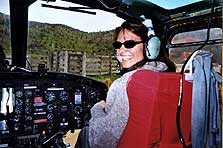 Heading out to drop 1080 poison across NZ forests
(a smiling assassin) Heading out to drop 1080 poison across NZ forests
(a smiling assassin)
.
But The World League for Protection of Animals argues otherwise and offers the following explanation about ‘1080’ poison.
“1080 (sodium monofluroacetate) is a cruel and indiscriminate poison used to ‘remove’ unwanted populations of animals.
Banned in most countries, 1080 is still used liberally throughout Australia to control so-called ‘pest’ species, and reduce ‘browsing damage’ caused by native animals on private land.
1080 poison is a slow killer. When ingested (usually through baited food) the animal suffers a prolonged and horrific death. Herbivores take the longest to die – up to 44 hours, while carnivores can take up to 21 hours before finally succumbing to final effects of the poison. The speed of death is dependent on the rate of the animals metabolism.
.
1080 Poison Causes a Slow & Horrific Death
.
Witnesses to the deaths of herbivorous animals, such as macropods, have reported:
“Affected wallabies were sometimes observed sitting hunched up, with heads held shakily just above the ground. Generally they appeared non-alert and ‘sick’, with shivering or shaking forelimbs and unsteady balance. Most individuals then experience convulsions, falling to the ground and lying on their backs and sides, kicking and making running motions with their hind legs before dying. Many individuals also ejaculated shortly before death, and, with others, exuded a white froth from their nostrils and mouth.”
Carnivorous animals such as dingoes, dogs, foxes, and cats become very agitated, as they tremble, convulse and vomit.
.
Animal symptoms of eating 1080 poison:
.
“…restlessness; increased hyperexcitability; incontinence or diarrhea; excessive salivation; abrupt bouts of vocalization; and finally sudden bursts of violent activity.
All affected animals then fall to the ground in teranic seizure, with hind limbs or all four limbs and sometimes the tail extended rigidly from their arched bodies. At other times the front feet are clasped together, clenched or used to scratch frantically at the cage walls.
This tonic phase is then followed by a clonic phase in which the animals lie and kick or ‘paddle’ with the front legs and sometimes squeal, crawl around and bite at objects. During this phase the tongue and penis may be extruded, their eyes rolled back so that only the whites show and the teeth ground together. Breathing is rapid but laboured, with some animals partly choking on their saliva. Finally such individuals begin to relax, breathing more slowly and shallowly and lying quietly with the hind legs still extended but apparently semiparalysed”.
From the above descriptions, it is without question that 1080 poison inflicts great pain and suffering on affected animals. Aside from the physical pain endured over the many hours before death, the terror, fear and anxiety felt by these animals is unimaginable.”>>
.
.
The main reason why the New Zealand Department of Conservation uses 1080 is simply because it is cheap. Dropping it it indiscriminately by air is efficient and convenient.
Whereas setting caged traps for possums is expensive. Using poisons that act faster that 1080, such as cyanide is also more expensive.
So the New Zealand Department of Conservation’s key justification for its use of 1080 is one of cost.
It also justifies using 1080 because other countries use it for pest control, like Australian & the USA , so implying that 1080 must therefore be ethically acceptable. But New Zealanders should make up their own mind and should recall that both the USA and Australia used Agent Orange in The Vietnam War.
The Department of Conservation also justifies 1080 use because NZ has no natural mammals so the risk to non-target species are nil. But this claim is FACTUALLY INCORRECT!
On 30 July 2008, The Dominion Post reported that after a Department of Conservation aerial drop of 1080, seven kea had died at Fox Glacier from eating the 1080 poison, wiping out almost half a group of the endangered and protected parrot being monitored by the Conservation Department. DOC came up with excuses, but with such an endangered bird with so few kea left on the planet, DOC cannot afford to gamble with the kea’s extinction.
Anti-1080 campaigner Mike Bennett said the kea deaths were the tip of the iceberg. “These are only the monitored ones. If that percentage is extrapolated for the entire population, that doesn’t leave many for the next drop” and has called for a ban on all aerial 1080 drops in alpine areas.
.
New Zealand is not reducing possum numbers, just perpetuating its 1837 Fur Trade
.
New Zealand’s own backyard fur trade has seen a recent resergence since the 1830s when New Zealand hunters first introduced the possum to the wilds of New Zealand. the traditional method of possum slaugher is by trapping. For nearly two centuries the cruel ‘gin trap’ with serrated jaws was used. Although the trapping laws have recently banned gin traps, leg-hold traps remain the method of choice for trappers.
According to the NZ Lifestyle Block website:
“Leg-hold traps such as the ‘Lanes Ace’ or ‘Gin Trap’ have been widely used for possum and rabbit control for many years. The gin trap is more than 10.5 cm across its open jaws, which are serrated, and it is powered by a flat metal spring, so it’s a “size 1½ long spring” trap.
Traps of size 1½ or larger are more likely than the smaller traps to snap shut across the belly or chest of an animal. Although larger traps have been banned, traps of size 1½ can still be used if they are powered by double-coil springs. From January 2011 they will have to be padded, and you can’t modify them yourself to make them padded…
.
Why are these traps cruel?
.
When the gin trap snaps shut on its victim, the teeth bite into the skin and can cause a lot of trauma and no doubt agonizing pain.
All leg-hold traps are indiscriminate about what they catch. If they are set in possum tracks or runs it’s more likely than not that any catch will be a possum, but it might also be a cat… rat, bird or small dog. Large dogs can sometimes pull out of them but they may be injured in the process.
.
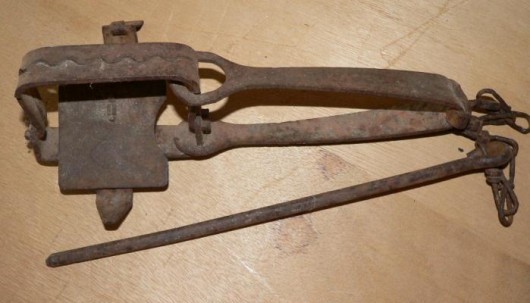 Possum Trappers preferred weapon of choice: the ‘Lanes Ace’ or ‘Gin Trap’
Widely used for possum trappers in New Zealand for many years. Possum Trappers preferred weapon of choice: the ‘Lanes Ace’ or ‘Gin Trap’
Widely used for possum trappers in New Zealand for many years.
.
Icing sugar or flour around traps is sometimes used to attract possums, but if used beneath a trap the animal is likely to be trapped by its snout or head.
.
What are the alternative leg-hold traps?
.
In New Zealand it is still legal to use size 1 leg-hold traps such as the Victor within the restrictions on location and setting described above. It is smaller than the gin trap and doesn’t have serrated jaws.
The ‘Victor No 1‘ can be bought with cushioned inserts that make it more humane. It tends to cause less frequent and less severe injuries than the gin trap and larger leg-hold traps, but it can still cause severe bruising, and trapped animals will sometimes cause themselves severe injuries in their struggle to get free.
Trappers favour the Victor No 1 because it is compact, light and relatively efficient. The changes in the legislation mean that it is likely to become even more popular.
There’s good advice for landowners on the most humane way to use leg-hold traps and their alternatives on the National Possum Control Agencies website (www.npca.org.nz), and not just for possums but for ferrets too.”>>
.
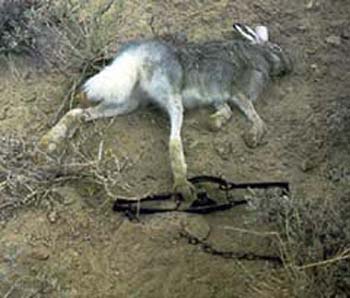 Rabbit caught and dead in Lanes Ace Trap.
The steel jaws of the trap break the rabbit’s leg and it dies of pain and suffering over days.
These are used in New Zealand in the possum fur trade
[Image Source: ^http://www.animalwritings.com/archive/2004_08_01_blog_archive.asp] Rabbit caught and dead in Lanes Ace Trap.
The steel jaws of the trap break the rabbit’s leg and it dies of pain and suffering over days.
These are used in New Zealand in the possum fur trade
[Image Source: ^http://www.animalwritings.com/archive/2004_08_01_blog_archive.asp]
.
Typical traps used in New Zealand for possums are the flat jaw/leg hold’ type such as the ‘Bushmaster‘. While recognised as more humane that the serrated jaw ‘gin trap’, it can still cause suffering to a trapped animal, and of course is indiscriminate.
The Hamilton City Council on the North Island prohibits the use of leg-hold traps such as gin traps in residential areas and within 150 metres of dwellings or places where there are likely to be pets. It instead recommends Cage Traps and Timms Traps for possums and other feral animals.
.
New Zealand’s 1837 Possum Fur Trade now globally profitable!
.
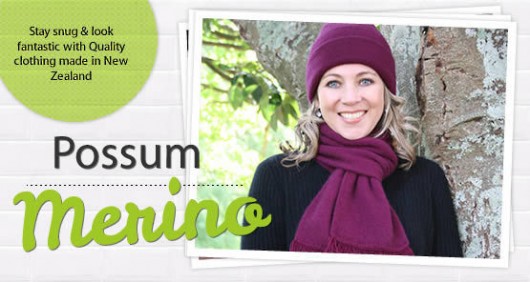
The justification spin:
.
<<…Possums were introduced into New Zealand by the caring, sharing Aussie cousins in the 1870s, to get the fur trade going. [Ed: How do we know it was not New Zealand colonists returning to New Zealand that introduced the possum?] Unfortunately what the possums did is have a fabulous time in the New Zealand climate, and aided by the decline in the fur industry, increased their numbers to over 70 million today.
Possums are a pest in New Zealand. Not only do they manage to consume approximately 21,000 tonnes of vegetation every night, but they are also killing native birds, and generally upsetting the ecological balance. Many native trees, plants and birds, including the Kiwi, are under threat of extinction because the possum is destroying their habitat. A possum will visit the same tree night after night and eat away until the point where the tree cannot recover. It has also now been confirmed that possums will eat both the eggs and chicks of the native Kiwi and Kokako. Where Australian plants have their own defences against the possum, NZ plants do not. The possum has no predator in NZ. Regular culling has been carried out under government supervision since the 1940s and it is estimated to cost around £20 million each year.
Very interestingly, the World Wide Fund for Nature does acknowledge that possums need to be controlled.
Although the culling began in the 1940s, it has only been in the last 30 years that good use was made of the resulting resource.
Kiwis (the human ones!), known for their ability to fix anything with a piece of no. 8 fencing wire, are a bit of an ingenious lot. They’ve managed to turn the pest into an export commodity. Possum meat goes to Asia (have you eaten ‘Kiwi Bear’?!), and the pelt is used for any number of commodities as it has properties that lend itself to both warmth and protection. New Zealand is the only place in the world where possum fur can be harvested.>>
[Source: ^http://www.kiwikate.co.uk/]
.
Ed: The British colonial New Zealander’s cultural inferiority complex with nearby Australia is manifested in a hatred for Australian Possums.
Proud in denial, the fact is that colonial New Zealanders in 1837 chose to sail to Australia to capture the species and voluntarily introduce the Brushtailed Possum to New Zealand.
In 1837, Australian possums didn’t want to go to New Zealand. Colonial Australians at the time probably took no interest in a few New Zealanders taking wildlife for their own gain. Maoris atthe time probably were unaware, had no say then anyway, but would have challenged the introduction had they been duly informed.
Kiwi Kate’s reference to “caring, sharing Aussie cousins” sadly reflects bigotry out of her misinformed upbringing.
.
Use of Feratox (cyanide) Poison?
.
According to the Lifestyle Block website NZ veterinarian Dr Marjorie Orr, BVM&S, PhD, BA and lifestyle farmer on , the most humane method of possum control is to use Feratox capsules, which is an encapsulated cyanide.
The preferred baiting method is to use these in specially designed “bait stations or sachets stapled to trees, baited with peanut butter (possums like it and dogs and birds usually don’t). The pest control companies that put out the poison will usually on request remove the sachets after a few days, and this helps reduce the risk of accidental poisoning of other animals. The poison in the capsules, cyanide, is quickly destroyed on exposure to air. Death is quick and relatively stress-free and there is no risk of secondary poisoning of dogs that scavenge poisoned carcases.”
The test of humane killing must be conditional on the absence of pain and stress caused to the animal and that the killing be very quick.
But the killing of a native animal is wrong, despite it being introduced by humans. It has become a convenient excuse for New Zealanders to kill possums. Possum control by either DOC or the fur trade is not effective and in both cases the chosen methods are inhumane.
.
New Zealand’s possum problem has been allowed to escalate into an immoral industry for profiteers.
The New Zealand Government is responsible for failing to deal with the problem effectively and humanely.
It has perpetuated an immoral fur trade that begun in the 19th Century, and at the same time allowed much irreversible harm to be caused to New Zealand’s fragile ecology.
.
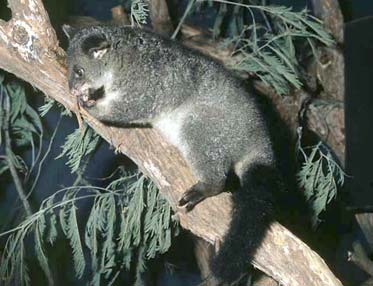 . .
Possum Comments:
.
‘The legacy of human ignorance and delinquency is enormous’
(Vivienne 20091205) :
.
<<Research has begun recently into biocontrol of brushtail possums as the only long-term, cost-effective solution to the possum problem in New Zealand, where possums cause significant damage to native forests, threaten populations of native plants and animals, and infect cattle and deer with bovine tuberculosis.
see the abstract for the CSIRO report
Immunocontraception is a humane means of controlling possums with wide public acceptance.
Although several studies have investigated or modelled its demographic consequences, there have been few studies of the possible effects of the presence of sterile females on local males.
Implications for biological control
Cynanide kills more quickly than 1080, but no less violently. Researchers have called this death humane!
Food is provided in a feeder for a few of days to lull the animals into a false sense of security. Then their trust is betrayed with the food being replaced with encapsulated cyanide pellets. The animals die within metres of the feeding station.
Possums are endearing little animals and what they suffer is horrific! The legacy of human ignorance and delinquency is enormous! Our colonial attitudes continue to haunt us today, with species continually threatened and made extinct by human expansion and self-interests.>>
.
‘Fertility controls the only longterm option for NZ possums’
(Pat, 20091207)
.
<<Fertility controls the only longterm option for control NZ possums, anything else is only a bandaid. We have the technology to do this, it only needs some more research and it could proceed. Its crazy to allow unwanted animals to breed out of control, then cruelly kill them, 1080 or not.
40 years ago we put a man on the moon….and then bought him safely back….and yet we cant humanely solve the NZ possum problem? I dont believe it! The NZ DOC appears to be as incomptent and as useless as our own Australian wildlife bureacracies.>>
.
‘NZ possums’
(Possum lover, 20091208):
.
<<As always- the real pest is the human.
However, I can see from this article that the New Zealand environment would be better off without the Brush Tail Possum. Apart from the cruelty a possum fur industry makes little sense as it would rely on a sustainable population of the animals – and this would mean continued deleterious effects on the environment. Bringing millions of animals back to Australia seems extremely impractical as I think there would be a lack of habitat and how would one round them all up? Human population growth is continually robbing possums of habitat in Australia even though they are very good at sharing with humans.
The poisoning and trapping options are not acceptable at all- and anyway — it seems clear that whatever they are doing in NZ to reduce the population of possums — they are not being effective, anyway !
(As I write this I hear on radio National that a few hundred camels will be shot in central or northern Australia because their numbers have got out of hand and they come close to human settlements looking for water. Who brought the camels to Australia? Who put them to work in opening up the centre of the continent.? Who abandoned them to the wild when they had served their purpose?)
Back to the possums- realistically it seems to me that it’s a choice of either accepting the possums and a changed environment (just as humans changed the ecosystem by extinguishing the moa) or making a concerted effort to humanely totally eradicate the animals from NZ. There is no point in partially reducing the population as more possums will fill the available habitat.
More info on the practicalities of sterilisation would useful. If only there was a measure of the suffering that humans inflict on each other and on other animals. All other suffering on the planet would be dwarfed by this measure.>>
.
‘New Zealand complacent about its wildlife’
(Tigerquoll, 20091208):
.
Yes, I agree the real pest is the human. Yes, I agree the New Zealand environment would be better off without the Australian Brushtail Possum.
To round up and try repatriating the many Brushtail possums in New Zealand back to Australia would be extremely impractical. Do we know the numbers and their geographic concentrations? Assuming the possum are on both islands, can one island be targeted first?
Where would they be repatriate to? Possums are territorial mammals. Even in Australia native wildlife experts claim that it is not possible to relocate possums, which poses problems for both possums already in Australia and for the reintroduced possums. The cost exercise would highlight the extent of the problem and the real costs of New Zealand having neglected a serious pest invasion for nearly two centuries. This reinforces the scale and complexity of introduce pest problems when left ignored.
But what is the alternative that is both ethical and effective?
The sterilisation science sounds encouraging, yet even then ‘immunosterilization’ as it is formally labelled has questions about efficacy of fertility control, the means for delivering antigens. Then there are the potential legal and social concerns that relate to the possible future use of antigens.
But I do recommend this is where the $80 million of New Zealand taxpayers money should be diverted instead of indiscriminate 1080 drops by helicopter. Question is why has the New Zealand Government become so complacent about seeking a humane and effective permanent solution?
Australia’s feral camel problem in central Australia is comparable to New Zealand’s possum problem. I understand they will be shot, which suggests a faster clean kill (so long as the shooter is a trained marksman with appropriate knowledge of camel to effect a single round quick kill, rather than some recreational shooter), but what to do with the carcasses? Is shooting humane and ethical? Is shooting the only answer, or is it just the cheapest and nastiest quick fix coming from some staffers desk? Could these camels not be herded and shipped live back to their native country in the Middle East or North Africa or from wherever their ancestors originated?
Question again is, why has the Australian Government also ignored the feral camel problem for so long to allow it to build to becoming so numerous and widespread?
I am not in favour of New Zealand ignoring its possum problem, because such a defeatist stance would only perpetuate further destruction of New Zealand’s forest ecology and to inevitable local extinctions of native flora and fauna. It would also encourage the perpetuation of New Zealand’s immoral fur trade, which is no different to Canadians commercially clubbing fur seals.
Is the New Zealand Government just as complacent with its Biosecurity? Less than a month ago Queensland cane toad was found in an Australian tourist’s hiking boot in Queenstown on the South Island. All it needed was a mate and it would have been off and breeding. “A MAF biosecurity spokeswoman confirmed the toad arrived last Tuesday but was not spotted.”>>
[SOURCE: ‘Cane toad evades Kiwi airport biosecurity’ , by Tamara McLean, AAP, 20091126. Read More: ‘Cane toad catches ride to Queenstown’, by Will Hine, Fairfax NZ, ^http://www.stuff.co.nz/national/3098565/Cane-toad-catches-ride-to-Queenstown]
.
.
Footnote:
.
It makes it hard for New Zealand’s Department of Conservation to act to properly address New Zealand’s chronic feral possum infestation, when the government sacks 140 of DOC’s staff demanding it cut $8.7 million in operational expenditure…
.
‘DOC cuts 140 jobs’
[Source: ‘DOC cuts 140 jobs’, 20130326, by Michael Daly, Fairfax NZ, ^http://www.stuff.co.nz/national/politics/8471779/DOC-cuts-140-jobs]
.
<<The Department of Conservation (DOC) has announced plans to cut about 140 largely regional management and administration positions. The job losses are part of a reorganisation under which DOC’s existing 11 regional conservancy boundaries will be replaced with six new regions.
DOC director-general Al Morrison says the new structure would maintain DOC’s own conservation delivery work while setting the department up to work more effectively with external partners.
“DOC must adapt if it is going to meet the conservation challenges that New Zealand faces – even if you doubled DOC’s budget tomorrow we would still be going ahead with this proposal.”
DOC would continue to operate out of the same number of offices as now with more than 1200 operational staff, Morrison said. About 118 management and administrative positions would go as a result of the new flatter organisation. A further 22 operational roles would be cut through efficiencies gained by setting up new support hubs for activities such as asset management, inspections and work planning.
The size of the proposal was aimed at ensuring DOC met its $8.7 million savings targets and continued to meet its current delivery work.
.
[Ed: This should pay for John Key’s $7 million funding to Immigration New Zealand to “increase visitor numbers by smoothing processes at the border” ^http://www.nzherald.co.nz/business/news/article.cfm?c_id=3&objectid=10878911].
.
A conservation partnerships group would be set up focused on working with community groups, iwi, local authorities, private landowners and businesses to attract more resources to conservation, Morrison said. Recreational and natural heritage field work would be the responsibility of a conservation services group.
Consultation with staff about the proposals had started and no final decisions would be made until staff feedback had been considered. Any changes would not take effect for some months.
“I acknowledge this will mean a difficult period for many staff and we will be making every effort to ease the impact of these proposals,” Morrison said.
A freeze on hiring new staff had been in place and about 160 positions were filled with temporary staff. “It is simply too early to say what impact these proposals will have on individuals – we will look at all options such as redeployment and relocation to minimise redundancies.”
.
‘GAPING HOLES’
The Green Party earlier today predicted the proposal was to axe 140 jobs.
“With the department already pared to the bone these latest cuts will mean less protection of our special native plants and wildlife,” Green Party conservation spokesperson Eugenie Sage said. “DOC manages more than a third of the land in New Zealand and the argument that volunteers and a few corporate sponsors will fill in the gaping hole these cuts and continued pressure on department spending create is nonsense.
“National is trying to turn DOC into a corporate entity focused on stakeholders and corporate sponsorship at the expense of its key role to to protect and preserve native plants and animals,” Sage said. “This National Government is toxic to the environment and is polluting, digging up and selling our children’s future.”
Prime Minister John Key this morning said the department was over-staffed with middle management and bureaucracy. “What you have seen is, over the good times under a Labour government a big buildup in kind of the middle management and bureaucracy, and in the leaner, harder times where the Government doesn’t have a lot of money to throw around, we don’t have that much money,” he said.
.
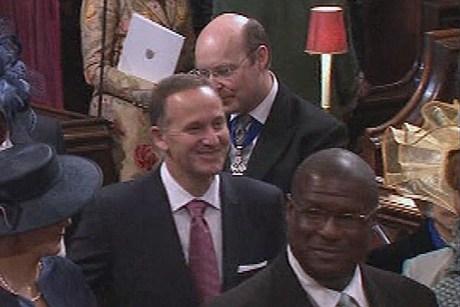 King of Overseas Holidays, John Key,
He flew first class with his wife to attend a foreign royal wedding on 20110429
Here he’s looking resplendent in his bespoke $6,000 suit washed with pounamu.
Total cost of Key Junket which did nothing for New Zealand, NZ$200,000? King of Overseas Holidays, John Key,
He flew first class with his wife to attend a foreign royal wedding on 20110429
Here he’s looking resplendent in his bespoke $6,000 suit washed with pounamu.
Total cost of Key Junket which did nothing for New Zealand, NZ$200,000?
.
.
“Government agencies now needed to be leaner, and more efficient”, Key said. He compared the restructuring to a similar exercise at Telecom, which was expected to axe hundreds of jobs this year.
“If you go and look at what is happening at Telecom at the moment, on a different scale … but no-one is arguing that the chief executive isn’t doing the right thing trying to make sure that organisation is leaner and more efficient,” he said. The Government had a responsibility to taxpayers, he said.
“The management at DOC have a responsibility to ensure that their resources are directed in the right place and that is what you are going to see today,” Key said>>
.
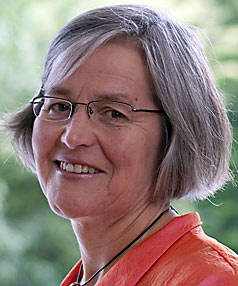 Ms Eugenie Sage
Green Party of Aotearoa representative: Ms Eugenie Sage
Green Party of Aotearoa representative:
.
“National is trying to turn DOC into a corporate entity focused on stakeholders and corporate sponsorship at the expense of its key role to protect and preserve native plants and animals”.
.
Tags: 1080 poison, Brushtailed Possum, Cage Traps, cyanide baiting, Feratox, Gin Trap, KiwiKate, Lanes Ace Trap, New Zealand, New Zealand Department of Conservation, NZ DOC overstaffed, NZ Fur Trade, PM John Key, Possum Damage to Native (NZ) Forests, Possum Merino, World League for Protection of Animals
Posted in Possums and Gliders, Threats from Poaching and Poisoning | Comments Off on Brushtail Possum a NZ backyard Fur Trade
Add this post to Del.icio.us - Digg
Sunday, March 17th, 2013
[The following article was initially posted by Tigerquoll under the title “Basically a Fur Trade…”SKIN THE BEST and PLUCK THE REST” and published on 20091209 on ^candobetter.net]
.
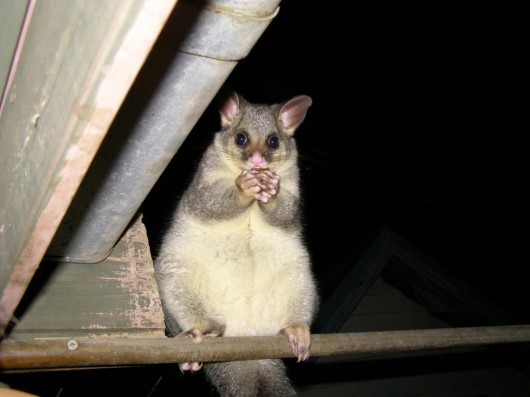 Brushtail Possum (Trichosurus vulpecula) a native to the Blue Mountains, Australia
(Photo by editor in winter, 20100606, click image to enlarge, © ^Creative Commons ) Brushtail Possum (Trichosurus vulpecula) a native to the Blue Mountains, Australia
(Photo by editor in winter, 20100606, click image to enlarge, © ^Creative Commons )
.
<<When the Australian Brushtail Possum was first released into New Zealand in 1837 (becoming successfully established around 1858) with the express purpose of establishing a fur trade, our colonial New Zealand forefathers had no idea of the terrible impact that possums would have on the delicate natural balance of the native New Zealand ecosystem.>>
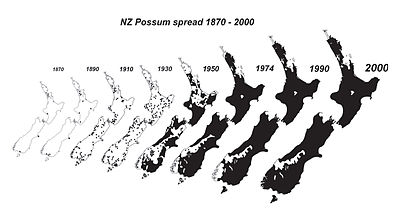 [Source: ‘The history of possums in New Zealand’,
^http://www.gorgeouscreatures.co.nz/NZ+Possum+Fur/Possum+History.html] [Source: ‘The history of possums in New Zealand’,
^http://www.gorgeouscreatures.co.nz/NZ+Possum+Fur/Possum+History.html]
.
On New Zealand’s North Island at the Bay of Plenty, a backyard possum fur trader, BASICALLY BUSH, runs a thriving business slaughtering Brushtail Possum for profit. It’s just like the good ol’ days of the 19th Century.
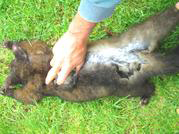
It seems the preferred kill method is by shooting…“Be careful not to get rubbish into the bag, and that you don’t end up dropping bullets or spent shells in.” But then they sell traps to possum poachers as well, so take your pick. Check out the possum trap called ‘Bushmaster No 1’:
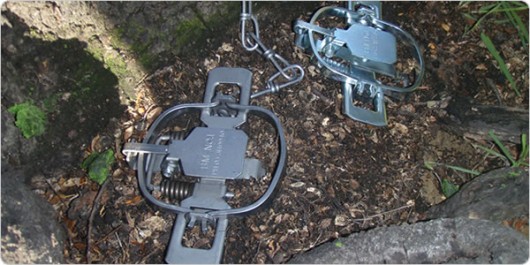 Steel Jaw Cruelty – NZ style Steel Jaw Cruelty – NZ style
.
A good sound trap, leg hold. Freight Costs incl GST: 1 – 12 traps: $6.50 12 – 24 traps: $17.00 24 – 48 traps: $25.00 48 – 96 traps: $65.00 Please add the cost of freight to your payment.
Basically Bush’s motto is “SKIN THE BEST and PLUCK THE REST”
It claims “this exciting raw material that has revolutionised the knitwear industry in New Zealand. Possum fibre is referred to as ‘possum merino’ and is promoted as ‘lighter than cashmere’.”
And profits are healthy. Back in 2007, “there has been a marked increase in fibre availability since we raised the price to $105/kg. “This increase was necessary to make sure that there was enough raw material to meet the needs of domestic production.”
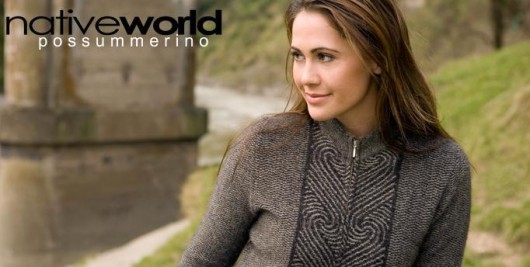 Not eradicating a feral animal population
But instead profiting and perpetuating an 1837 NZ Fur Trade Not eradicating a feral animal population
But instead profiting and perpetuating an 1837 NZ Fur Trade
.
These pest controllers have now gone international, making trips to India to promote fur sales, with brands like ‘Snowy Peak’ and ‘Woolyarns’.
Click here to meet the poaching team.
Colonial New Zealanders relocated Australian Brushtail Possums to New Zealand from the early 19th Century. Kiwi possum poaching currently just perpetuates the slaughter for the same reason as then – possum fur, not to eradicate them at all.
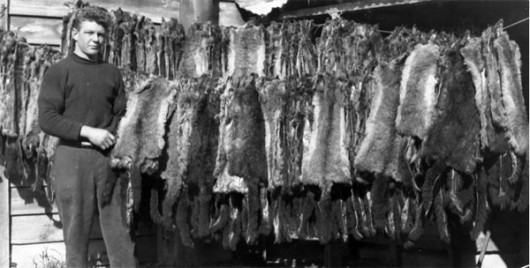
Anyone who takes exception to killing possums in large numbers (i.e the definition of ‘slaughter’) should be contributing alternatives. But profiteers like Basically Bush seem to be condoning the poaching practice. The numbers are not reducing, but the profiteers are making a killing. How backward!
What is the right way to remove introduced animals? It remains an avoided Kiwi ecological problem.
.
Illegal traps discovered in Makara bush
.
[Source: ‘Illegal traps discovered in Makara bush’, 20120731, Dominion Post, Wellington, New Zealand, ^http://www.stuff.co.nz/dominion-post/news/northern-suburbs/7384752/Illegal-traps-discovered-in-Makara-bush]
.
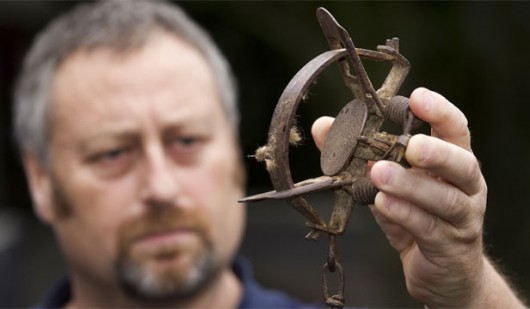 SPCA Inspector Ritchie Dawson with a banned inhumane possum trap
found in Makara Forest
(Photo by Maarten Holl) SPCA Inspector Ritchie Dawson with a banned inhumane possum trap
found in Makara Forest
(Photo by Maarten Holl)
.
Inhumane possum traps were discovered dotted throughout a Makara forest. A dead possum in an illegal trap dragged home by a family dog leading to the discovery of inhumane trapping on the block.
Brent Lyell Still, of Upper Hutt, was yesterday convicted of using the illegal traps.
Guy Holmes’ called the SPCA after his dog came home dragging a leg trap in August last year. Mr Holmes told the animal welfare inspectors he found 10 possums in traps and had to kill them. The SPCA found traps had been set on Mr Holmes’ land and his neighbour’s to catch possums.
Carcasses taken to a vet showed crush injuries that would cause distress and significant pain before death.
Mr Holmes had planted pine trees on his Makara Rd property intending to mill them and had never given permission for the traps to be set on the property.
Still, 45, yesterday pleaded guilty and was fined $300 and ordered to pay costs of $353.22 for illegally using size 1.5 leg traps, which were banned at the beginning of last year.
It was the first time someone has been prosecuted for using the illegal traps. The traps grab a possum, most often by the leg, which can be crushed.
A further charge of setting traps that could entrap companions animals like dogs and cats was withdrawn. Still had been asked by the neighbour to do the trapping but had laid several traps on Mr Holmes’ property as well. In three days he killed over 600 possums.
Still’s lawyer Tim Blake said Still had been trapping for 20 years and had not known the law had changed. Wellington District Court judge Bill Hastings agreed with Mr Blake that there had been little publicity about the recent law change but said ignorance of the law was no excuse.
Judge Hastings said despite possums being pests, there was still an obligation to treat them humanely. To set the traps in place, a nail is driven into the tree.
SPCA prosecutor Liz Hall said any nail found in a tree at a mill would result in all logs being rejected by a mill because of the dangers of metal going through machinery. Blake disputed there would have been any problem, saying the nail was set only a couple of inches from the ground and the trees would be cut down higher than that.>>
.
Friday, February 8th, 2013
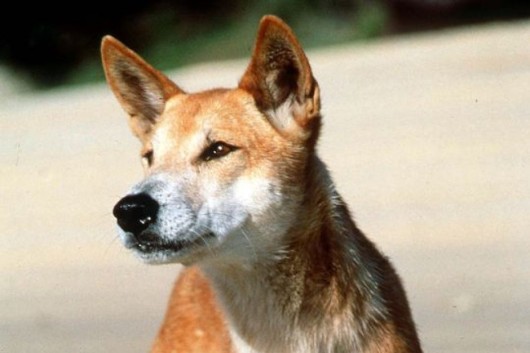 Australia’s native Dingo
Dingo Persecution must end! Public perception has to change.
(Photo credit AAP, Jim Shrimpton) Australia’s native Dingo
Dingo Persecution must end! Public perception has to change.
(Photo credit AAP, Jim Shrimpton)
.
Dingo numbers have been reduced due to extreme uncontrolled overuse of the deadly 1080 bait, and the colonial cultural persecution of Australia’s top order predator, the Dingo.
<<But scientists say governments need to seriously consider reintroducing dingoes to the landscape in order to protect vulnerable native species.
Dingoes cause hundreds of thousands of dollars damage each year to livestock and there have been huge efforts to cull them by laying poisonous baits and shooting them. But this has allowed feral species like cats and foxes to thrive and experts say the current approach is counter-productive.
.
About 40% of the country’s native species are listed as threatened or close to extinction, thanks to the explosion in numbers of feral cats and foxes.
.
Dr Tony Friend, the president of the Australian Mammal Society, says trying to control these animals is a losing battle.
“We are getting reasonably good at controlling foxes in the local areas but cats are a huge problem, partly exacerbated by removing foxes, so once the foxes are taken out, cats do well and basically step into the feet of the foxes,” he said.
Research is being conducted Australia-wide to see if bringing back dingoes will help control these pests. One recent study in South Australia’s north recorded a reduction in feral cat and fox numbers with the introduction of dingoes.
Hannah Spronk from Arid Recovery, a conservation group based just outside Roxby Downs, is heading the research.
“All seven of the foxes that we released into that pen there were killed within 17 days by the dingoes,” she said. A night photo of a feral cat with a fairy prion in its mouth.
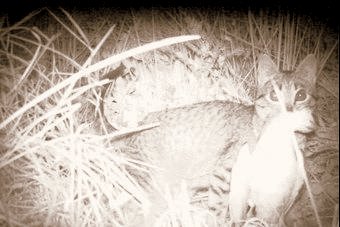 A feral (dumped) cat with a native bird in its mouth in Tasmania
(Photo credit of Parks and Wildlife Service, Tasmania) A feral (dumped) cat with a native bird in its mouth in Tasmania
(Photo credit of Parks and Wildlife Service, Tasmania)
.
“They did autopsies I suppose you could say and the deaths were attributed to attacks by dingoes. All six of the feral cats that were in the pen died within 20 to 103 days after release.”
Dr Menna Jones, from the University of Tasmania, is looking at reintroducing top order predators to rebalance specific ecosystems. As well as dingoes, she is finding out whether the Tasmanian devil could also control invasive species.
“If we can put a large predator back into the ecosystem where it has become extinct, it can do the job of controlling feral cats or foxes 24 hours a day, seven days a week without the need for an ongoing management program that costs a lot of money and costs a lot of effort,” she said.
International expert and wildlife ecologist Professor Roy Dennis says dingoes could be reintroduced in a controlled manner to limit the damage they cause to livestock. But he says first of all public perception has to change.
“I think it would only work when it was the public themselves that wanted this to happen,” he said.>>
.[Source: ‘Dingo repopulation could control feral animals’, by journalist Nicola Gage, The World Today programme, ABC Radio, 20120928, ^http://www.abc.net.au/news/2012-09-28/dingo-repopulation-could-control-feral-animals/4286500]
.
<<Dingoes don’t mix well with sheep and cattle but scientists believe there may be some benefit to keeping wild dogs around to control feral cats and foxes.
The Invasive Animals Cooperative Research Centre is investigating the ecological role dingoes and free-ranging crossbreed dogs play in Australia, so they can be effectively managed.
Peter Fleming, who leads CRC projects on managing wild dogs, says some people see them as under-utilised weapons against feral cats and foxes, also known as meso-predators.
Others only see them as destructive pests that attack sheep and cattle.
Dr Fleming, Principal Research Scientist in the Vertebrate Pest Research Unit of Biosecurity NSW, says it’s critically important to manage the negative impacts of free-ranging dogs using the most up-to-date scientific information.
“Right now, pressure is being brought to bear on livestock producers in some areas to reduce lethal control of all free-ranging dogs because of potential environmental benefit of dingoes,” he said in a statement.
“We know wild dogs and sheep don’t mix and that strategic co-management is the best way to go for both conservation and agricultural goals.”
He says PhD students are being sought to help with five-year research program to see if there are benefits of retaining free-ranging wild dogs to suppress foxes and feral cat impacts in some areas – while still controlling them for livestock protection.
.
[Source: ‘Scientists probe dingo’s ecological role’, 20130128, by AAP, ^http://news.smh.com.au/breaking-news-national/scientists-probe-dingos-ecological-role-20130128-2dgql.html]
.
<<…How do we effectively manage dingoes and other free-ranging cross-breed dogs when we just don’t know the true ecological roles of these predators?
Researchers with the Invasive Animals CRC, led by Ben Allen and Peter Fleming – Wild Dog theme leader for the Invasive Animals CRC – have just published a critical review of dingo research methodology in Biological Conservation. Their work identifies the need for long-term research on the ecological roles of dingoes and other free-ranging dogs. But in the interim, long-term research to 2017 is already underway.
Based at Orange as principal research scientist in the Vertebrate Pest Research Unit of Biosecurity NSW, Dr Fleming said that depending on what they are eating at the time, free-ranging dogs are viewed differently by different stakeholders.
“For some, they are destructive pests attacking sheep and cattle. For others, dingoes are seen as an ‘under-utilised weapon’ against feral cats and foxes (collectively referred to as meso-predators),” he said.
Dr Fleming said there was much uncertainty about potential ‘meso-predator’ suppression by dingoes and wild dogs.
“It’s critically important that we manage the negative impacts of free-ranging dogs using the most up-to-date scientific information,” he said.
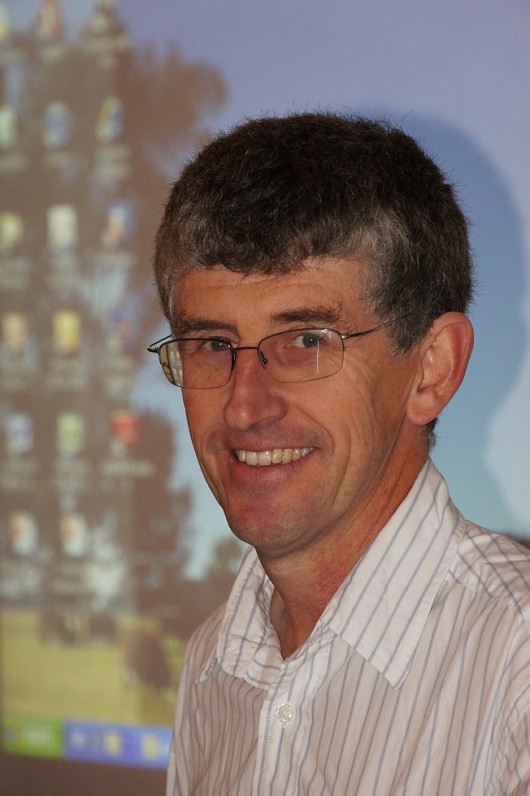 Dr Peter Fleming
Principal research scientist in the vertebrate pest research unit of Biosecurity NSW, Orange Dr Peter Fleming
Principal research scientist in the vertebrate pest research unit of Biosecurity NSW, Orange
.
“Right now, pressure is being brought to bear on livestock producers in some areas to reduce lethal control of all free-ranging dogs, because of potential environmental benefit of dingoes.
“We know wild dogs and sheep don’t mix and that strategic co-management is the best way to go for both conservation and agricultural goals. Community wild dog control programs in livestock production areas can suffer because of conflicting information about the roles of dingoes and the other free-ranging wild dogs.”
“However, our review shows we are unsure what the ecological roles are. The new research may yet demonstrate there are ecosystem services and net benefits of retaining free-ranging wild dogs to suppress foxes and feral cat impacts in some areas, but they will still need to be controlled for livestock protection,” Dr Fleming said.
To get to the bottom of the dingo mystery and to determine the ecological roles of free-ranging wild dogs in the many different ecosystems that make up Australia, the Invasive Animals CRC and its partners Meat & Livestock Australia and Australian Wool Innovation and have embarked on a five-year research program to enhance the nation’s ability to manage all their impacts.
A statement issued by the Invasive Animals CRC said this information was critical to manage this unique and charismatic predator in Australia – the dingo, while mitigating livestock losses.
Based at the University of New England and Biosecurity NSW, the research program will centre on north-eastern New South Wales and south-eastern Queensland, a biodiversity hotspot where livestock producers continue to suffer predation problems.
The UNE is currently receiving applications until February 15 for research PhDs to support the wild dog research team. Substantial Invasive Animals CRC resources are being devoted to the research, with up to eight PhD projects about native and introduced predators, their interactions with their prey, the plants the prey eats and the social and economic context of wild dog impacts.
“In five years’ time we will have a sound understanding of the relationships between the predators, prey, plants and people in the highly-productive north-east of NSW,” Dr Fleming said.
“In the meantime, the coordinated, strategic approach to managing free-ranging dogs and preventing livestock predation must continue,” he said.>>
[Source: ‘Long-term research aims to unravel the dingo mystery’, 20130129, Beef Central, ^http://www.beefcentral.com/p/news/article/2690]
.
Tags: Australia's native Dingo, Biosecurity NSW, dingo persecution, Dingo repopulation, feral predation, Invasive Animals CRC, managing free-ranging dogs, reintroducing top order predators, Vertebrate Pest Research Unit, Wild Dogs
Posted in Dingoes, Threats from Colonising Species, Threats from Poaching and Poisoning | 4 Comments »
Add this post to Del.icio.us - Digg
Wednesday, January 9th, 2013
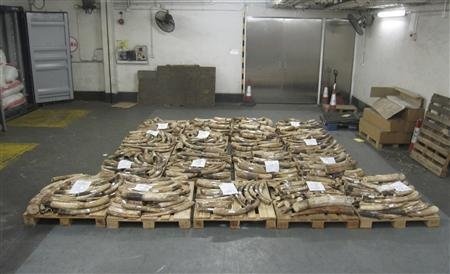 The tusks of 600 elephants seized in Hong Kong in October 2012 (just 3 months ago)
The tusks of 600 elephants seized in Hong Kong in October 2012 (just 3 months ago)
Street Value is $3.4M in illegal African ivory destined for Traditional Chinese Medicine
[Source: ^http://www.elephantjournal.com/2012/10/the-biggest-haul-of-ivory-tusk-in-hong-kong-customs-enforcement-history-in-a-single-operation/]
.
Illegal Wildlife Trade
[World Wildlife Fund, 2012, ^http://worldwildlife.org/threats/illegal-wildlife-trade]
.
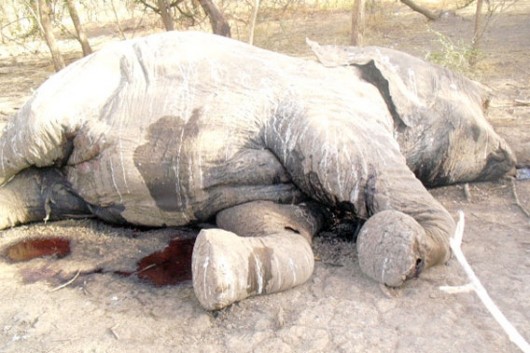 Elephant cruelly butchered for Traditional Chinese ‘Medicine’ (read ‘quackery’) Elephant cruelly butchered for Traditional Chinese ‘Medicine’ (read ‘quackery’)
.
<<The world is dealing with an unprecedented spike in illegal wildlife trade, threatening to overturn decades of conservation gains. Ivory estimated to weigh more than 23 metric tons—a figure that represents 2,500 elephants—was seized in the 13 largest seizures of illegal ivory in 2011. Poaching threatens the last of our wild tigers that number as few as 3,200.
Wildlife crime is a big business. Run by dangerous international networks, wildlife and animal parts are trafficked much like illegal drugs and arms. By its very nature, it is almost impossible to obtain reliable figures for the value of illegal wildlife trade. Experts at TRAFFIC, the wildlife trade monitoring network, estimate that it runs into hundreds of millions of dollars.
Some examples of illegal wildlife trade are well known, such as poaching of elephants for ivory and tigers for their skins and bones. However, countless other species are similarly overexploited, from marine turtles to timber trees. Not all wildlife trade is illegal. Wild plants and animals from tens of thousands of species are caught or harvested from the wild and then sold legitimately as food, pets, ornamental plants, leather, tourist ornaments and medicine. Wildlife trade escalates into a crisis when an increasing proportion is illegal and unsustainable—directly threatening the survival of many species in the wild.
Stamping out wildlife crime is a priority for WWF because it’s the largest direct threat to the future of many of the world’s most threatened species. It is second only to habitat destruction in overall threats against species survival.>>
.
Traditional Chinese ‘Medicine’ driving wicked Slaughter
.
The demand for elephant ivory is stronger than ever in mainland China and Thailand. Ivory is used in Traditional Chinese Medicine to treat fevers, nosebleeds, convulsions, stroke and as an aphrodisiac.
But TCM doesn’t work. It is quackery and witchcraft. It is immoral because it involves using and prescribing wildlife parts and drives the illegal cruel slaughter of endangered wildlife and its trafficking. TCM is wicked and backward. TCM needs to be internationaly banned just like cannibalism.
 TCM: ‘Timeless Wisdom for a Modern World”?
No, TCM has the same legitimacy as Cannibalism TCM: ‘Timeless Wisdom for a Modern World”?
No, TCM has the same legitimacy as Cannibalism
.
The following websites link to organisations pushing this TCM trade:
.
Panaxea International, ^http://www.panaxea.com/
Eu Yan Sang ^http://www.euyansang.com/
Sydney Institute of Traditional Chinese Medicine, ^http://www.sitcm.edu.au/
Chinese Medicine Board of Australia (Note: not a government body), ^http://www.chinesemedicineboard.gov.au/
Asante Academy of Chinese Medicine, ^http://asanteacademy.wordpress.com/2010/01/20/treating-cancer-with-chinese-medicine/
.
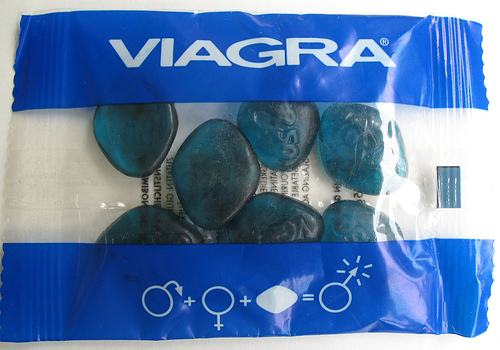 Works better than TCM – guaranteed! Works better than TCM – guaranteed!
.
Oct 2012: Hong Kong seizes $3.4M in illegal African Ivory
[Source: ‘Hong Kong seizes $3.4M in illegal African ivory’, by Associated Press (foreign), 20121020, The Guardian (Britain), ^http://www.guardian.co.uk/world/feedarticle/10492150]
.
<<Hong Kong customs officers have confiscated nearly 4 tons of ivory worth $3.4 million in their biggest ever seizure of endangered species products, authorities said on Saturday.
Acting on a tip from customs officials in neighboring Guangdong province in mainland China, Hong Kong officials found the ivory tusks and ornaments in two containers shipped from Tanzania and Kenya.
Officers on Tuesday found nearly 1,000 pieces of ivory tusks weighing more than 1,900 kg as well as 1.4 kg of ivory ornaments in a container from Tanzania. The ivory was hidden in bags of plastic scrap.
A day later, officers found 237 pieces of ivory tusks weighing about 1,900 kg in a shipment from Kenya.
Authorities in China have arrested seven people, including one from Hong Kong. The ivory seizure tops one in 2011 worth $2.2 million.
“This is the biggest haul of ivory tusk in Hong Kong customs enforcement history in a single operation,” said Lam Tak-fai, head of Hong Kong’s Ports and Maritime Command.
Wildlife activists blame China’s growing presence in Africa for an unprecedented surge in poaching elephants for their tusks, most of which are believed to be smuggled to China and Thailand to make ivory ornaments.
Under Hong Kong law, anyone found guilty of trading in endangered species products can be faces up to two years in prison and a fine of up to $640,000.>>
.
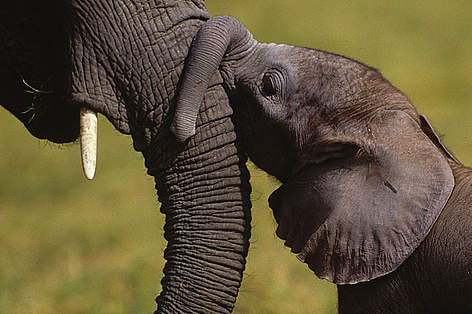 African savanna elephant and calf
(Loxodonta africana africana), Amboseli National Park, Kenya
Photo © Martin Harvey, World Wildlife Fund
^http://wwf.panda.org/about_our_earth/species/species_pictures/moms/ African savanna elephant and calf
(Loxodonta africana africana), Amboseli National Park, Kenya
Photo © Martin Harvey, World Wildlife Fund
^http://wwf.panda.org/about_our_earth/species/species_pictures/moms/
.
[Ed: No! Wildlife have existence rights just a humans. Mammalian Wildlife are sentient beings just as humans – Read: >The Cambridge Declaration on Consciousness 2012 (2 pages,PDF, 27 kb).
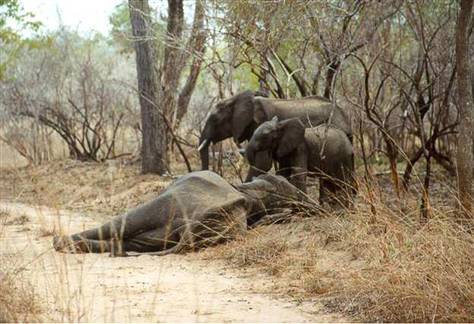 . .
Unlike humans, poached wildlife such as Elephants, Rhinoceroses, Bears and Tigers are increasingly approaching extinction as species. Genocide of humans falls short of speciescide, which should be put in perspective.
.
Wildlife Parts need to be valued as Human Parts. The Wildlife Parts Trade need to internationally attract the equivalent penalties as does the Human Parts Black Market by: (1) those who commit the barbaric slaughter, (2) by those traffic in wildlife parts, and (3) by those who use wildlife parts. Penalties need to be Life Imprisonment accordingly, and for corporations fines of up to US$1 million per animal and all corporate assets seized and the corporation wound up].
 Poor Victim of Organ Gangs
[Source: ^Bloomberg, 20111101] Poor Victim of Organ Gangs
[Source: ^Bloomberg, 20111101]
.
Jan 2013: ‘Poachers busted with 779 Elephant Tusks’
[Source: ‘Poachers Busted With Almost 800 Elephant Tusks’, by Andri Antoniades, TakePart (a social action website), 20130106, ^http://www.takepart.com/article/2013/01/06/blood-ivory-market-surges-activists-scramble-protect-elephants]
.
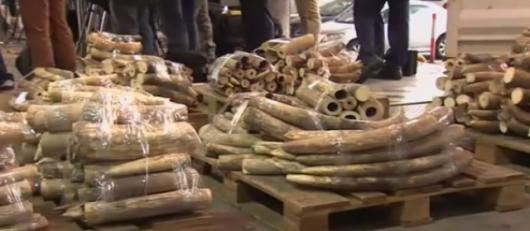 779 elephant tusks uncovered in Hong Kong shipping containers in January 2013 (just 3 days ago)
The crime is escalating!
The tusks discovered in Hong Kong this week were presumably going to be turned into jewelry, knicknacks, and religious icons.
(Photo: SkyNews.com/YouTube Screengrab) 779 elephant tusks uncovered in Hong Kong shipping containers in January 2013 (just 3 days ago)
The crime is escalating!
The tusks discovered in Hong Kong this week were presumably going to be turned into jewelry, knicknacks, and religious icons.
(Photo: SkyNews.com/YouTube Screengrab)
.
<<Last month, TakePart reported on some revolutionary new tactics that will be implemented in order to hinder the proliferation of the very lucrative poaching industry. Those efforts can’t come fast enough; this week, another massive shipment of blood ivory was discovered in Hong Kong, the shipping port’s third discovery of illegal ivory in as many months.
According to Sky News, this week customs agents discovered 779 elephant tusks hidden in the false bottoms of shipping crates, marked as “archaeological stones”. Worth about $1.5 million, this massive shipment from Kenya represents at least 389 elephant deaths, but doesn’t even qualify as the largest the port has seen in recent months.
Two previous shipments recently discovered were actually substantially larger, with the biggest topping out at 4 tonnes of elephant tusks, worth about $3.4 million. That was just in November.
Hong Kong’s port is a popular through-way for the poaching trade because it serves as the hub for Asian markets, where the demand for ivory is at the world’s highest. The tusks are not only used to make jewelry, but trinkets and religious icons for the Chinese, Japanese and Thai markets.
The poaching industry has recently exceeded record levels with animals like Elephants, Tigers and Rhinos being slaughtered by the hundreds across continents. The kill-methods represent a level of cruelty that’s so barbaric it seems the stuff of fictional villains. Nonetheless, knowledge of the industry’s brutality does nothing to dampen sales.
Activists estimate about $10 billion a year is made from poaching’s international black market.
According to National Geographic, these recently uncovered shipments of elephant tusks just scratch the surface of the damage caused by poaching in the last 12 months.
.
In 2012, 633 Rhinos were killed in South Africa (448 in 2011), their horns hacked off while they were still alive.
.
“Hundreds of thousands” of African Grey Parrots were shipped off for sale. Less than 300 Sumatran Rhinos are left and only four Northern White Rhinos remain in captivity.
Every year, approximately 25,000 Elephants are killed for their tusks, accounting for their disappearance from the African and Asian plains.
The magazine reports that China’s recent stronghold in Africa is fueling a resurgence in the poaching industry. The country’s presence there, where it funds roads, dams, and municipal
buildings makes it a major player on the continent, giving it the power and access to easily extract the illegal goods and ship them home.
As activist Steve Boyes wrote in his National Geographic piece on the subject,
.
“We are standing on the precipice of a mass extinction and Africa is just about to be lost forever.”
.
In the meantime, the World Wildlife Fund, in partnership with Google, is trying launch the wide-scale implementation of drone technology, which will covertly monitor poachers’ activity
from hundreds of feet in the air. The secret system would alert ground crews of oncoming danger and send them in to areas where poachers are detected. Part of the initiative also
includes research into DNA tracing capabilities, allowing authorities to definitively trace poached animal parts.>>
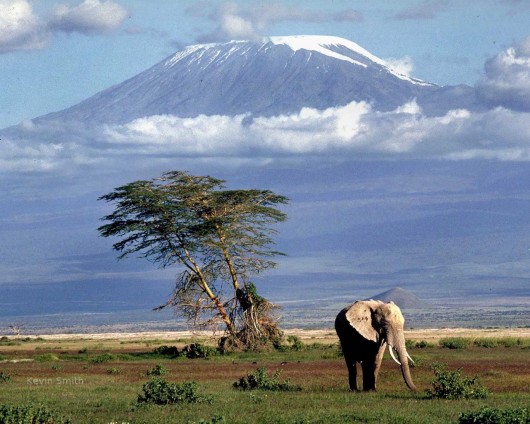 Plains below Kilimanjaro
(Source: Photo © Keven Smith,^http://www.naturepicoftheday.com/archive/2009-02-03)
(Click image to enlarge) Plains below Kilimanjaro
(Source: Photo © Keven Smith,^http://www.naturepicoftheday.com/archive/2009-02-03)
(Click image to enlarge)
.
Sep 2011: ‘794 Elephant Tusks Intercepted’
[Source: ‘794 elephant tusks intercepted’, 20110906, ^http://gbtimes.com/news/794-elephant-tusks-intercepted]
.
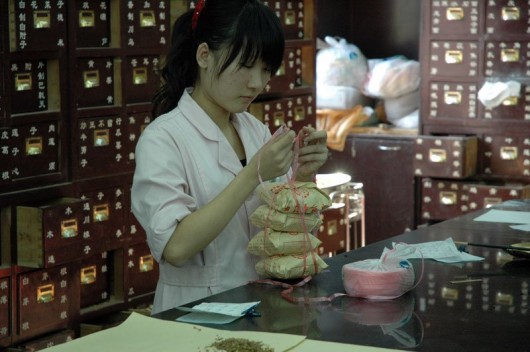 TCM Witchdoctoring in Wildlife Parts TCM Witchdoctoring in Wildlife Parts
.
<<Hong Kong officials intercepted 794 elephant tusks bound for mainland China from Malaysia.
The seizure comes in the wake of two other large shipments of African ivory being intercepted at the end of August by Malaysian officials.
Wildlife conservationalists have been struggling with the supply of ivory from illegal poachers in Africa paired with the demand in China. Ivory is often used for ornaments or for medicinal purposes, particularly in mainland China.
According to the International Centre for Trade and Sustainable Development, Malaysia is becoming a first choice as a transit country for the trade of African ivory to China.
Although being lauded for the August discovery of illegal ivory shipments, critics wonder why Malaysian officials were not able to stop this two metric tonne shipment.>>
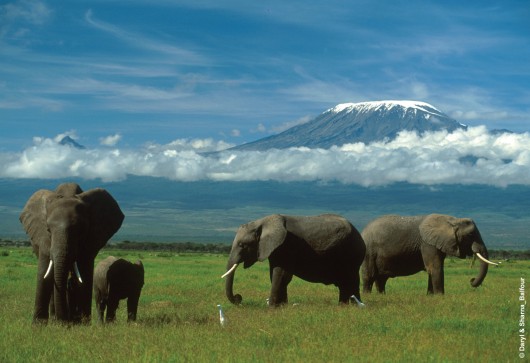 Africa’s Kilimanjaro and its native Elephants
(Source: Photo © Daryland and Sharna Balfour, ^http://www.awf.org/blog/wp-content/uploads/2011/01/Elephant-DarylandSharna_Balfour.jpg)
(Click image to enlarge) Africa’s Kilimanjaro and its native Elephants
(Source: Photo © Daryland and Sharna Balfour, ^http://www.awf.org/blog/wp-content/uploads/2011/01/Elephant-DarylandSharna_Balfour.jpg)
(Click image to enlarge)
.
Dec 2012: Rhino Horns increasingly targeted by TCM Poachers
[Source: ‘Coveting Horns, Ruthless Smugglers’ Rings Put Rhinos in the Cross Hairs’, by Jeffrey Gettleman and Gaia Pianigiani (New York Times), 20121231, ^http://www.nytimes.com/2013/01/01/world/africa/ruthless-smuggling-rings-put-rhinos-in-the-cross-hairs.html?pagewanted=all&_r=0]
.
<<KRUGER NATIONAL PARK, South Africa — They definitely did not look like ordinary big-game hunters, the stream of slender young Thai women who showed up on the veld wearing tight bluejeans and sneakers.
But the rhinoceros carcasses kept piling up around them, and it was only after dozens of these hulking, relatively rare animals were dead and their precious horns sawed off that an extravagant scheme came to light.
The Thai women, it ends up, were not hunters at all. Many never even squeezed off a shot. Instead, they were prostitutes hired by a criminal syndicate based 6,000 miles away in Laos to exploit loopholes in big-game hunting rules and get its hands on as many rhino horns as possible — horns that are now worth more than gold.
“These girls had no idea what they were doing,” said Paul O’Sullivan, a private investigator in Johannesburg who helped crack the case. “They thought they were going on safari.”
The rhino horn rush has gotten so out of control that it has exploded into a worldwide criminal enterprise, drawing in a surreal cast of characters — not just Thai prostitutes, but also Irish gangsters, Vietnamese diplomats, Chinese scientists, veterinarians, copter pilots, antiques dealers and recently an American rodeo star looking for a quick buck who used Facebook to find some horns.
Driven by a common belief in Asia that ground-up rhino horns can cure cancer and other ills, the trade has also been embraced by criminal syndicates that normally traffic drugs and guns, but have branched into the underground animal parts business because it is seen as “low risk, high profit,” American officials say.
“Get caught smuggling a kilo of cocaine, you will receive a very significant prison sentence,” said Ed Grace, a deputy chief with the United States Fish and Wildlife Service. But with a kilogram of rhino horn, he added, “you may only get a fine.”
The typical rhino horn is about two feet long and 10 pounds, much of it formed from the same substance as fingernails. Yet it can fetch nearly $30,000 a pound, more than crack cocaine, and conservationists worry that this “ridiculous price,” as one wildlife manager put it, could drive rhinos into extinction.
Gangs are so desperate for new sources of horn that criminals have even smashed into dozens of glass museum cases all across Europe to snatch them from exhibits.
“Astonishment and rage, that’s what we felt,” said Paolo Agnelli, a manager at the Florence Museum of Natural History, after three rhino horns were stolen last year, including a very rare one from 1824.
American federal agents recently staged a cross-country undercover rhino horn sting operation, called Operation Crash, “crash” being the term for a herd of rhinos.
Among the 12 people arrested: Wade Steffen, a champion steer wrestler from Texas, who pleaded guilty in May to trafficking dozens of horns that he found through hunters, estate sales and Facebook; and two members of an Irish gang — the same gang suspected of breaking into the museums in Europe.
In an e-mail to an undercover agent, an Irish gangster bragged: “Believe me WE NEVER LOSES A HORN TO CUSTOMS, we have so many contacts and people payed off now we can bring anything we want out of nearly any country into Europe.”
Corruption is a huge element, just like in the illegal ivory trade, in which rebel groups, government armies and threadbare hunters have been wiping out tens of thousands of elephants throughout Africa, selling the tusks to sophisticated criminal networks that move them across the globe with the help of corrupt officials.
Here in South Africa, home to the majority of the world’s last surviving 28,000 rhinos or so, the country is throwing just about everything it has to stop the slaughter — thousands of rangers, the national army, a new spy plane, even drones — but it is losing.
The number of rhinos poached in South Africa has soared in the past five years, from 13 killed in 2007 to more than 630 in 2012. The prehistoric, battleship-gray animals are often found on their knees, bleeding to death from a gaping stump on their face.
“Ever seen a dead rhino?” asked Philip Jonker, who works for a private security firm that has gone into wildlife protection. “It’s worse than going to a funeral.”
The only answer, some contend, is to legalize the trade, which would flood the market with rhino horns, lower the price and dissuade rhino poachers from risking their lives — or so the argument goes. Rhino horns regenerate, and the horns can be shaved down every few years and sold off without significantly hurting the animal.
One of most passionate advocates of this legalization movement is John Hume, a South African entrepreneur who now owns more than 800 rhinos, with names like Curly, Titan, Hillary and Pinocchio, and has amassed a 2,000-pound mountain of horn worth millions of dollars — if he is ever allowed to sell it.
“Why shouldn’t the person who breeds rhino get a reward?” he asks.
Every time Mr. Hume’s ranch hands trim down a few rhinos, they organize an armed escort to take the horns straight to a safe-deposit box in a bank because the same gangs that waylay armored bank trucks are now cruising around South Africa looking for Rhino horns.
But many wildlife groups say legalizing the rhino trade would be a disaster.
“The consuming power in my country is growing so rapidly that the supply would never meet the needs,” said Jeff He, spokesman for the Chinese branch of the International Fund for Animal Welfare. “And besides, it’ll always be cheaper to poach an animal than raise it.”
Kruger National Park, an enormous wildlife refuge in South Africa’s northeast, is where many rhinos are being poached. The park lies on the border with Mozambique, a much poorer country still scarred from years of civil war. Park rangers say Mozambican gunmen are pouring through Kruger’s chain link fences, downing rhinos left and right.
Some sophisticated poaching rings use helicopters to spot the animals and veterinarians to dart them with tranquilizers. Others don women’s shoes, to leave misleading tracks. “At any one time, there are up to 10 groups operating inside the Kruger,” said Ken Maggs, a South African National Parks official. “These guys are trying new methods daily.”
Scientists say that maybe a million rhinos once roamed the earth, and for some reason, humans have been fascinated with the horn for ages. The ancient Persians thought rhino horn vessels could detect poisons. The Chinese thought rhino horn powder could reduce fevers. The Yemenis prized the horn for coming-of-age daggers, presented to teenage boys as a sign of manhood.
In Asia, faith in traditional cures runs strong, fueling demand as Asian economies grow, though there is no scientific proof that rhino horn can cure cancer.
In 2008, a Vietnamese diplomat in South Africa’s capital, Pretoria, was caught on camera receiving Rhino horn — in the parking lot of the embassy. Around the same time, a Chinese company opened a secretive rhino breeding center in Hainan Province, reportedly to produce rhino-based medicine.
In the past 50 years, the overall rhino population has plummeted by more than 90 percent, despite an international ban on the trade in rhino parts since 1977.
But in South Africa, it is legal to hunt Rhinos, creating the loophole that the Thai prostitutes sauntered through. Hunters must agree to keep the horn set (rhinos have a large front and smaller back horn) as a trophy and not sell it, and hunters are allowed to kill only one White Rhino every 12 months. (Black rhinos are critically endangered and very few are hunted in South Africa.)
According to South African law enforcement officials, gang leaders in Thailand and Laos decided that to maximize the number of Rhinos they could kill, they would enlist Thai prostitutes who were already in South Africa with valid passports, which were used for the hunting permits. The women then tagged along on the hunts, often dressed in catchy pinks and blues, but somebody else — usually a professional hunter — pulled the trigger.
“I don’t know whose idea it was to use the ladies, but it was a damn good one,” said Mr. O’Sullivan, the private investigator.
None of the two dozen or so prostitutes involved have been prosecuted — the intent was to get the big fish. So Mr. O’Sullivan leaked a photograph of an enormous stockpile of ivory and rhino horns to one of the women, along with a message for her boss, a bespectacled Thai man named Chumlong Lemtongthai, that everything was for sale: “I wanted the big man himself to come here and negotiate.”
Mr. Lemtongthai did exactly that, and he was arrested soon after. He pleaded guilty and was sentenced in November to 40 years.
“I do not want to see a situation where my grandchildren will only be able to see rhino in a picture,” said the judge, Prince Manyathi.>>
.
Jan 2013: Vietnamese caught smuggling Rhino Horn
[Source: ‘Rhino Horn Trade: Thai Officials Catch Smuggler In Bangkok Airport’, 20130106, Huffington Post (America), ^http://www.huffingtonpost.com/2013/01/07/illegal-rhino-horn-trade-smuggling-thailand_n_2424428.html; ^http://www.bangkokpost.com/news/local/329675/rhino-horn-seized-in-bangkok-ho-chi-minh]
.
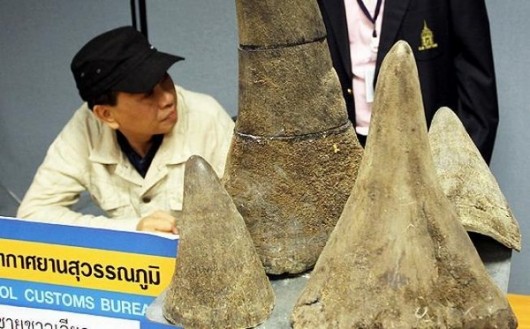 Seized rhino horns are shown with alleged Vietnam smuggler Pham Quang Loc, 56,
arrested at Suvarnabhumi airport when he arrived from Ethiopia on his way to Vietnam Seized rhino horns are shown with alleged Vietnam smuggler Pham Quang Loc, 56,
arrested at Suvarnabhumi airport when he arrived from Ethiopia on his way to Vietnam
.
<<BANGKOK — Thai authorities have seized more than $500,000 worth of rhino horn from passenger’s luggage at a Bangkok airport.
Thai Customs officer Khanit Isdul said Sunday that officials acting on a tip-off found four rhino horns in the passenger’s luggage at Suvarnabhumi International Airport. (‘They were allegedly hidden inside a souvenir hippo carried by Mr Loc.)
Officials arrested Phan Quangloc, a 56-year-old Vietnamese passenger who arrived with the case from Ethiopia on Sunday. He is expected to face a jail term in Thailand if convicted of smuggling. Officials estimated the value of the confiscated horns, cut into 6 sections, at 18 million baht ($586,000).
Asia is the main market for smuggled rhino horn, as some people believe it can cure diseases.
Trade in rhino parts is banned under international agreements.>>
.
Nov 2011: 366 Rhinos slaughtered for TCM since January
[Source: ‘Record rhino horn haul’, 20111116, by Candice Bailey and Shaun Smillie, IOL News, (from Reuters) ^http://www.iol.co.za/news/crime-courts/record-rhino-horn-haul-1.1179722#.UOxvi3fcDNE]
.
 Lam Tak-fai, acting head of (Hong Kong) Ports and Maritime Command, arranges Rhino horns,
part of a shipment of 33 horns, ivory chopsticks and bracelets seized by the Hong Kong Customs and Excise Department,
during a news conference in Hong Kong. Lam Tak-fai, acting head of (Hong Kong) Ports and Maritime Command, arranges Rhino horns,
part of a shipment of 33 horns, ivory chopsticks and bracelets seized by the Hong Kong Customs and Excise Department,
during a news conference in Hong Kong.
.
<<It could just be a new method used by syndicates to smuggle Rhino horn out of the country: bulk consignments, hidden in containers and sent by sea. But Rhino syndicates are not just using new smuggling routes, poachers also appear to be changing their tactics to target more animals.
On Monday, customs officials in Hong Kong discovered 33 Rhino horns that had been hidden in a container on a ship that had left Cape Town. They also seized 758 ivory chopsticks and 127 ivory bracelets, which they estimated was worth HK$ 17.4 million (R18.17m).
Customs officers had apparently selected the container “acting on risk assessment”. It was marked as carrying 63 packages of scrap plastic. Using X-ray equipment, they found the contraband hidden inside a package of plastic scrap that had been placed at the rear of the container. The 33 horns, which weighed 86kg, constitute nearly a tenth of the Rhinos poached in SA this year.
Dr Richard Thomas, the communications co-ordinator for Traffic International, said such a large seizure of Rhino horns was unusual. “Usually there are reports of one or two horns being smuggled out through the airports, I can’t think of such a shipment before,” he said.
Thomas said the Cape Town to Hong Kong sea route was usually used by perlemoen smugglers, and that Rhino horn syndicates might be using the same network.
What he suspected was that from Hong Kong the horn might be smuggled overland through China on to Vietnam, with its large market for rhino horn. There is also an active ivory-smuggling route between the two Far East countries. Two weeks ago, Vietnamese authorities seized a ton of ivory that had come from China.
South African Revenue Service spokesman Adrian Lackay said they had received news of the confiscation and had been in touch with the Hong Kong authorities.
“We will assist the foreign agencies with a local investigation if needed, because the goods came from South Africa,” he said.
Since January, 366 Rhinos have been killed across the country. Of those, the majority of the killings have been in the Kruger National Park, where 209 Rhinos were slain.
To date, 199 poachers have been arrested since January – compared to 165 arrested for last year. Thai nationals Chumlong Lemtongthai and Punpitak Chunchom are currently in court for exporting Rhino horn.
Lemtongthai, the syndicate’s alleged kingpin, used Thai prostitutes and strippers as bogus Rhino hunters. He would allegedly obtain legal trophy permits to shoot the Rhinos.
SANParks CEO Dr David Mabunda said that despite the higher number of Rhino killings this year, the number of incidents was declining. The reason was a change in modus operandi by the poachers. They were still using AK-47s and other heavy-calibre weapons and hacking off the horns. But poachers were attacking in larger groups than before, sometimes up to 16 armed members. Mabunda said the source of the Rhino horn in the container came from several parks: private and state owned. The bust showed the urgency for the DNA profiling of the Rhino, currently being done by the University of Pretoria.
It would tell where the Rhino had been killed, and once a horn could be linked to a carcass, a poacher could be charged with killing an endangered species. Killing an endangered species carries a heavier sentence than possession of Rhino horn.
Mabunda said they continued to work with the police and the SA National Defence Force, and at any time, there were between eight and 10 anti-poaching groups operating in the Kruger National Park.
The strengthening of the park’s law enforcement meant that crime was being displaced to other parts of the country. The hardest hit areas were Limpopo, Mpumalanga and rural areas of KwaZulu-Natal.>>
.
Jan 2013: 633 Rhinos slaughtered in 2012, just in South Africa
[Source: ‘Report will advise on legal trade in rhino horn’, 20130108, by Sue Blaine, Business Day, National/Science & Environment (South Africa), ^http://www.bdlive.co.za/national/science/2013/01/08/report-will-advise-on-legal-trade-in-rhino-horn]
.

<<FORMER home affairs director-general Mavuso Msimang, who has been set the task of researching ways of saving the rhino from poaching, is expected to report in the first quarter of this year. His report will also advise on whether South Africa should apply to trade in rhino horn under the Convention on International Trade in Endangered Species of Wild Flora and Fauna (CITES).
The trade issue has polarised many South Africans who have the rhino’s best interests at heart. Water and Environmental Affairs Minister Edna Molewa will have the unenviable task of deciding whether South Africa should apply to trade in rhino horn.
Although South Africa will not be making any proposal on trade until 2016’s Cites meeting, there will be discussion on Kenya’s recent proposal to the international body that a trophy-hunting moratorium be placed on South African white rhinos, says Southern African Development Community rhino management group chairman Mike Knight.
The proposal will be considered at the Cites Conference of Parties in Bangkok in March. If approved, the moratorium will be instituted until 2019, says Lion Aid founder Pieter Kat.
Mr Kat says Kenya argues that despite progress made by South Africa in instituting more demanding control measures, rhino poaching continues to rise.
Controls include the development of an electronic database for licence applications, mandatory registration of existing rhino horn stockpiles, bilateral treaties to improve law enforcement, increasing penalties and improving the gathering of intelligence.
“Kenya is of the opinion that such poaching has resonated across borders and that the recent upsurge in rhinos poached in Kenya is directly linked to a problem made in South Africa,” Mr Kat says.
Mr Knight says that integral to the Kenyan proposal is that countries such as South Africa and Zimbabwe, and countries where rhino horn is sought after such as China and Vietnam, should respond to its proposal.
It is agreed that South Africa is not winning the war on rhino poaching. The country lost a record 633 rhinos between January 1 and December 19 last year. The previous record, for 2011, was 448. Already two rhinos have been slain in the first week of 2013.
Arrests have increased and sentences for the convicted are harsher. South Africa also signed a long-awaited memorandum of understanding with Vietnam in mid-December. The agreement aims to curb rhino poaching.
South Africa is home to more than 80% of the global population, and scientists have warned that if poaching increases at the same rate as it did between 2009 and 2011, when the tally jumped from 122 to 448, just more than a threefold increase, the species will be extinct by mid-century. It could go into decline by 2016.
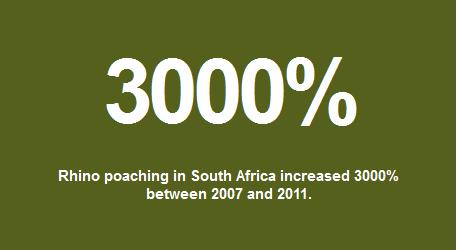
Conservationists see Vietnam as key to curbing the poaching that feeds the illegal horn trade. The country, a known destination for much of the illegal rhino horn poached in South Africa, posted the highest wildlife crime score in the World Wide Fund (WWF) for Nature’s 2012 Wildlife Crime Scorecard report.
Rhino horn, prized in Vietnam as a “pick-me-up”, cancer cure and even an aphrodisiac, fetches about $60,000/kg in the Southeast Asian country.
The agreement that Ms Molewa and Vietnamese Agriculture and Rural Development Minister Cao Duc Phat signed last month refers only in general terms to addressing illegal wildlife smuggling.
However, there were “clear indications” that rhino horn trafficking would be “top of the new agenda on co-operation between the two nations”, WWF-SA said immediately after the memorandum was signed.
Mr Knight says it is likely South Africa will turn more to technology to help it fight rhino poachers, with the possible use of “unmanned aerial vehicles”, or “drones”.>>
.
Rhino Conservation
[Source: ‘Rhino Conservation’, World Wildlife Fund (South Africa), ^http://www.wwf.org.za/act_now/rhino_conservation/]
.
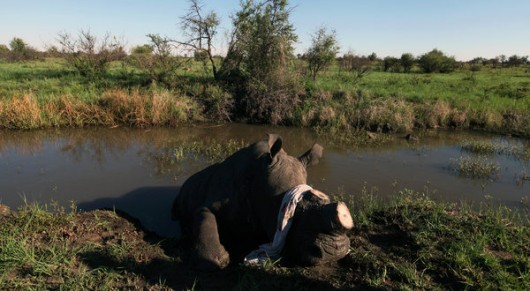 Rhinoceros de-horned to save it from TCM poaching Rhinoceros de-horned to save it from TCM poaching
.
WWF urges South Africans to be proud of their Rhino heritage on World Rhino Day (22 September).
More than 75% of all the world’s Rhino today are found in South Africa.
Rhinos have ranged far and wide across Africa and formed a magnificent part of our cultural and natural heritage for thousands of years. Long before becoming part of the iconic Big Five, rhinos were revered by African royalty as epitomised by the Golden Rhino buried with the King of Mapungubwe 800 years ago. South Africans are rightly proud of their rhino history and the critical role they played in the remarkable recovery of white rhino numbers over the last century. Today three out of every four rhinos alive are found in this one country.
.
Yet, rhino deaths from poaching continue to rise. As of 16 October 2012, 455 rhinos have been illegally killed for their horns this year.
.
Rhino numbers continue to grow as more are born than are dying – even when poaching mortalities are taken into account. However, we are coming ever closer to the danger zone where populations start to decline. WWF urges all South Africans to play a part in rhino protection at this pivotal point in their future. Report threats to rhinos or any signs of suspicious behaviour on the Department of Environmental Affairs Rhino Hotline.
.
What does WWF do to help rhinos?
.
On Rhino Day 2012, WWF-SA launched its new National programme to strengthen and support rhino conservation efforts in South Africa in response to the dramatic increase in cases of rhino poaching. Conservation activities will be based around a new five-point strategic framework to combat the threats to rhinos.
The five key areas are:
- Continuing the protection of key rhino populations and creating new resilient populations in South Africa through our Black Rhino Range Expansion Project (BRREP)
- Developing buffers in local communities around rhinos as the first critical line of defence
- Supporting and tightening proactive law enforcement efforts to break illegal trade chains
- Improving co-operation between South Africa and consumer countries
- Understanding rhino horn trade in end-user markets and influencing demand
We are working with our colleagues in Vietnam to develop tactics to shift new markets and new uses leading to increased demand for rhino horn.
During the first week of October, BRREP translocated a further thirteen black rhino from Ezemvelo KZN Wildlife reserves to another property in northern KwaZulu-Natal.>>
 Black Rhino
(Photo byJeff McNeely) Black Rhino
(Photo byJeff McNeely)
.
“10 percent of any population is cruel, no matter what, and 10 percent is merciful, no matter what, and the remaining 80 percent can be moved in either direction.”
~ Susan Sontag (1933-2004)
.
Further Reading:
.
[1] World Rhino Day, 22 September , ^http://www.worldrhinoday.org/
.
[2] Convention on International Trade in Endangered Species of Wild Fauna and Flora, ^http://www.cites.org/
.
[3] TRAFFIC: The Wildlife Trade Monitoring Network, World Wildlife Fund, ^http://worldwildlife.org/initiatives/traffic-the-wildlife-trade-monitoring-network
.
[4] TRAFFIC: The Wildlife Trade Monitoring Network, ^http://www.traffic.org/
.
[5] SOS Elephants, ^http://www.soselephants.org/
.
[6] Cambridge Declaration On Consciousness, Francis Crick Memorial Conference, (Cambridge, England, 20120707, ^http://fcmconference.org/img/CambridgeDeclarationOnConsciousness.pdf
.
[7] African Wildlife Foundation, ^http://www.awf.org/
.
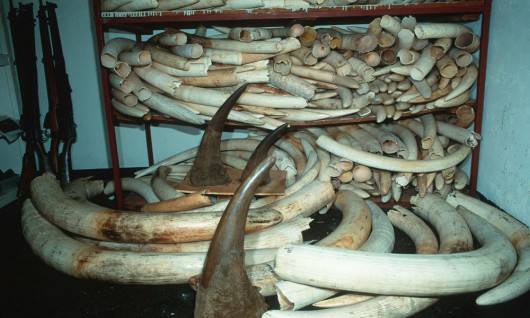 <<Illegal and/or unsustainable wildlife trade can cause a species to reach a point where its survival hangs in the balance. In fact, illegal wildlife trade is one of the main reasons that many species are endangered. <<Illegal and/or unsustainable wildlife trade can cause a species to reach a point where its survival hangs in the balance. In fact, illegal wildlife trade is one of the main reasons that many species are endangered.
For example, Rhino poaching to fuel to demand for the illegal Rhino horn trade reached an all-time high in 2011, with 448 Rhinos poached in South Africa alone. This could unravel years of conservation success with African Rhinos.>>
[Source: World Wildlife Fund, ^http://worldwildlife.org/initiatives/traffic-the-wildlife-trade-monitoring-network]
.
Tags: African Elephant, elephant poaching, illegal ivory trade, illegal wildlife trade, International Rhino Day, Rhino Horn, Rhinoceros, TCM witchdoctor cult, Traditional Chinese Medicine
Posted in Elephants, Rhinoceroses, Threats from Poaching and Poisoning | No Comments »
Add this post to Del.icio.us - Digg
|
|
 Illegal poachers caught in the Blue Mountains World Heritage Area on 15th June 2013
[Photo by bushwalker Darren Drew in Tigersnake Canyon, Wollemi National Park, at a time when 500 runners were participating in a marathon in the area]
Illegal poachers caught in the Blue Mountains World Heritage Area on 15th June 2013
[Photo by bushwalker Darren Drew in Tigersnake Canyon, Wollemi National Park, at a time when 500 runners were participating in a marathon in the area]
 Photo by High & Wild
Photo by High & Wild
 Glow Worm Tunnel Area, Wollemi National Park
Greater Blue Mountains World Heritage Area
[Source: NSW Government, ^http://www.environment.nsw.gov.au/nationalparks/parkWalking.aspx?id=N0051]
Glow Worm Tunnel Area, Wollemi National Park
Greater Blue Mountains World Heritage Area
[Source: NSW Government, ^http://www.environment.nsw.gov.au/nationalparks/parkWalking.aspx?id=N0051]
 Weekend Warriors
all camoued up and ready to hunt!
Weekend Warriors
all camoued up and ready to hunt!
 Game Council Code of Practice:
“Use of (pig) dogs: Dogs and other animals may be used to assist hunters, but only if:
Game Council Code of Practice:
“Use of (pig) dogs: Dogs and other animals may be used to assist hunters, but only if:
 National Park’s chief custodian Environment Minister Robyn Parker,
with NSW Premier Barry O’Farrell and Primary Industries Minister Katrina Hodgkinson
announcing that shooting will be legal in national parks.
[Source: Photo by Craig Greenhill, The Daily Telegraph]
National Park’s chief custodian Environment Minister Robyn Parker,
with NSW Premier Barry O’Farrell and Primary Industries Minister Katrina Hodgkinson
announcing that shooting will be legal in national parks.
[Source: Photo by Craig Greenhill, The Daily Telegraph]
 Blue Mountains protest campaign against the NSW Government’s local representative, Roza Sage MP,
and her undemocratic support for hunting in national parks across New South Wales.
Blue Mountains protest campaign against the NSW Government’s local representative, Roza Sage MP,
and her undemocratic support for hunting in national parks across New South Wales.
 No Hunting in National Parks Rally at Katoomba
[Photo by Editor 20120715, photo © under ^Creative Commons]
No Hunting in National Parks Rally at Katoomba
[Photo by Editor 20120715, photo © under ^Creative Commons]
 Conservation Hunting
Conservation Hunting Game Council’s acting chief executive, Greg McFarland
is currently the subject of continuing investigations
[Source: ‘Game Council to be abolished’, 20130704, by Sean Nicholls, Sydney Morning Herald State Political Editor
Game Council’s acting chief executive, Greg McFarland
is currently the subject of continuing investigations
[Source: ‘Game Council to be abolished’, 20130704, by Sean Nicholls, Sydney Morning Herald State Political Editor The Hunting Party
(Photo by Louie Eroglu)
The Hunting Party
(Photo by Louie Eroglu)
 Shooters Party, Robert Borsak with his Big Game kill
~ an African Bull elephant shot on safari in Zimbabwe in June 2008.
[Source: ABC Four Corners, ^http://www.abc.net.au/news/2013-06-11/nsw-mp-robert-borsak-with-an-elephant-shot-on/4745476]
Shooters Party, Robert Borsak with his Big Game kill
~ an African Bull elephant shot on safari in Zimbabwe in June 2008.
[Source: ABC Four Corners, ^http://www.abc.net.au/news/2013-06-11/nsw-mp-robert-borsak-with-an-elephant-shot-on/4745476]






















 An example of a purpose-built Wombat Gate
If one can afford property at exclusive Mount Wilson with average prices currently $750,000 [^
An example of a purpose-built Wombat Gate
If one can afford property at exclusive Mount Wilson with average prices currently $750,000 [^









































































